Microsoft RH-68 GSM 850/1800/1900 Cellular Telephone User Manual Manual
Microsoft Mobile Oy GSM 850/1800/1900 Cellular Telephone Manual
Manual
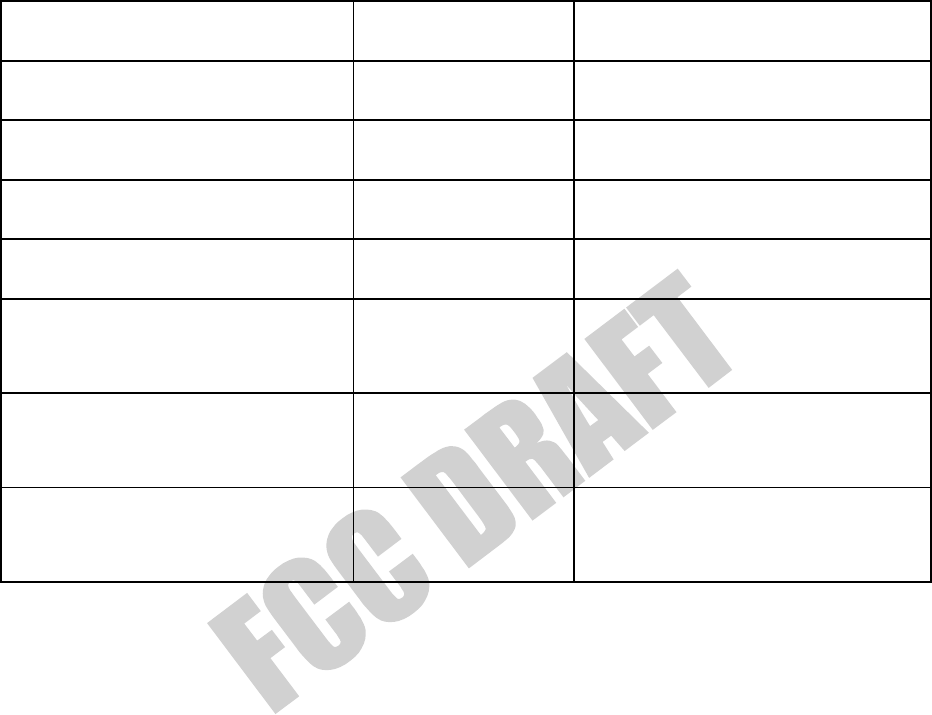
Nokia 6670 User Guide i Copyright © 2004 Nokia
Nokia 6670 User Guide
Phone information Numbers Where is the number?
My number Wireless service provider
Voice mail number Wireless service provider
Wireless provider’s number Wireless service provider
Provider’s customer care Wireless service provider
Model number Label on back of phone (under
battery)
Type number Label on back of phone (under
battery)
IMEI number Label on back of phone (under
battery)

ii Copyright © 2004 Nokia
NOTES
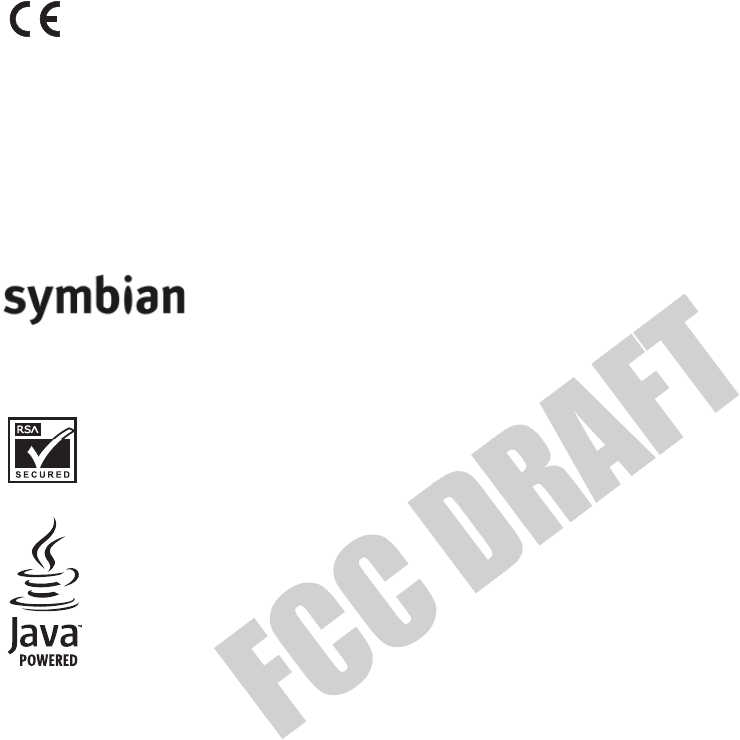
Nokia User Guide LLL Copyright © 2004 Nokia
LEGAL INFORMATION
DECLARATION OF CONFORMITY
We, NOKIA CORPORATION declare under our sole responsibility that the products RH-67 and RH-68
are in conformity with the provisions of the following Council Directive: 1999/5/EC. A copy of the
Declaration of Conformity can be found at http://www.nokia.com/phones/declaration_of_conformity
PART NO. XXXXXXX, ISSUE NO. 1
Copyright © 2004 Nokia. All rights reserved.
Nokia, Nokia 6670, Nokia Connecting People, Pop-Port, and the Nokia Original Enhancements logos
are trademarks or registered trademarks of Nokia Corporation. Other company and product names
mentioned herein may be trademarks or trade names of their respective owners.
Printed ???????? 2004
This product includes software licensed from Symbian Software Ltd. © 1998-2004. Symbian and
Symbian OS are trademarks of Symbian Ltd.
Includes RSA BSAFE cryptographic or security protocol software from RSA Security.
Java and all Java-based marks are trademarks of Sun Microsystems, Inc.
US Patent No 5818437 and other pending patents. T9 text input software Copyright (C) 1997-2003.
Tegic Communications, Inc. All rights reserved.
Bluetooth is a registered trademark of Bluetooth SIG, Inc.
USE OF THIS PRODUCT IN ANY MANNER THAT COMPLIES WITH THE MPEG-4 VISUAL STANDARD IS
PROHIBITED, EXCEPT FOR USE DIRECTLY RELATED TO (A) DATA OR INFORMATION (i) GENERATED BY
AND OBTAINED WITHOUT CHARGE FROM A CONSUMER NOT THEREBY ENGAGED IN A BUSINESS
ENTERPRISE, AND (ii) FOR PERSONAL USE ONLY; AND (B) OTHER USES SPECIFICALLY AND
SEPARATELY LICENSED BY MPEG LA, L.L.C.
The information contained in this user guide was written for the Nokia 6670 product. Nokia operates
a policy of ongoing development. Nokia reserves the right to make changes to any of the products
described in this document without prior notice.
168

iv Copyright © 2004 Nokia
UNDER NO CIRCUMSTANCES SHALL NOKIA BE RESPONSIBLE FOR ANY LOSS OF DATA OR INCOME OR
ANY SPECIAL, INCIDENTAL, AND CONSEQUENTIAL OR INDIRECT DAMAGES HOWSOEVER CAUSED. THE
CONTENTS OF THIS DOCUMENT ARE PROVIDED "AS IS." EXCEPT AS REQUIRED BY APPLICABLE LAW, NO
WARRANTIES OF ANY KIND, EITHER EXPRESS OR IMPLIED, INCLUDING, BUT NOT LIMITED TO, THE
IMPLIED WARRANTIES OF MERCHANTABILITY AND FITNESS FOR A PARTICULAR PURPOSE, ARE MADE
IN RELATION TO THE ACCURACY AND RELIABILITY OR CONTENTS OF THIS DOCUMENT. NOKIA RESERVES
THE RIGHT TO REVISE THIS DOCUMENT OR WITHDRAW IT AT ANY TIME WITHOUT PRIOR NOTICE.
EXPORT CONTROLS
This device may contain commodities, technology or software subject to export laws and regulations
from the US and other countries. Diversion contrary to law is prohibited.
FCC/INDUSTRY CANADA NOTICE
Your device may cause TV or radio interference (for example, when using a telephone in close
proximity to receiving equipment). The FCC or Industry Canada can require you to stop using your
telephone if such interference cannot be eliminated. If you require assistance, contact your local
service facility. This device complies with part 15 of the FCC rules. Operation is subject to the
condition that this device does not cause harmful interference.
Manufactured or sold under one or more of the following US patents:
4868846 4945633 5001372 5101175 5151946 5173927 5212834 5230091
5241583 5311151 5317283 5331638 5335362 5353328 5371481 5378935
5384782 5396657 5400949 5416435 5442521 5446364 5479476 5526366
5553125 5557639 5565821 5570369 5581244 5600708 5625274 5677620
5692032 5729541 5760568 5794142 5802465 5809413 5827082 5839101
5844884 5845219 5870683 5884103 5889770 5907823 5912570 5914690
5914796 5917868 5920826 5956332 5956625 5956633 5966378 5977887
5987137 5991857 6006114 6011853 6014551 6014573 6026161 6035189
6038238 6043760 6047196 6049796 6050415 6055439 6060193 6069923
6072787 6081732 6084920 6084962 6094587 6097964 6105784 6112099
6115617 6119180 6121846 6128509 6138091 6140966 6144243 6144676
6148209 6151485 6151507 6163609 6164547 6167248 6185295 6188909
6249584 6259312 6266330 6272361 6282436 6292668 6295286 6311054
6314166 6324389 6324412 6347218 6363259 6370362 6370389 6377820
6381468 6392660 6400958 6453179 6463278 6470470 6487397 6522670
6198928 4969192 5266782 5390223 5444816 5487084 5640395 5664053
5699482 5701392 5722074 5754976 5805301 5835889 5857151 5859843
5862178 5898925 5930233 5946651 5960354 5960389 5963901 6005857
6011971 6031827 6118775 6128322 6137789 6167248 6170073 6178535
6195338 6199035 6240076 6266321 6285888 6356759 6377803 6430163
6438370 6456237 RE32580 5818437 5953541 6011554 4558302
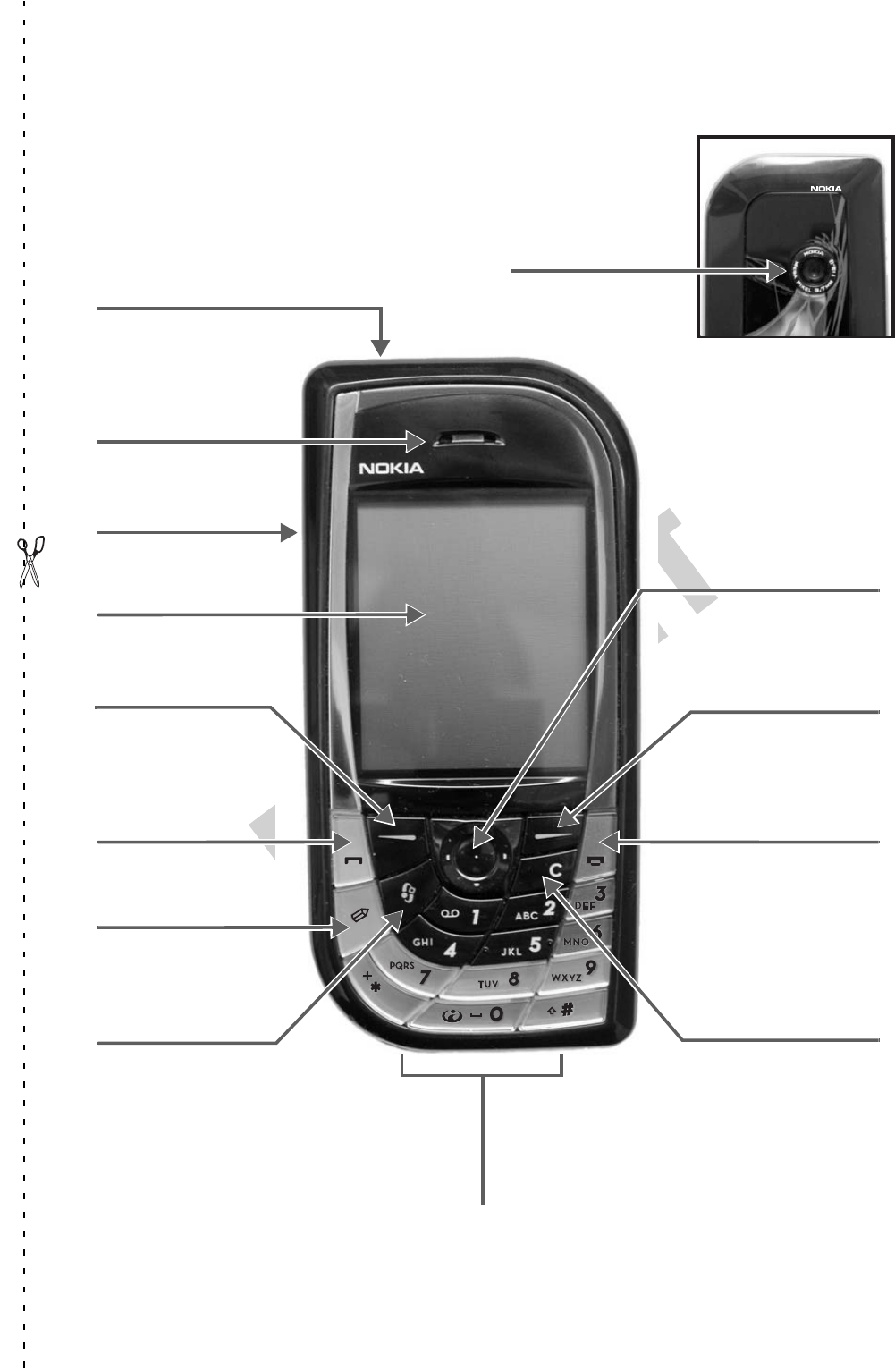
Nokia User Guidev Copyright © 2004 Nokia
Nokia 6670 phone at a glance
Send key End key
Power key (on top)
Charger connector, Pop-Port™ connector,
and microphone (on bottom)
Five-way scroll key
Left selection key
Menu key
Edit key
Clear key
Right selection key
Display
Earpiece
Camera lens
Note: The internet symbol
appear on all phones.
on the 0 key does not
Speaker (on side)
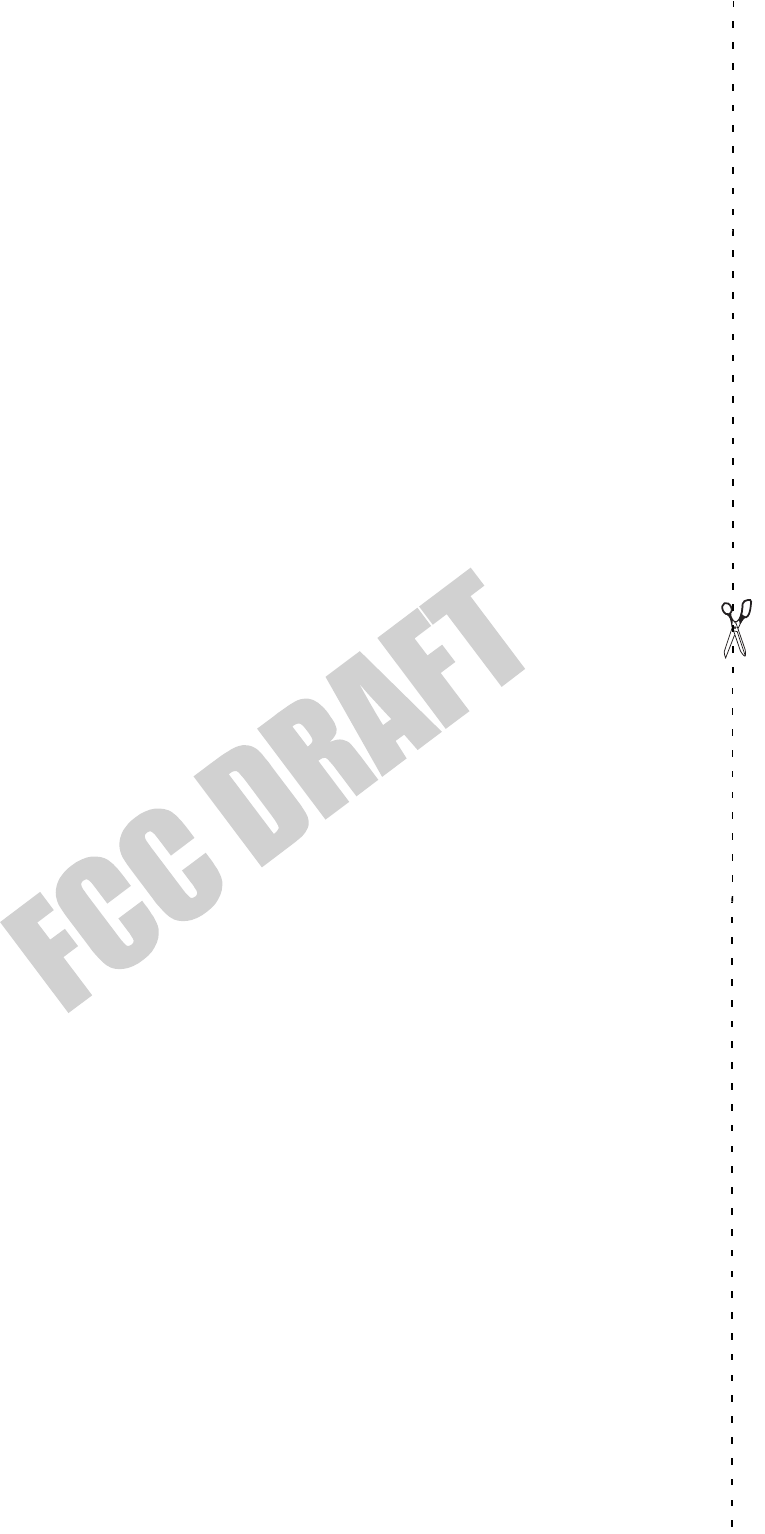
vi Copyright © 2004 Nokia
Quick guide
Make a call Enter a phone number, and press the Send key.
Answer a call Press the Send key.
Answer call during call Select Options > Answer, or press the Send key.
End a call Press the End key.
Decline a call Press the End key.
Mute a call Select Options > Mute during a call.
Redial Press the Send key twice.
Adjust call volume Scroll left or right with the Scroll key during a call.
Use the in-call menu Select Options during a call.
Save a name and number Enter a number, select Options > Add to contacts >
Create new, choose a category, enter a name, and select
Done. See "Write text," p. 44.
Look up a name Select Menu > Contacts, and in the search field at the
bottom of the screen, key in the first letters of the name
you want to find.
Use 1-touch dialing Press and hold a key (2–9). You must assign a key to a
number in Contacts. See "Assign 1-touch dialing keys,"
p. 26.
Check voice mail Press and hold the 1 key (contact your service provider
for details).
Write and send text
messages
Select Menu > Messaging > New message > Text
message. Enter the recipient in the To field. Enter the text
message, and select Options > Send.
Send a picture Capture a picture, allow the picture time to save, and
then select Options > Send > Via multimedia. Enter the
recipient in the To field. Enter the text message, and
select Options > Send.
Read a new message If a new message arrives, select Show to display
the message.
Press Press a key briefly and release it.
Press and hold Press and hold a key for 2 to 3 seconds and release it.

Nokia User Guidevii Copyright © 2004 Nokia
Contents
1 For your safety . . . . . . . . . . . . . . . . . . . . . . . . . . . . . . . . . . . . . . . 1
About your phone . . . . . . . . . . . . . . . . . . . . . . . . . . . . . . . . . . . . . . . . . . . . . . . . . . . 2
Network services . . . . . . . . . . . . . . . . . . . . . . . . . . . . . . . . . . . . . . . . . . . . . . . . . . . . 2
Shared memory . . . . . . . . . . . . . . . . . . . . . . . . . . . . . . . . . . . . . . . . . . . . . . . . . . . . . 3
2 General information . . . . . . . . . . . . . . . . . . . . . . . . . . . . . . . . . . . 4
Register your phone. . . . . . . . . . . . . . . . . . . . . . . . . . . . . . . . . . . . . . . . . . . . . . . . . . 4
E-newsletters . . . . . . . . . . . . . . . . . . . . . . . . . . . . . . . . . . . . . . . . . . . . . . . . . . . . . . . 4
Follow graphic clues . . . . . . . . . . . . . . . . . . . . . . . . . . . . . . . . . . . . . . . . . . . . . . . . . 4
Find the phone label . . . . . . . . . . . . . . . . . . . . . . . . . . . . . . . . . . . . . . . . . . . . . . . . . 5
Contact Nokia . . . . . . . . . . . . . . . . . . . . . . . . . . . . . . . . . . . . . . . . . . . . . . . . . . . . . . 5
Accessibility solutions . . . . . . . . . . . . . . . . . . . . . . . . . . . . . . . . . . . . . . . . . . . . . . . . 6
3 Getting started. . . . . . . . . . . . . . . . . . . . . . . . . . . . . . . . . . . . . . . 7
Remove the back cover . . . . . . . . . . . . . . . . . . . . . . . . . . . . . . . . . . . . . . . . . . . . . . . 7
Insert the SIM card . . . . . . . . . . . . . . . . . . . . . . . . . . . . . . . . . . . . . . . . . . . . . . . . . . 7
Insert the memory card . . . . . . . . . . . . . . . . . . . . . . . . . . . . . . . . . . . . . . . . . . . . . . . 8
Insert the battery . . . . . . . . . . . . . . . . . . . . . . . . . . . . . . . . . . . . . . . . . . . . . . . . . . . . 9
Charge the battery. . . . . . . . . . . . . . . . . . . . . . . . . . . . . . . . . . . . . . . . . . . . . . . . . . . 9
Switch the phone on or off . . . . . . . . . . . . . . . . . . . . . . . . . . . . . . . . . . . . . . . . . . . 10
Attach the wrist strap . . . . . . . . . . . . . . . . . . . . . . . . . . . . . . . . . . . . . . . . . . . . . . . 10
Tips on efficient operation . . . . . . . . . . . . . . . . . . . . . . . . . . . . . . . . . . . . . . . . . . . 10
If the phone requests a PIN code . . . . . . . . . . . . . . . . . . . . . . . . . . . . . . . . . . . . . . 10
If the phone requests a lock code. . . . . . . . . . . . . . . . . . . . . . . . . . . . . . . . . . . . . . 10
Set the time and date . . . . . . . . . . . . . . . . . . . . . . . . . . . . . . . . . . . . . . . . . . . . . . . 11
Make a call . . . . . . . . . . . . . . . . . . . . . . . . . . . . . . . . . . . . . . . . . . . . . . . . . . . . . . . . 11
Standby mode . . . . . . . . . . . . . . . . . . . . . . . . . . . . . . . . . . . . . . . . . . . . . . . . . . . . . 11
Icons . . . . . . . . . . . . . . . . . . . . . . . . . . . . . . . . . . . . . . . . . . . . . . . . . . . . . . . . . . . . . 12
Menu. . . . . . . . . . . . . . . . . . . . . . . . . . . . . . . . . . . . . . . . . . . . . . . . . . . . . . . . . . . . . 13
Options lists . . . . . . . . . . . . . . . . . . . . . . . . . . . . . . . . . . . . . . . . . . . . . . . . . . . . . . . 15
Common actions for all applications . . . . . . . . . . . . . . . . . . . . . . . . . . . . . . . . . . . 15
Search for items. . . . . . . . . . . . . . . . . . . . . . . . . . . . . . . . . . . . . . . . . . . . . . . . . . . . 16
Volume control. . . . . . . . . . . . . . . . . . . . . . . . . . . . . . . . . . . . . . . . . . . . . . . . . . . . . 16

viii Copyright © 2004 Nokia
Loudspeaker. . . . . . . . . . . . . . . . . . . . . . . . . . . . . . . . . . . . . . . . . . . . . . . . . . . . . . . .17
Keyguard . . . . . . . . . . . . . . . . . . . . . . . . . . . . . . . . . . . . . . . . . . . . . . . . . . . . . . . . . .17
4 Your phone. . . . . . . . . . . . . . . . . . . . . . . . . . . . . . . . . . . . . . . . . 18
Make a call . . . . . . . . . . . . . . . . . . . . . . . . . . . . . . . . . . . . . . . . . . . . . . . . . . . . . . . .18
Answer a call. . . . . . . . . . . . . . . . . . . . . . . . . . . . . . . . . . . . . . . . . . . . . . . . . . . . . . .20
Call log. . . . . . . . . . . . . . . . . . . . . . . . . . . . . . . . . . . . . . . . . . . . . . . . . . . . . . . . . . . .21
5 Personal information . . . . . . . . . . . . . . . . . . . . . . . . . . . . . . . . . 24
Contacts . . . . . . . . . . . . . . . . . . . . . . . . . . . . . . . . . . . . . . . . . . . . . . . . . . . . . . . . . .24
Presence (network service). . . . . . . . . . . . . . . . . . . . . . . . . . . . . . . . . . . . . . . . . . . .27
Positioning (network service). . . . . . . . . . . . . . . . . . . . . . . . . . . . . . . . . . . . . . . . . .31
Calendar . . . . . . . . . . . . . . . . . . . . . . . . . . . . . . . . . . . . . . . . . . . . . . . . . . . . . . . . . .31
To-do . . . . . . . . . . . . . . . . . . . . . . . . . . . . . . . . . . . . . . . . . . . . . . . . . . . . . . . . . . . . .33
Copy content from compatible Nokia phones . . . . . . . . . . . . . . . . . . . . . . . . . . . .33
6 Multimedia. . . . . . . . . . . . . . . . . . . . . . . . . . . . . . . . . . . . . . . . . 34
Camera. . . . . . . . . . . . . . . . . . . . . . . . . . . . . . . . . . . . . . . . . . . . . . . . . . . . . . . . . . . .34
View images . . . . . . . . . . . . . . . . . . . . . . . . . . . . . . . . . . . . . . . . . . . . . . . . . . . . . . .37
Player . . . . . . . . . . . . . . . . . . . . . . . . . . . . . . . . . . . . . . . . . . . . . . . . . . . . . . . . . . . . .38
Movie director. . . . . . . . . . . . . . . . . . . . . . . . . . . . . . . . . . . . . . . . . . . . . . . . . . . . . .39
Gallery . . . . . . . . . . . . . . . . . . . . . . . . . . . . . . . . . . . . . . . . . . . . . . . . . . . . . . . . . . . .40
7 Messaging . . . . . . . . . . . . . . . . . . . . . . . . . . . . . . . . . . . . . . . . . 43
Write text . . . . . . . . . . . . . . . . . . . . . . . . . . . . . . . . . . . . . . . . . . . . . . . . . . . . . . . . .44
Write and send messages. . . . . . . . . . . . . . . . . . . . . . . . . . . . . . . . . . . . . . . . . . . . .47
View a multimedia presentation . . . . . . . . . . . . . . . . . . . . . . . . . . . . . . . . . . . . . . .48
Inbox—receive messages . . . . . . . . . . . . . . . . . . . . . . . . . . . . . . . . . . . . . . . . . . . . .48
My folders . . . . . . . . . . . . . . . . . . . . . . . . . . . . . . . . . . . . . . . . . . . . . . . . . . . . . . . .50
Remote mailbox (network service) . . . . . . . . . . . . . . . . . . . . . . . . . . . . . . . . . . . . .50
Outbox . . . . . . . . . . . . . . . . . . . . . . . . . . . . . . . . . . . . . . . . . . . . . . . . . . . . . . . . . . . .52
View messages on a SIM card . . . . . . . . . . . . . . . . . . . . . . . . . . . . . . . . . . . . . . . . .52
Cell broadcast (network service) . . . . . . . . . . . . . . . . . . . . . . . . . . . . . . . . . . . . . . .53
Service command editor. . . . . . . . . . . . . . . . . . . . . . . . . . . . . . . . . . . . . . . . . . . . . .53
Messaging settings . . . . . . . . . . . . . . . . . . . . . . . . . . . . . . . . . . . . . . . . . . . . . . . . . .53
8 Settings . . . . . . . . . . . . . . . . . . . . . . . . . . . . . . . . . . . . . . . . . . . 58

Nokia User Guideix Copyright © 2004 Nokia
Phone . . . . . . . . . . . . . . . . . . . . . . . . . . . . . . . . . . . . . . . . . . . . . . . . . . . . . . . . . . . . 58
Call . . . . . . . . . . . . . . . . . . . . . . . . . . . . . . . . . . . . . . . . . . . . . . . . . . . . . . . . . . . . . .59
Connection . . . . . . . . . . . . . . . . . . . . . . . . . . . . . . . . . . . . . . . . . . . . . . . . . . . . . . . . 60
Date and time. . . . . . . . . . . . . . . . . . . . . . . . . . . . . . . . . . . . . . . . . . . . . . . . . . . . . . 63
Security. . . . . . . . . . . . . . . . . . . . . . . . . . . . . . . . . . . . . . . . . . . . . . . . . . . . . . . . . . . 64
Call restriction (network service) . . . . . . . . . . . . . . . . . . . . . . . . . . . . . . . . . . . . . . 66
Network . . . . . . . . . . . . . . . . . . . . . . . . . . . . . . . . . . . . . . . . . . . . . . . . . . . . . . . . . . 67
Enhancement . . . . . . . . . . . . . . . . . . . . . . . . . . . . . . . . . . . . . . . . . . . . . . . . . . . . . . 67
9 Tools and applications . . . . . . . . . . . . . . . . . . . . . . . . . . . . . . . . 68
Application manager . . . . . . . . . . . . . . . . . . . . . . . . . . . . . . . . . . . . . . . . . . . . . . . . 68
File manager. . . . . . . . . . . . . . . . . . . . . . . . . . . . . . . . . . . . . . . . . . . . . . . . . . . . . . . 70
Voice commands . . . . . . . . . . . . . . . . . . . . . . . . . . . . . . . . . . . . . . . . . . . . . . . . . . . 70
Device manager . . . . . . . . . . . . . . . . . . . . . . . . . . . . . . . . . . . . . . . . . . . . . . . . . . . . 72
10 Personalization . . . . . . . . . . . . . . . . . . . . . . . . . . . . . . . . . . . . . . 73
Profiles . . . . . . . . . . . . . . . . . . . . . . . . . . . . . . . . . . . . . . . . . . . . . . . . . . . . . . . . . . . 73
Themes . . . . . . . . . . . . . . . . . . . . . . . . . . . . . . . . . . . . . . . . . . . . . . . . . . . . . . . . . . . 74
Go to . . . . . . . . . . . . . . . . . . . . . . . . . . . . . . . . . . . . . . . . . . . . . . . . . . . . . . . . . . . . . 75
11 Extras. . . . . . . . . . . . . . . . . . . . . . . . . . . . . . . . . . . . . . . . . . . . . 77
Notes. . . . . . . . . . . . . . . . . . . . . . . . . . . . . . . . . . . . . . . . . . . . . . . . . . . . . . . . . . . . . 77
Calculator . . . . . . . . . . . . . . . . . . . . . . . . . . . . . . . . . . . . . . . . . . . . . . . . . . . . . . . . . 77
Converter . . . . . . . . . . . . . . . . . . . . . . . . . . . . . . . . . . . . . . . . . . . . . . . . . . . . . . . . . 77
Voice recorder . . . . . . . . . . . . . . . . . . . . . . . . . . . . . . . . . . . . . . . . . . . . . . . . . . . . . 78
Clock . . . . . . . . . . . . . . . . . . . . . . . . . . . . . . . . . . . . . . . . . . . . . . . . . . . . . . . . . . . . . 79
Memory card . . . . . . . . . . . . . . . . . . . . . . . . . . . . . . . . . . . . . . . . . . . . . . . . . . . . . . 80
Wallet . . . . . . . . . . . . . . . . . . . . . . . . . . . . . . . . . . . . . . . . . . . . . . . . . . . . . . . . . . . . 82
Games . . . . . . . . . . . . . . . . . . . . . . . . . . . . . . . . . . . . . . . . . . . . . . . . . . . . . . . . . . . . 87
12 Instant messaging (IM) (network service) . . . . . . . . . . . . . . . . . . 88
IM service provider icons. . . . . . . . . . . . . . . . . . . . . . . . . . . . . . . . . . . . . . . . . . . . . 88
Register with an IM service . . . . . . . . . . . . . . . . . . . . . . . . . . . . . . . . . . . . . . . . . . 89
Before using IM . . . . . . . . . . . . . . . . . . . . . . . . . . . . . . . . . . . . . . . . . . . . . . . . . . . . 89
Log in . . . . . . . . . . . . . . . . . . . . . . . . . . . . . . . . . . . . . . . . . . . . . . . . . . . . . . . . . . . . 89
IM settings . . . . . . . . . . . . . . . . . . . . . . . . . . . . . . . . . . . . . . . . . . . . . . . . . . . . . . . . 89

x Copyright © 2004 Nokia
IM conversations. . . . . . . . . . . . . . . . . . . . . . . . . . . . . . . . . . . . . . . . . . . . . . . . . . . .90
IM contacts . . . . . . . . . . . . . . . . . . . . . . . . . . . . . . . . . . . . . . . . . . . . . . . . . . . . . . . .92
Group chat sessions . . . . . . . . . . . . . . . . . . . . . . . . . . . . . . . . . . . . . . . . . . . . . . . . .94
Log off service. . . . . . . . . . . . . . . . . . . . . . . . . . . . . . . . . . . . . . . . . . . . . . . . . . . . . .97
13 Web (mobile browser) . . . . . . . . . . . . . . . . . . . . . . . . . . . . . . . . 98
Basic steps for web access. . . . . . . . . . . . . . . . . . . . . . . . . . . . . . . . . . . . . . . . . . . .98
Browser service set-up . . . . . . . . . . . . . . . . . . . . . . . . . . . . . . . . . . . . . . . . . . . . . . .98
Make a connection . . . . . . . . . . . . . . . . . . . . . . . . . . . . . . . . . . . . . . . . . . . . . . . . . .99
Bookmarks . . . . . . . . . . . . . . . . . . . . . . . . . . . . . . . . . . . . . . . . . . . . . . . . . . . . . . . . .99
Browse . . . . . . . . . . . . . . . . . . . . . . . . . . . . . . . . . . . . . . . . . . . . . . . . . . . . . . . . . . 100
Download . . . . . . . . . . . . . . . . . . . . . . . . . . . . . . . . . . . . . . . . . . . . . . . . . . . . . . . 101
End a connection . . . . . . . . . . . . . . . . . . . . . . . . . . . . . . . . . . . . . . . . . . . . . . . . . 102
Clear the cache . . . . . . . . . . . . . . . . . . . . . . . . . . . . . . . . . . . . . . . . . . . . . . . . . . . 102
Browser settings . . . . . . . . . . . . . . . . . . . . . . . . . . . . . . . . . . . . . . . . . . . . . . . . . . 103
14 Connectivity. . . . . . . . . . . . . . . . . . . . . . . . . . . . . . . . . . . . . . . 104
Bluetooth connection. . . . . . . . . . . . . . . . . . . . . . . . . . . . . . . . . . . . . . . . . . . . . . 104
USB connection. . . . . . . . . . . . . . . . . . . . . . . . . . . . . . . . . . . . . . . . . . . . . . . . . . . 107
Connection manager . . . . . . . . . . . . . . . . . . . . . . . . . . . . . . . . . . . . . . . . . . . . . . 107
Connect your phone to a computer . . . . . . . . . . . . . . . . . . . . . . . . . . . . . . . . . . 109
Use the CD-ROM. . . . . . . . . . . . . . . . . . . . . . . . . . . . . . . . . . . . . . . . . . . . . . . . . . 109
Synchronization . . . . . . . . . . . . . . . . . . . . . . . . . . . . . . . . . . . . . . . . . . . . . . . . . . 109
15 Troubleshooting . . . . . . . . . . . . . . . . . . . . . . . . . . . . . . . . . . . . 111
SIM card . . . . . . . . . . . . . . . . . . . . . . . . . . . . . . . . . . . . . . . . . . . . . . . . . . . . . . . . 111
Memory low . . . . . . . . . . . . . . . . . . . . . . . . . . . . . . . . . . . . . . . . . . . . . . . . . . . . . 111
Different ways to store data . . . . . . . . . . . . . . . . . . . . . . . . . . . . . . . . . . . . . . . . 112
Phone display . . . . . . . . . . . . . . . . . . . . . . . . . . . . . . . . . . . . . . . . . . . . . . . . . . . . 112
Bluetooth connection. . . . . . . . . . . . . . . . . . . . . . . . . . . . . . . . . . . . . . . . . . . . . . 112
Multimedia messaging . . . . . . . . . . . . . . . . . . . . . . . . . . . . . . . . . . . . . . . . . . . . . 112
Messaging . . . . . . . . . . . . . . . . . . . . . . . . . . . . . . . . . . . . . . . . . . . . . . . . . . . . . . . 113
Browser services . . . . . . . . . . . . . . . . . . . . . . . . . . . . . . . . . . . . . . . . . . . . . . . . . . 113
Log . . . . . . . . . . . . . . . . . . . . . . . . . . . . . . . . . . . . . . . . . . . . . . . . . . . . . . . . . . . . . 113
PC connectivity . . . . . . . . . . . . . . . . . . . . . . . . . . . . . . . . . . . . . . . . . . . . . . . . . . . 113
Application not responding . . . . . . . . . . . . . . . . . . . . . . . . . . . . . . . . . . . . . . . . . 113

Nokia User Guidexi Copyright © 2004 Nokia
16 Reference information . . . . . . . . . . . . . . . . . . . . . . . . . . . . . . . 114
Battery information . . . . . . . . . . . . . . . . . . . . . . . . . . . . . . . . . . . . . . . . . . . . . . . . 114
Enhancements . . . . . . . . . . . . . . . . . . . . . . . . . . . . . . . . . . . . . . . . . . . . . . . . . . . . 114
Enhancements, batteries, and chargers . . . . . . . . . . . . . . . . . . . . . . . . . . . . . . . . 115
Care and maintenance. . . . . . . . . . . . . . . . . . . . . . . . . . . . . . . . . . . . . . . . . . . . . . 116
Additional safety information. . . . . . . . . . . . . . . . . . . . . . . . . . . . . . . . . . . . . . . . 117
Emergency calls . . . . . . . . . . . . . . . . . . . . . . . . . . . . . . . . . . . . . . . . . . . . . . . . . . . 119
Certification information (SAR) . . . . . . . . . . . . . . . . . . . . . . . . . . . . . . . . . . . . . . 120
Technical information . . . . . . . . . . . . . . . . . . . . . . . . . . . . . . . . . . . . . . . . . . . . . . 121
17 Appendix A. . . . . . . . . . . . . . . . . . . . . . . . . . . . . . . . . . . . . . . . 123
18 Appendix B. . . . . . . . . . . . . . . . . . . . . . . . . . . . . . . . . . . . . . . . 127

xii Copyright © 2004 Nokia
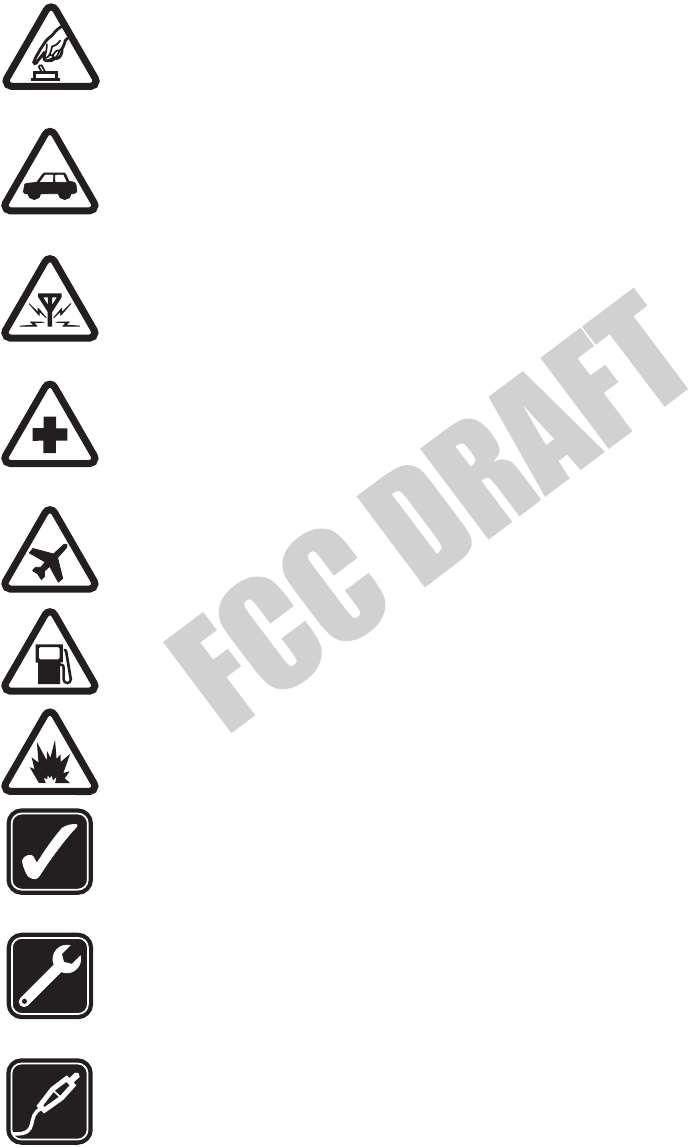
Nokia User GuideCopyright © 2004 Nokia
For your safety
1 For your safety
Read these simple guidelines. Not following them may be dangerous or illegal.
Read the complete user guide for further information.
SWITCH ON SAFELY
Do not switch the phone on when wireless phone use is prohibited or
when it may cause interference or danger.
ROAD SAFETY COMES FIRST
Obey all local laws. Always keep your hands free to operate the vehicle
while driving. Your first consideration while driving should be road safety.
INTERFERENCE
All wireless phones may be susceptible to interference, which could
affect performance.
SWITCH OFF IN HOSPITALS
Follow any restrictions. Switch the phone off near medical equipment.
SWITCH OFF IN AIRCRAFT
Follow any restrictions. Wireless devices can cause interference in aircraft.
SWITCH OFF WHEN REFUELING
Don’t use the phone at a refueling point. Don’t use near fuel or chemicals.
SWITCH OFF NEAR BLASTING
Follow any restrictions. Don’t use the phone where blasting is in progress.
USE SENSIBLY
Use only in the normal position as explained in the product documentation.
Don’t touch the antenna unnecessarily.
QUALIFIED SERVICE
Only qualified personnel may install or repair this product.
ENHANCEMENTS AND BATTERIES
Use only approved enhancements and batteries. Do not connect
incompatible products.
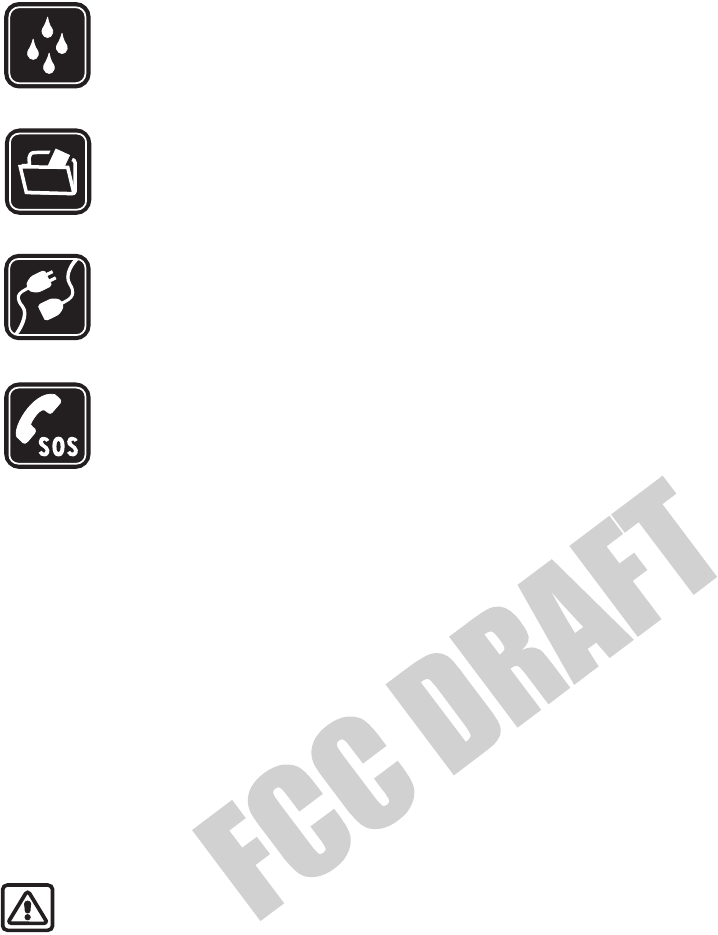
2 Copyright © 2004 Nokia
WATER-RESISTANCE
Your phone is not water-resistant. Keep it dry.
BACK-UP COPIES
Remember to make back-up copies or keep a written record of all
important information stored in your phone.
CONNECTING TO OTHER DEVICES
When connecting to any other device, read its user guide for detailed
safety instructions. Do not connect incompatible products.
EMERGENCY CALLS
Ensure the phone is switched on and in service. Press the End key as
many times as needed to clear the display and return to the main
screen. Enter the emergency number, then press the Send key. Give your
location. Do not end the call until given permission to do so.
• ABOUT YOUR PHONE
The Nokia 6670 phone comes in two model types—the Nokia 6670 phone, which is
approved for use in 900, 1800, and 1900 MHz GSM networks, and the Nokia 6670 b
phone, which is approved for use in 850, 1800, and 1900 MHz GSM networks.
To view your model type, refer to the information label under the battery. For more
information about where this label is located, see “Find the phone label” on page 5.
When using the features in this device, obey all laws and respect privacy and
legitimate rights of others.
Warning: To use any features in this device, other than the alarm clock,
the phone must be switched on. Do not switch the device on when
wireless phone use may cause interference or danger.
• NETWORK SERVICES
To use the phone you must have service from a wireless service provider. Many of
the features in this device depend on features in the wireless network to function.
These Network Services may not be available on all networks, or you may have to
make specific arrangements with your service provider before you can utilize Network
Services. Your service provider may need to give you additional instructions for their
use and explain what charges will apply. Some networks may have limitations that
affect how you can use Network Services. For instance, some networks may not
support all language-dependent characters and services.

Nokia User GuideCopyright © 2004 Nokia
For your safety
Your service provider may have requested that certain features be disabled or not
activated in your device. If so, they will not appear on your device menu. Contact
your service provider for more information.
When using the features in this device, obey all laws and respect privacy and
legitimate rights of others.
• SHARED MEMORY
The following features in this device may share memory: contacts, text messages,
e-mail messages, multimedia messages, instant messages, images and ringing tones,
video recorder, RealPlayer, calendar and to-do notes, themes, and downloaded
applications. The use of one or more of these features may reduce the memory
available for the remaining features sharing memory. For example, saving many
images may use all of the available memory. Your phone may display a message that
the memory is full when you try to use a shared memory feature. In this case, delete
some of the information or entries stored in the shared memory features before
continuing. Some of the features may have a certain amount of memory specially
allotted to them in addition to the amount of memory shared with other features.
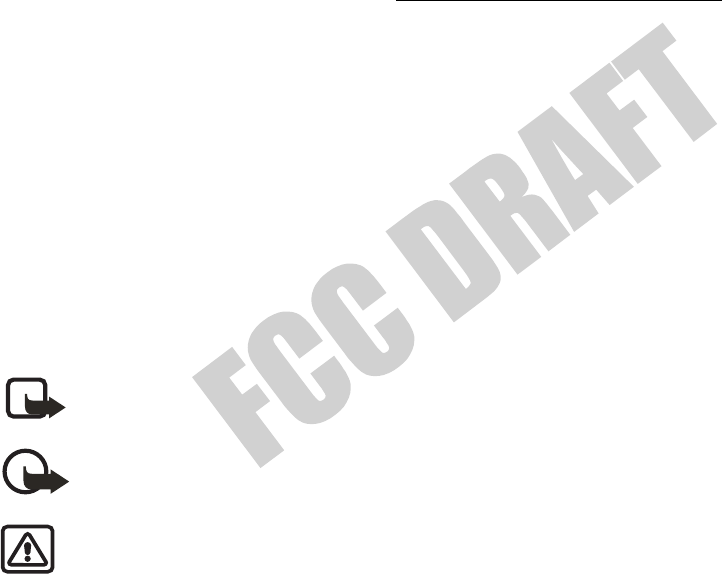
4 Copyright © 2004 Nokia
2 General information
Congratulations on your purchase of a Nokia mobile phone. Your phone provides
many functions that are practical for daily use, such as a digital camera, a video
recorder, messaging, e-mail, a clock, an alarm clock, a calculator, and a calendar.
Your phone can connect to a PC, laptop, or other device using a data cable or
Bluetooth technology. For more information on connectivity, refer to the PC Suite
user guide on the CD-ROM supplied with your phone. The PC Suite user guide,
Nokia PC Suite, and all related software can be downloaded from the U.S. Mobile
Phone products section of www.nokia.com.
•REGISTER YOUR PHONE
Make sure to register your phone at www.warranty.nokiausa.com or
1-888-NOKIA-2U (1-888-665-4228) if you need to call the center or have your
phone repaired.
• E-NEWSLETTERS
When you register your phone, you may sign up for Nokia’s e-newsletter Nokia
Connections. You will receive tips and tricks on using your phone, accessory
information, and special offers.
• FOLLOW GRAPHIC CLUES
This guide uses certain icons to alert you to important information.
Note: Explains a feature or points out an important concept.
Important: Indicates critical information on using a feature.
Warning: Helps you avoid personal injury, damage to the phone, or
property damage.
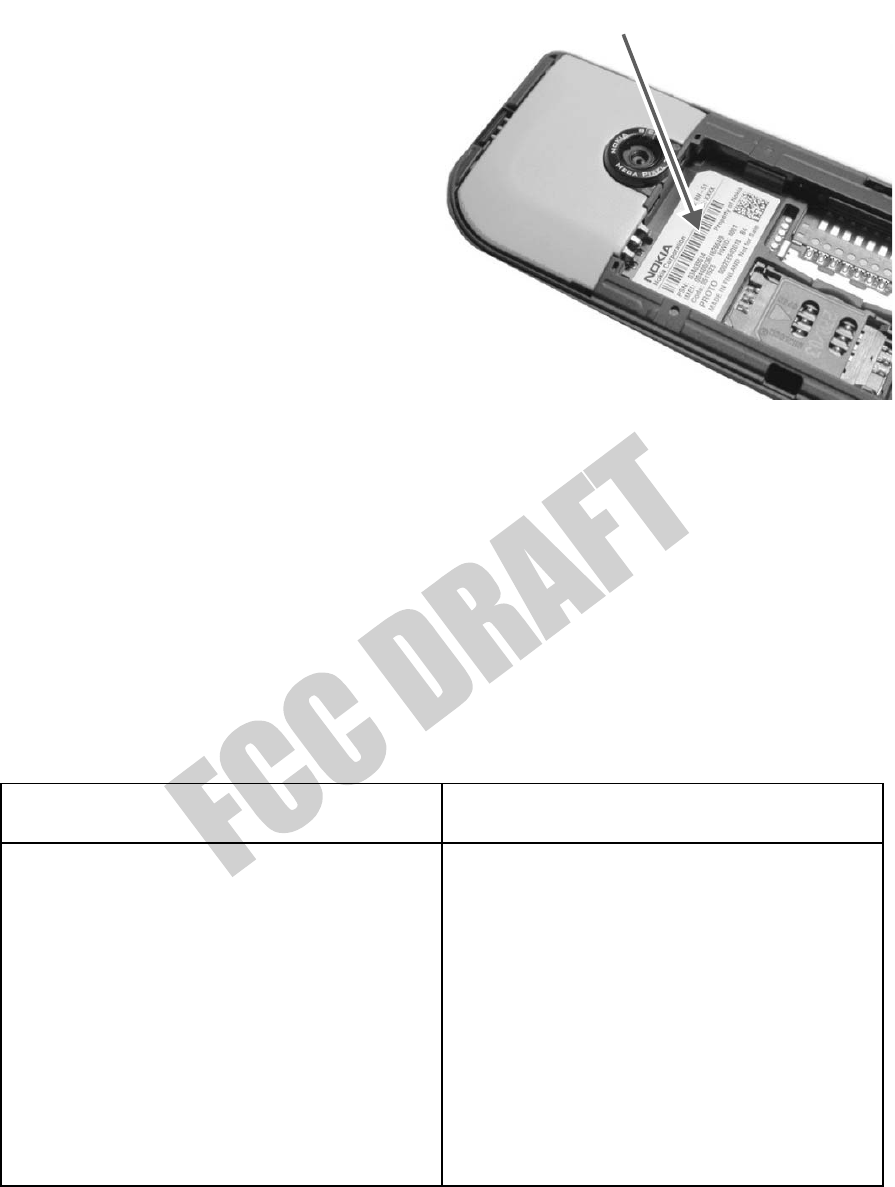
Nokia User GuideCopyright © 2004 Nokia
General information
• FIND THE PHONE LABEL
If you ever need to call the Nokia
Customer Care Center or your service
provider, you will need to provide
specific information about your
phone. This information is located
on the phone labels, which are
found on the back of the phone
beneath the battery.
The inside cover of this guide has a
chart in which you can enter the
information from your phone label
so that you can refer to it easily.
•CONTACT NOKIA
To help Nokia promptly answer your questions, please have the following
information available before contacting the Nokia Customer Care Center
(see “Find the phone label” on page 5 to locate this information):
•Your phone model number (such as Nokia 6670 or Nokia 6670 b)
• Type number (such as RH-67)
•IMEI number
•Your local zip code
•The phone or enhancement in question
Nokia Customer Care Center, USA Customer Care, Canada
Nokia Mobile Phones
7725 Woodland Center Blvd.
Suite #150
Tampa, Florida 33614
Tel: 1-888-NOKIA-2U
(1-888-665-4228)
Fax: 1-813-249-9619
For TTY/TDD users: 1-800-24-NOKIA
(1-800-246-6542)
Nokia Products Ltd.
601 Westney Road South
Ajax, Ontario L1S 4N7
Tel: 1-888-22-NOKIA
(1-888-226-6542)
Fax: 1-905-619-4360
Website: www.nokia.ca
Information label under battery

6 Copyright © 2004 Nokia
• ACCESSIBILITY SOLUTIONS
Nokia is committed to making mobile phones easy to use for all users including
those with disabilities. For more information, visit www.nokiaaccessibility.com.
For more information on accessibility enhancements, see also “Phone adapter
HDA-10 accessibility enhancement” on page 116.
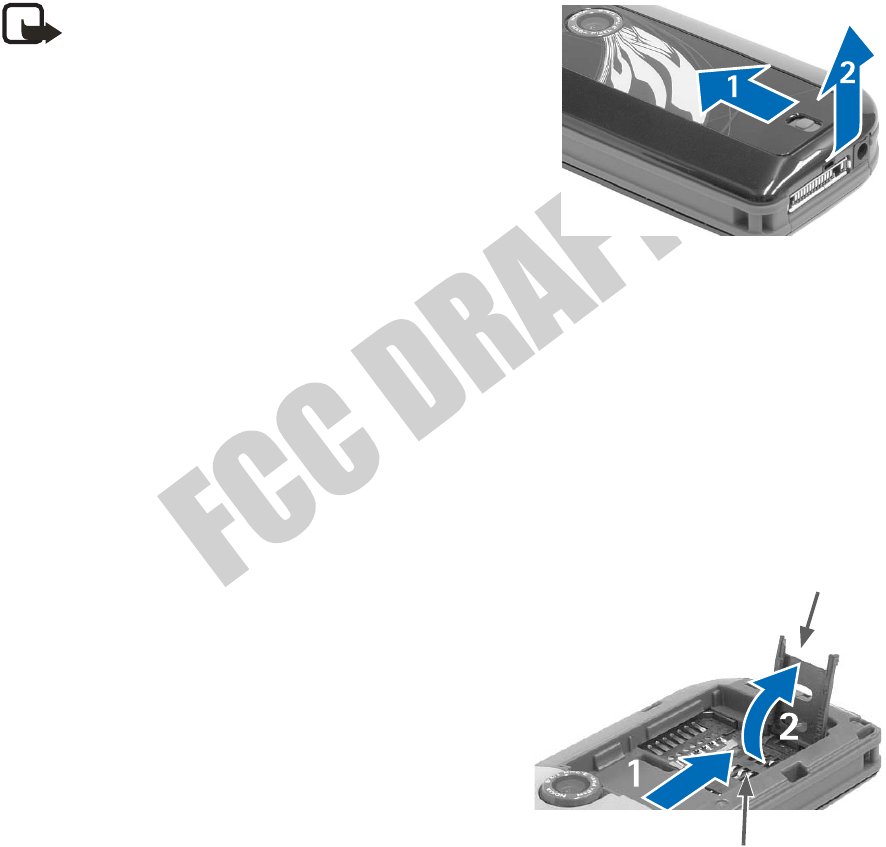
Nokia User GuideCopyright © 2004 Nokia
Getting started
3 Getting started
To begin using your phone, a SIM card must be inserted into the phone. You may
also use a memory card with the phone. Before you attempt to insert or remove a
SIM card or memory card, review the following procedures to become familiar with
the inside of your phone.
“Nokia 7610 phone at a glance” on page v identifies other features on your phone.
• REMOVE THE BACK COVER
Note: Before removing the phone
cover, always switch off the power and
disconnect the phone from the charger
or any other device. Always store and use
the phone with the cover attached.
1To open the cover, with the back of the phone
facing you, press the locking catch in the
direction of the arrow (1).
2While pressing the locking catch, slide the back cover off of the phone (2).
3Remove the battery from the phone if necessary.
• INSERT THE SIM CARD
Keep all SIM cards out of the reach of small children. For availability and information
on using SIM card services, contact your SIM card vendor. This may be the service
provider, network operator, or other vendor. For a better understanding of your SIM
card, see “SIM card” on page 111.
1Locate the SIM card slot.
2To open the SIM card holder, slide the
holder in the open direction (1), and lift
the holder up (2).
3Position the bottom of the SIM card in the
top of the holder, and carefully slide the
SIM card down into the holder, until the
bottom of the card fits in the base of
the slot.
SIM card holder
SIM card slot
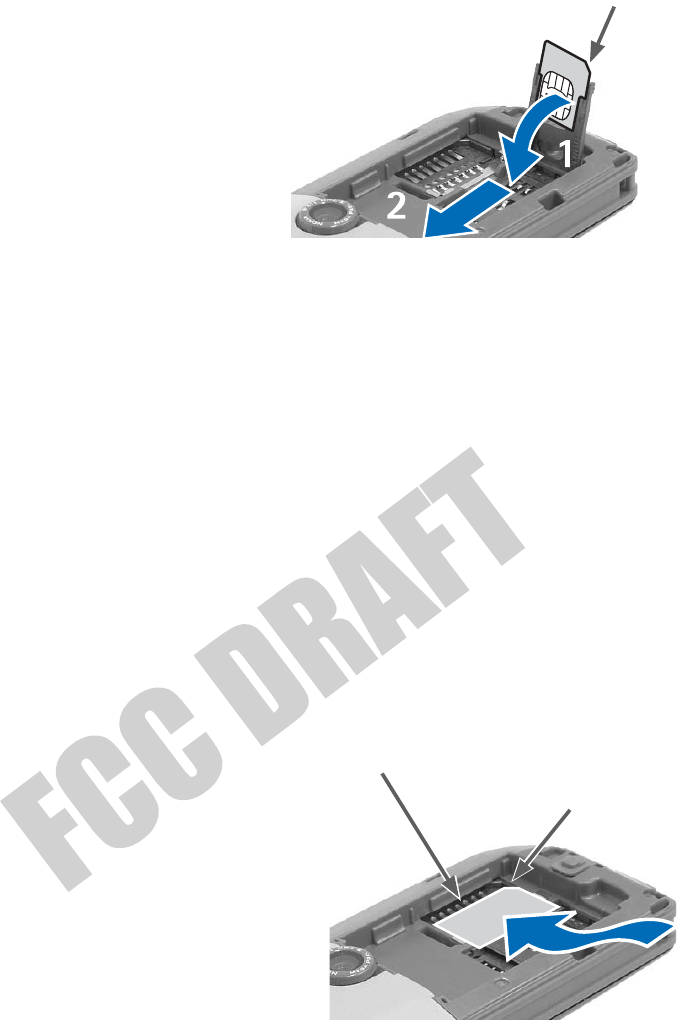
8 Copyright © 2004 Nokia
Make sure that the bevelled corner
on the SIM card is at the top of the
holder and that the gold-colored
contact area on the card is facing the
inside of the phone.
4To secure the SIM card, fold the SIM
card holder back down into the
phone (1), and slide the holder into
the closed position (2) until it firmly
snaps into place.
• INSERT THE MEMORY CARD
This phone uses a reduced size multimedia card (RS-MMC). Only use RS-MMCs
with this device. For more information on the memory card adapter, see “Attach
and remove the memory card adapter” on page 81.
Other memory cards, such as secure digital (SD) cards, do not fit in the memory
card slot and are not compatible with this device. Attempts to use a noncompatible
memory card may damage the memory card as well as the phone, and data stored
on the noncompatible card may be corrupted. See “Memory card” on page 80 for
further information.
Keep all memory cards out of the reach of small children.
See “Remove the back cover” on page 7 for details on removing the phone cover.
1Locate the memory card slot.
2Insert the top of the memory card under
the hood at the right side of the slot and
carefully slide the memory card to the
right until it fits in the slot.
Make sure that the bevelled corner on
the memory card is facing toward the
bottom right side of the phone and that
the gold-colored contact area on the
card is facing downward.
3Press the memory card into place.
bevelled corner
Memory card slot
bevelled corner
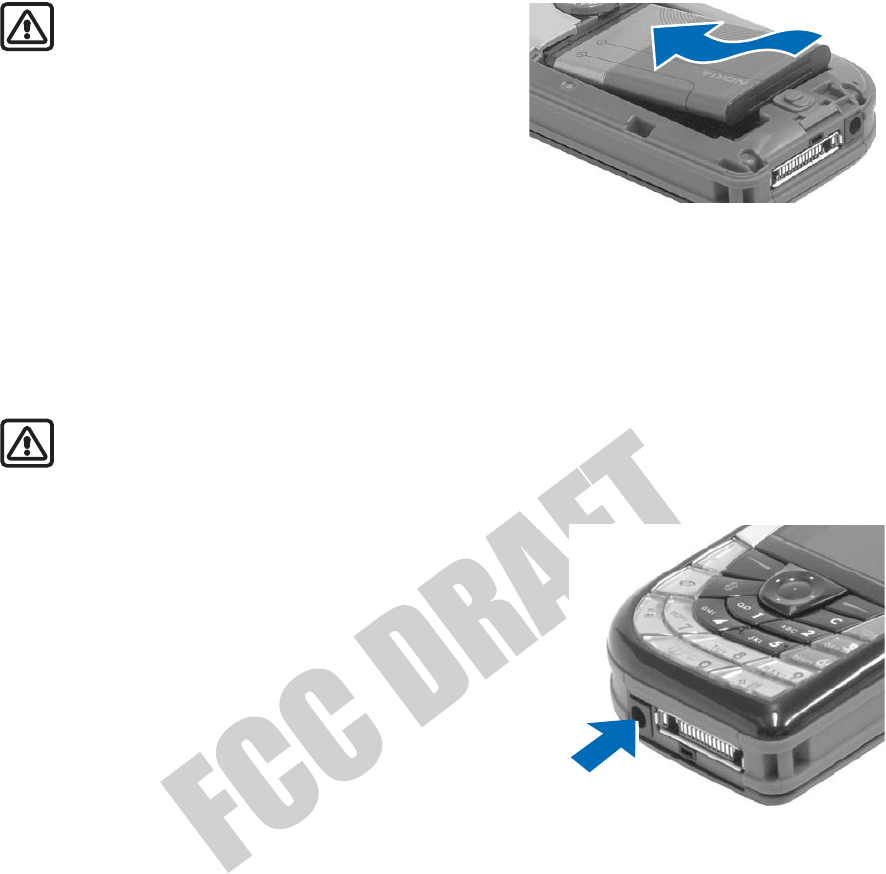
Nokia User GuideCopyright © 2004 Nokia
Getting started
• INSERT THE BATTERY
Warning: Use only batteries
approved by Nokia for use with this
particular model. The use of any other
types may invalidate any approval or
warranty, and may be dangerous.
1Align the gold-colored contacts of the
battery with the corresponding connectors
on the phone, and push the opposite end
of the battery until it snaps into place.
2Slide the cover back onto the phone. You will hear it click into place.
• CHARGE THE BATTERY
Warning: Use only chargers approved by Nokia for use with this particular
model. The use of any other types may invalidate any approval or warranty,
and may be dangerous.
Check the model number of any charger before
use with this device. This device is intended for
use when supplied with power from ACP-12.
1Connect the charger to an ac wall outlet.
2Connect the power cord from the charger to
the base of the phone. (You will hear it click
into place.)
The battery indicator bar starts scrolling.
Note that you can use the phone while
charging. When the battery is fully charged, the bar stops scrolling.
3Disconnect the charger from the phone, then from the ac outlet.
See "Battery information" on page 114. See also “Other compatible Nokia
enhancements” on page 115 for a list of other compatible chargers.
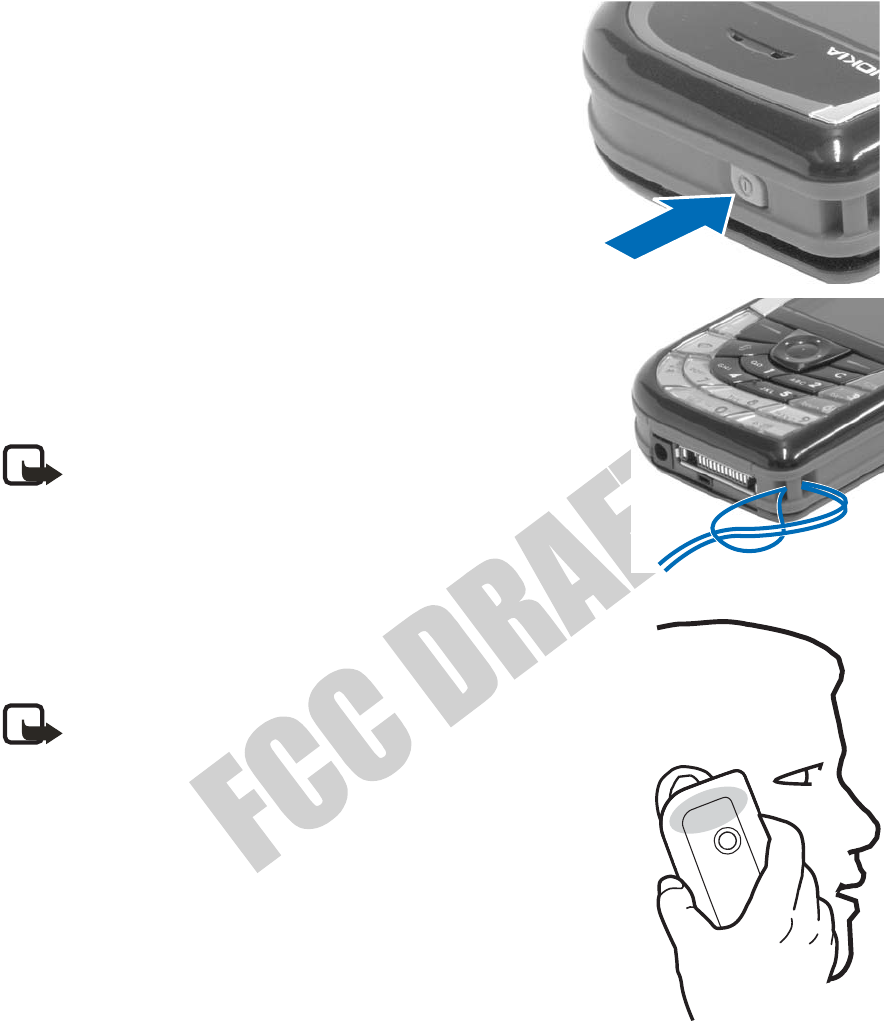
10 Copyright © 2004 Nokia
• SWITCH THE PHONE ON OR OFF
Press and hold the Power key.
After it is switched on, the phone goes through
various start-up stages while it is loading software.
It may be more than 30 seconds before the phone is
ready for use.
• ATTACH THE WRIST STRAP
You can attach the wrist strap at the top left corner or
bottom right corner of the phone. Thread the strap
through the holder and tighten it.
Note: Only connect the strap to one fixture at
a time. Use only Nokia approved enhancements.
• TIPS ON EFFICIENT OPERATION
Your phone has an internal antenna on the back of the
phone above the camera lens.
Note: As with any other radio transmitting device,
do not touch the antenna unnecessarily when the
device is switched on. Contact with the antenna
affects call quality and may cause the phone to
operate at a higher power level than otherwise
needed. Avoiding contact with the antenna area
when operating the phone optimizes the antenna
performance and the battery life.
• IF THE PHONE REQUESTS A PIN CODE
The PIN code is usually supplied with the SIM card.
Key in the code (displayed as ****), and press OK. For more information on PIN
codes, see “Security” on page 64.
• IF THE PHONE REQUESTS A LOCK CODE
Key in the lock code (displayed as *****), and press OK. The factory setting for the lock
code is 12345. For more information on security codes, see “Security” on page 64.
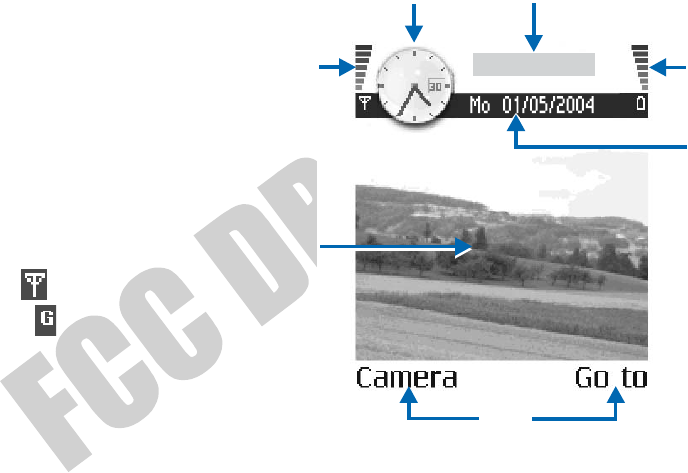
Nokia User GuideCopyright © 2004 Nokia
Getting started
• SET THE TIME AND DATE
If you are prompted to enter the time and date when you turn your phone on, use
the number keys 0–9 to key in the current time, then the date. Press OK to accept
the settings. See also “Date and time” on page 63.
• MAKE A CALL
1In the standby mode, key in the phone number, including the area code.
2If you make a mistake, press the Clear key to clear numbers.
3Press the Send key, and wait for the answer.
4Press the End key to finish the call or cancel the call attempt.
•STANDBY MODE
Indicators are shown when the phone
is ready for use, with no characters
keyed in. In this state, the phone is in
the standby mode.
The graduated bar (A) shows the
signal strength of the cellular network
at your current location. The higher
the bar, the stronger the signal. The
antenna symbol is replaced with
the GPRS symbol when the GPRS
connection has been set to When
available and a connection is
available in the network or in the
current cell. See "GPRS" on page 62.
The area to the right of the signal bar (B) shows an analog or a digital clock.
See "Date and time" on page 63.
The area above the date (C) indicates in which cellular network the phone is
currently being used.
The graduated bar (D) shows the battery charge level. The higher the bar, the more
charge left in the battery.
The navigation bar (E) shows the currently active profile. If the selected profile is
Normal, the current date is displayed instead of the profile name.
Current shortcuts (F) are assigned to the Left and Right selection keys.
The background image (G) may be any image you select in the standby mode.
See "Themes" on page 74.
A
BC
D
E
F
G

12 Copyright © 2004 Nokia
Your phone has a screen saver. If there are no actions for 5 minutes, the display is
cleared and a screen saver becomes visible. To deactivate the screen saver, press any
key. You can also modify the screen saver display and the time that elapses before
the screen saver starts. See “Themes” on page 74 and “Standby mode” on page 59.
•ICONS
Several icons may be displayed while the phone is in the standby mode. The icons
are related to activity, data connections, enhancements, or voice volume.
Activity indicators
One or more of the following icons may be shown when the phone is in the
standby mode:
You have received new messages to the inbox in Messaging. If the
indicator is blinking, the phone memory is low, and you must delete
some data. See "Memory low" on page 111.
You have received one or more voice messages. See "Call voice mail" on
page 18.
There are messages waiting to be sent in Outbox. See "Outbox" on
page 52.
The ringing type has been set to Silent, message alert tone to Off, and
IM alert tone to Off in the currently active profile. See "Profiles" on
page 73.
The phone keypad is locked. To unlock, press the Left selection key, then
the * key.
You have an active alarm. See "Clock" on page 79. See "Calendar" on
page 31.
A Bluetooth connection is active.
All call forwarding is turned on.
Indicates that all calls to the phone are forwarded to voice mail.
See "Call forwarding (network service)" on page 21. If you have two
phone lines, the forward indicator for the first line is and for the
second line . See “Line in use (network service)” on page 60.
You can make calls using phone line 2 only (network service). See "Line
in use (network service)" on page 60.
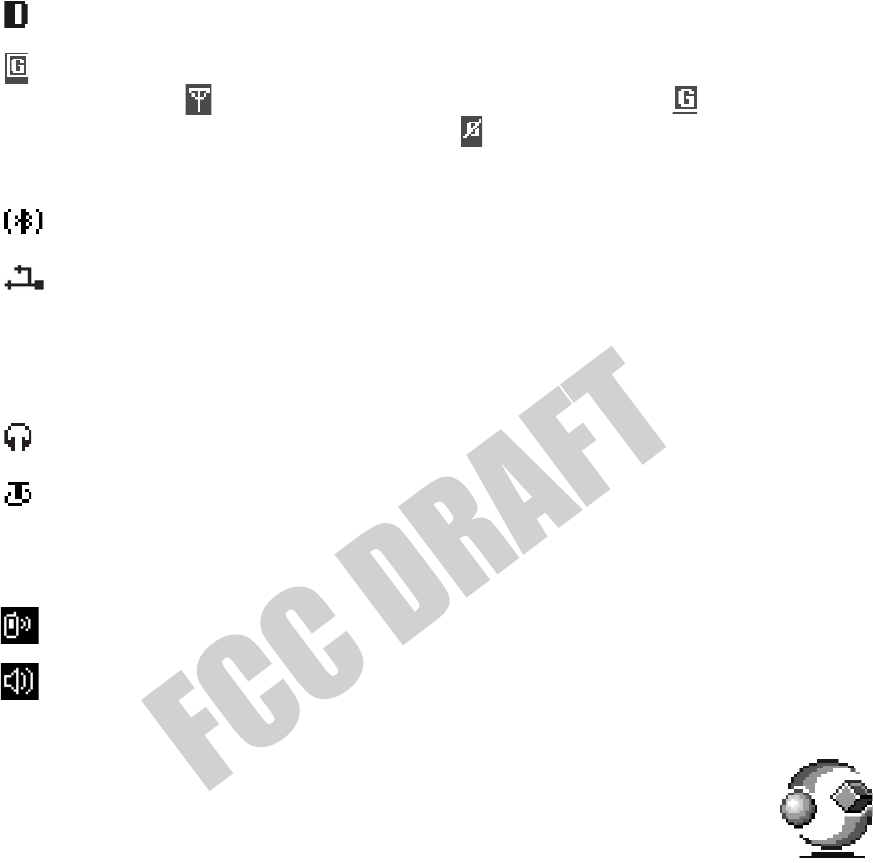
Nokia User GuideCopyright © 2004 Nokia
Getting started
Data connection indicators
When an application is establishing a data connection, an indicator blinks in the
standby mode. When an indicator is shown continuously, the connection is active.
Enhancement indicators
Voice volume indicators
•MENU
Press the Menu key to display the main menu. In the menu, you can
access all the applications in your phone.
Menu options are Open, List view or Grid view, Move, Move to folder,
New folder, Rename, App. downloads, Memory details, Help, and Exit.
Data call
GPRS connection. The GPRS symbol is shown instead of the antenna
symbol when there is an active GPRS connection, when there are
multiple GPRS connections, and for when the GPRS connection is
put on hold during voice calls.
Bluetooth connection
USB connection
A headset is connected.
A loopset is connected.
Earpiece mode
Loudspeaker mode
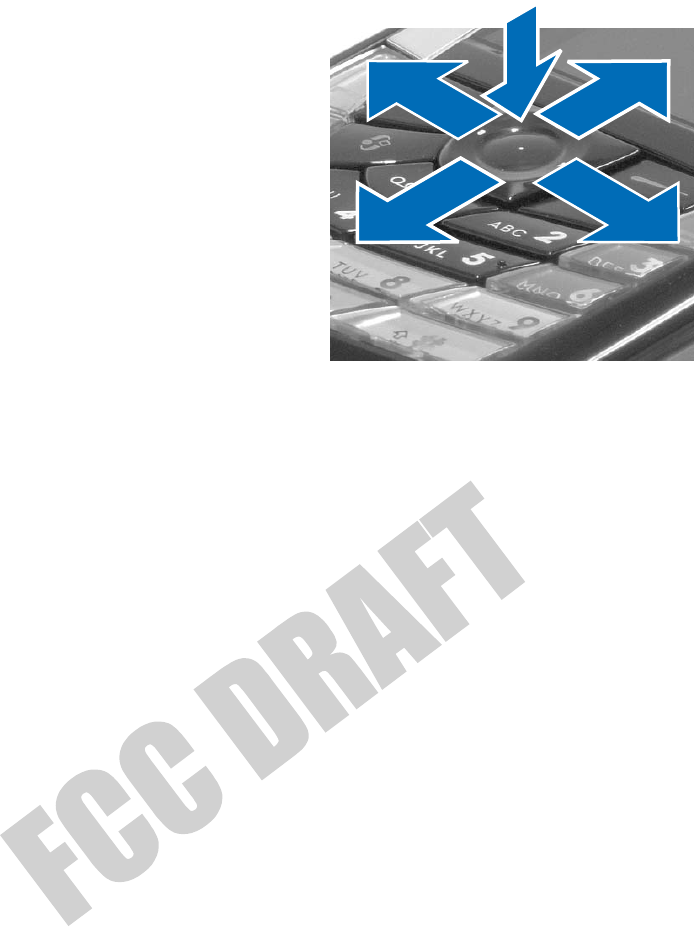
14 Copyright © 2004 Nokia
Move in the menu
Use the Scroll key as follows to navigate
the menu:
•Scroll up by pressing the Scroll key up (1).
•Scroll down by pressing the Scroll key
down (2).
•Scroll left by pressing the Scroll key left (3).
•Scroll right by pressing the Scroll key
right (4).
•Press the center of the Scroll key
(hereafter, press the Scroll key) to open a selected application or folder (5).
Close applications
Backstep by pressing Back or Exit as many times as needed to return to the
standby mode, or select Options > Exit.
If you press the End key, the phone returns to the standby mode and the application
is left open in the background. Pressing the End key will always end a call, even if
another application is active and displayed.
When you switch the phone off correctly, using the Power key, the phone will
attempt to save any unsaved data and close any applications that are still open.
This process may take a short time.
Rearrange the menu
You can rearrange the menu icons as required. You can place more rarely used
applications in folders and move applications that you use more often from a folder
to the main menu. You can also create new folders.
1Scroll to the item you want to move, and select Options > Move.
A check mark is placed beside the application.
2Scroll to where you want the application, and select OK.
To move an item to a folder or from a folder to the menu, see “Common actions for
all applications” on page 15.
3
4
1
5
2
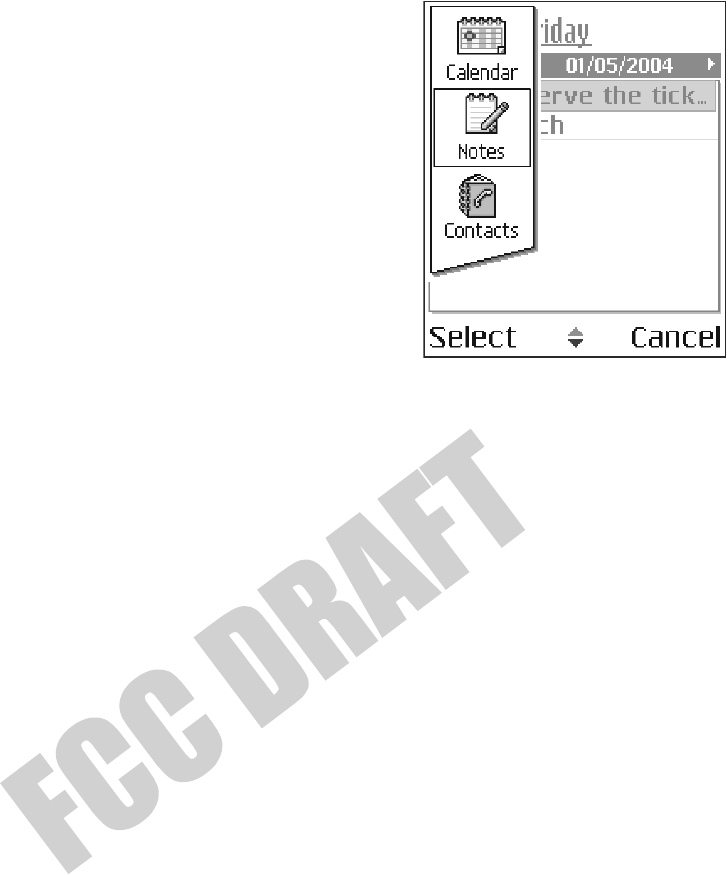
Nokia User GuideCopyright © 2004 Nokia
Getting started
Switch between open applications
If you have several applications open and want to
switch from one application to another, press and
hold the Menu key. The application switching
window opens showing a list of applications that
are currently open. Scroll to an application and
press the Scroll key to go to it.
If memory is getting low, the phone may close some
applications. The phone saves any unsaved data
before an application is closed.
•OPTIONS LISTS
Options lists tell you which commands are available
in different views and situations. The available commands change depending on
the view. In some situations, when you press the Scroll key, a shorter options list
appears, listing the main commands available in the view.
• COMMON ACTIONS FOR ALL APPLICATIONS
Open items for viewing—When you are viewing a list of files or folders and want
to open an item, scroll to the item and press the center of the Scroll key, or select
Options > Open.
Edit items—To change the contents of an item, open it for viewing and select
Options > Edit. Use the Scroll key to view all fields of the item.
Rename items—To give an item a new name, scroll to the file or folder and select
Options > Rename.
Remove, delete items—Scroll to the item, and select Options > Delete; or press
the Clear key. To delete many items at a time, mark each item and delete all of
them at once.
Mark an item—There are several ways to select items in a list.
•To select one item at a time, scroll to it, and select Options > Mark/Unmark >
Mark; or press the Edit key and the Scroll key at the same time. A check mark
is placed next to the item.
•To select all items in the list, select Options > Mark/Unmark > Mark all.
Mark multiple items—Press and hold the Edit key; then scroll up or down. As the
selection moves, a check mark is placed next to the items. To end the selection, stop
scrolling, and release the Edit key.
•After you have selected all the items you want, move or delete them by selecting
Options > Move to folder or Delete.
•To unmark an item, scroll to it, and select Options > Mark/Unmark > Unmark;
or press the Edit key and the Scroll key at the same time.
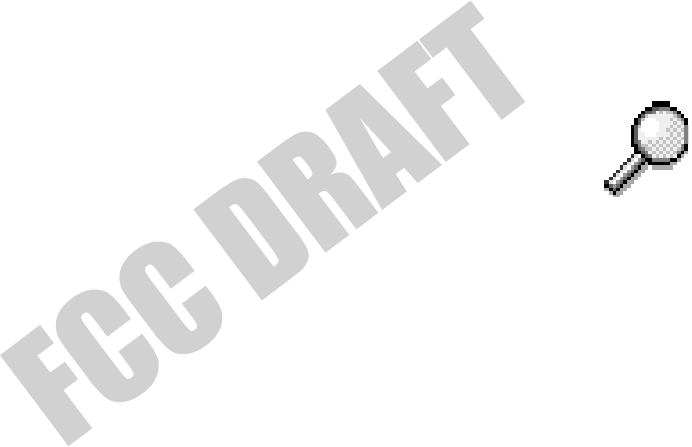
16 Copyright © 2004 Nokia
Create folders—To create a new folder, select Options > New folder. You are asked
to give a name to the folder (up to 35 letters).
Move items to a folder—To move items to a folder or between folders, select
Options > Move to folder (not shown if there are no folders available). When you
select Move to folder, a list of available folders opens, and you can also see the
root level of the application (for moving an item out of a folder). Select the location
to which you want to move the item, and select OK.
Send items—To send items to compatible devices, scroll to the item that you want
to send, and select Options > Send > Via multimedia or Via Bluetooth.
•If you select to send the item in a multimedia message, an editor opens. Press
the center of the Scroll key to select the recipients from the contacts directory,
or write the phone number or e-mail address of the recipient in the To field.
Add text or sound, and select Options > Send. See "Write and send messages"
on page 47.
•If you select Via Bluetooth, see “Send data by Bluetooth connection” on
page 105.
• SEARCH FOR ITEMS
You can search for a name, file, folder, or shortcut by using the
search field. In some situations the search field is not visible
automatically, but you can activate it by selecting Options > Find
or by starting to key in letters.
1To search for an item, start to key in text in the search field.
The phone immediately starts to search for matches and moves the selection
to the best match.
2To make the search more accurate, key in more letters and the selection moves
to the item that best matches the letters.
3When the correct item is found, press the Scroll key to open it.
• VOLUME CONTROL
When you have an active call or are listening to a sound, scroll right or left to
increase or decrease the volume level, respectively. See also “Voice volume
indicators” on page 13.

Nokia User GuideCopyright © 2004 Nokia
Getting started
•LOUDSPEAKER
The loudspeaker allows you to speak and listen to the phone from a short distance
without having to hold the phone to your ear. The loudspeaker can be used during
a call, with sound and video applications, and when viewing multimedia messages.
Sound and video applications use the loudspeaker by default. Using the loudspeaker
makes it easier to use other applications while in a call.
To activate the loudspeaker during an active call, select
Loudsp. or Options > Activate loudsp. A tone is played,
is shown in the navigation bar, and the volume
indicator changes.
The loudspeaker cannot be activated when a headset is connected to the phone.
To turn off the loudspeaker during an active call, select Handset or Options >
Activate handset.
Important: Do not hold the phone near your ear when the loudspeaker is
in use because the volume may be extremely loud.
• KEYGUARD
Use the keyguard (keypad lock) feature to help prevent accidental key presses.
In the standby mode, press the Left selection key; then quickly press the *key. When
the keys are locked, appears on the display. Press the Left selection key; then
quickly press the *key to unlock the keys.
When keyguard is on, press the Send key to answer a call. During a call, the phone
can be operated in the normal way.
When the keyguard is on, calls still may be possible to the official emergency
number programmed into your phone. Enter the emergency number (for example,
911), and press the Send key.
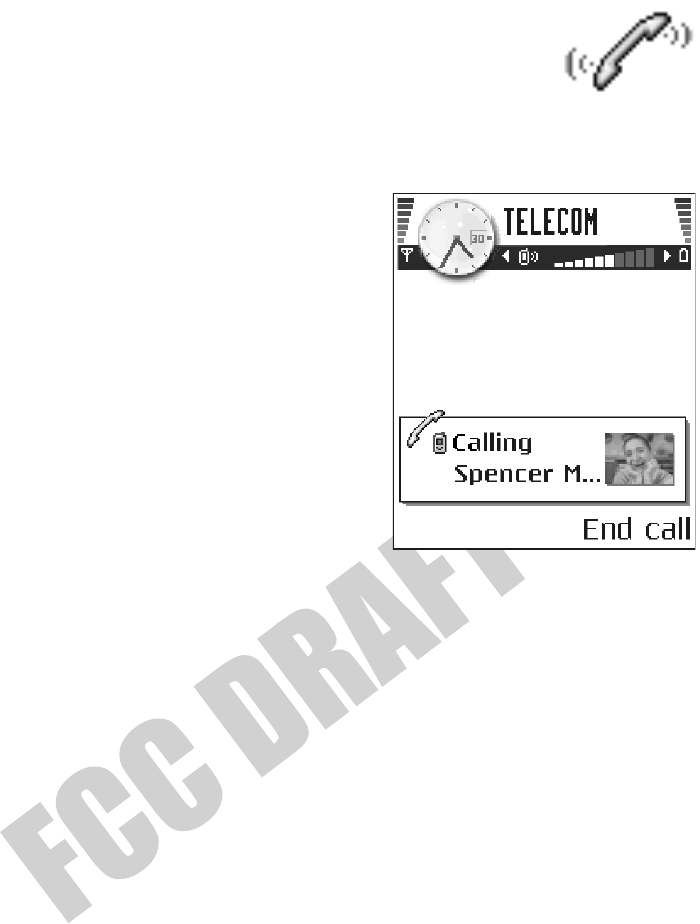
18 Copyright © 2004 Nokia
4 Your phone
• MAKE A CALL
1In the standby mode, key in the phone number, including the area code.
Scroll right or left to move the cursor. Press the
Clear key to remove a number.
For international calls, press the * key twice for
the international prefix (the + character
replaces the international access code), and key
in the country code, the area code without 0,
and the phone number.
Calls described here as international may be
made between regions of the same nation.
2Press the Send key to call the number.
3Press the End key to end the call (or to cancel
the call attempt).
Pressing the End key always ends a call, even if another application is active
and displayed.
You can make a call using your voice so that you do not need to key in the number.
See "Voice dialing" on page 25.
Use Contacts to make a call
1To open the contacts directory, select Menu > Contacts, or press the Scroll key
in the standby mode.
2To find a contact, scroll to the desired name, or key in the first letters of the
name. The search field opens automatically and matching contacts are listed.
3Press the Send key to start the call.
If the contact has more than one phone number, scroll to the number and
press the Send key to start the call.
Call voice mail
Voice mail (network service) is an answering service where callers can leave
voice messages.
•To call voice mail, press the 1key and the Send key in the standby mode, or
press and hold the 1key.
•If the phone asks for the voice mail number, key it in and press OK. Obtain this
number from your service provider.
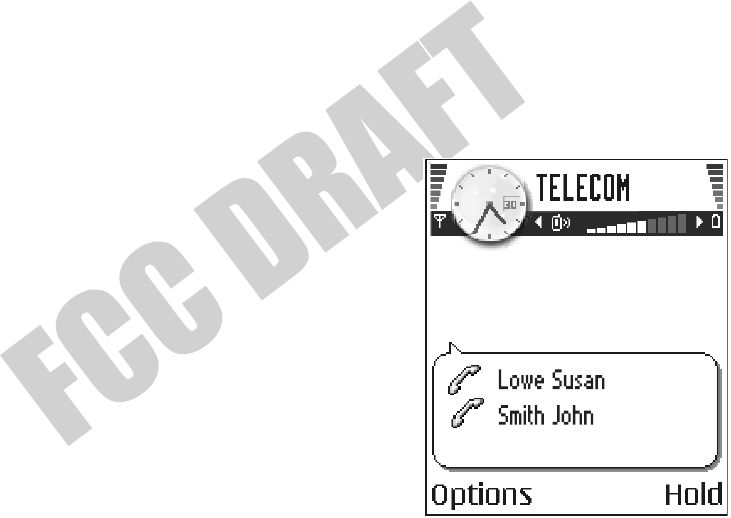
Nokia User GuideCopyright © 2004 Nokia
Your phone
To forward calls to your voice mail, see “Call forwarding (network service)” on page 21.
Each phone line may have its own voice mail number. See "Line in use (network
service)" on page 60.
CHANGE THE VOICE MAIL NUMBER
To change the phone number of your voice mail, select Menu > Tools > Voice mail >
Options > Change number. Key in the number (obtained from your service provider),
and press OK.
1-touch dialing
To view the 1-touch dialing grid, select Menu > Tools > 1-touch.
To assign a phone number to one of the 1-touch dialing keys (2–9), select Options >
Assign. See also “Assign 1-touch dialing keys” on page 26. To call the number in the
standby mode, press the corresponding 1-touch dialing key and the Send key.
To turn the 1-touch dialing function on, select Menu > Settings > Call > 1-touch
dialing > On. If the 1-touch dialing function is set to On, press and hold the
corresponding 1-touch dialing key until the call is started.
Make a conference call (network service)
Conference calling allows you to make a conference
call with up to six participants, depending on
network limitations.
1Make a call to the first participant.
2To make a call to a new participant, select
Options > New call.
3Key in or search the memory for the phone
number of the participant, and press Call.
The first call is automatically put on hold.
4When the new call has been answered, select
Options > Conference to join the first
participant in the conference call.
5To end the active conference call, press the End key.
To add a new person to the call, repeat step 2.
To have a private conversation with one of the participants, select Options >
Conference > Private. Scroll to the desired participant, and press Private. The
conference call is put on hold in your phone, and the other participants can still
continue talking with each other while you have a private discussion with one
participant only. Once you have finished the private conversation, select Options >
Conference to return to the conference call.
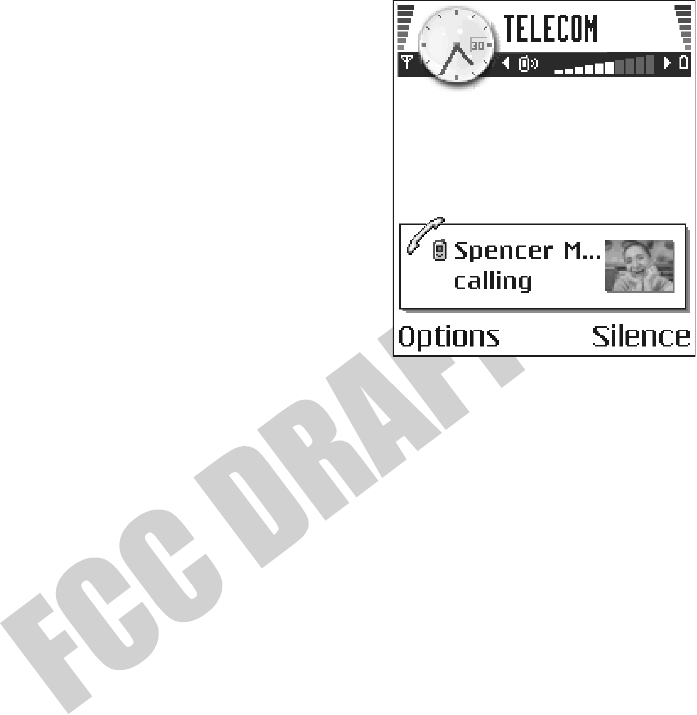
20 Copyright © 2004 Nokia
To drop one participant from the conference call, select Options > Conference >
Drop participant; then scroll to the participant, and press Drop.
The quickest way to make a new call is to dial the number, and press the Send key
to start the call. The existing call is automatically put on hold.
•ANSWER A CALL
To answer an incoming call, press the Send key.
To end the call, press the End key.
If you do not want to answer a call, press the
End key.
When a call comes in, select Silence to quickly
mute the ringing tone.
Options during a call
Select Options during a call for some of the
following options: Answer, Decline, Swap, Activate
loudsp. or Activate handset, End active call, End all
calls, Hold or Unhold, Mute or Unmute, Conference,
Transfer, Send touch tones, and Help.
You might not have all of these options. Contact your service provider for more details.
Loudspeaker and Handset may be displayed as options for the Right selection key and
can be used as shortcuts for Activate handsfree and Deactivate handsfree, respectively.
Swap is used to switch between the active call and the call on hold.
Transfer is used to connect an incoming call or a call on hold with an active call
and to disconnect yourself from both calls.
Send touch tones is used to send DTMF tone sequences, for example, passwords
or bank account numbers:
1Key in the digits with the 0–9 keys.
Each keystroke generates a DTMF tone, which is transmitted while the call is
active. Press the *key repeatedly to produce *, p (inserts a pause of approximately
2 seconds before or between DTMF characters), and w (if you use this character,
the remaining sequence is not sent until you press the Send key again during the
call). Press the #key to produce #.
2To send the tone, press OK.
Call waiting (network service)
If you have activated the call waiting service, the network will notify you of a new
incoming call while you have a call in progress.
1During a call, press the Send key to answer the waiting call.
The first call is put on hold.
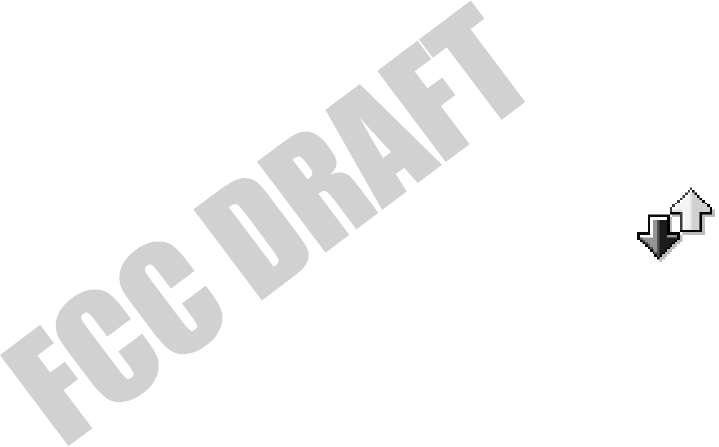
Nokia User GuideCopyright © 2004 Nokia
Your phone
2To switch between the two calls, press Swap.
3To end the active call, press the End key; or to end both calls at the same time,
select Options > End all calls.
Call forwarding (network service)
When call forwarding is activated, you can direct your incoming calls to
another number, for example, to your voice mail number. For details, contact
your service provider.
Select Menu > Settings > Call forwarding.
•Select one of the forwarding options, for example, select If busy to forward
voice calls when your number is busy or when you reject incoming calls.
•Select Options > Activate to turn the forwarding setting on, Cancel to turn
the forwarding setting off, or Check status to check whether the forwarding
is activated or not.
•To cancel all active forwarding, select Options > Cancel all forwards.
See also “Activity indicators” on page 12.
Call restriction and call forwarding cannot be active at the same time. See "Call
restriction (network service)" on page 66.
• CALL LOG
Select Menu > Log.
You can use the log to monitor phone calls, text messages, data calls,
and packet data connections registered by the phone. Filter the log to view just one
type of event and create new contact cards based on the log information.
Connections to your remote mailbox, multimedia messaging center, or browser pages
are shown as data calls or packet data connections in the general communications log.
Recent calls log
Select Menu > Log > Recent calls.
The phone registers the phone numbers of missed, received, and dialed calls, and
the date and time of your calls. The phone registers missed and received calls only
if the network supports these functions and if the phone is switched on within the
network service area.
Options in the Missed, Received, and Dialed views are Call, Create message, Use
number, Delete, Clear list, Add to Contacts, Help, and Exit.
Missed calls and received calls
To view a list of the last 20 phone numbers received but not answered (network
service), select Menu > Log > Recent calls > Missed calls.
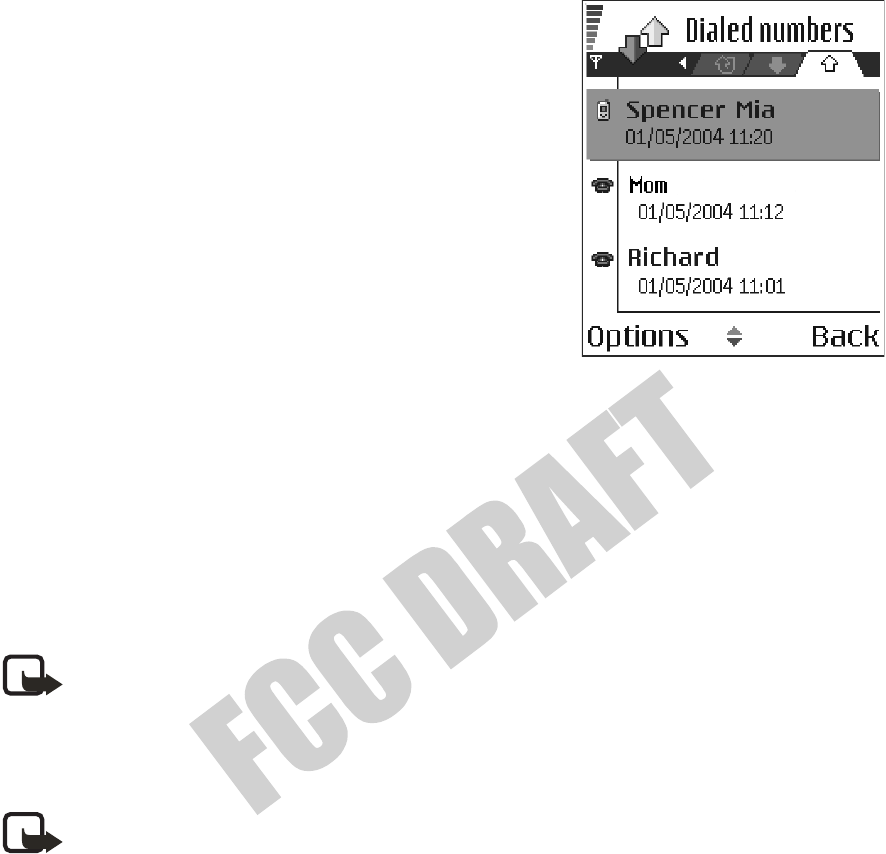
22 Copyright © 2004 Nokia
If you receive indication of missed calls while in the standby mode, press Show to
access the list of numbers. To call back, scroll to the number or name you want to
call, and press the Send key.
To view a list of the 20 numbers for calls most
recently accepted (network service), select Menu >
Log > Recent calls > Received calls.
Dialed numbers
To view the 20 phone numbers for the most recently
called or attempted, select Log > Recent calls >
Dialed numbers.
ERASE RECENT CALL LISTS
To clear all recent call lists, select Options > Clear
recent calls in the Recent calls main view.
To clear one of the call logs, open the log you want
to erase and select Options > Clear list.
To clear an individual event, open a log, scroll to the event, and press the Clear key.
Confirm by pressing Yes.
Call timers
Select Menu > Log > Call timers to view the duration of your incoming and
outgoing calls.
Note: The actual time invoiced for calls by your service provider may vary,
depending upon network features, rounding-off for billing, and so forth.
To erase call duration timers, select Options > Clear timers. For this you need the
lock code. See "Security" on page 64.
Note: Some timers may be reset during service or software upgrades.
GPRS data counter
Select Menu > Log > GPRS counter.
The GPRS data counter allows you to check the amount of data sent and received
during packet data (GPRS) connections. This may be helpful if your service provider
charges for GPRS connections based on the amount of data sent and received. The
actual amount invoiced by your service provider may vary depending on rounding,
taxes, or other factors.
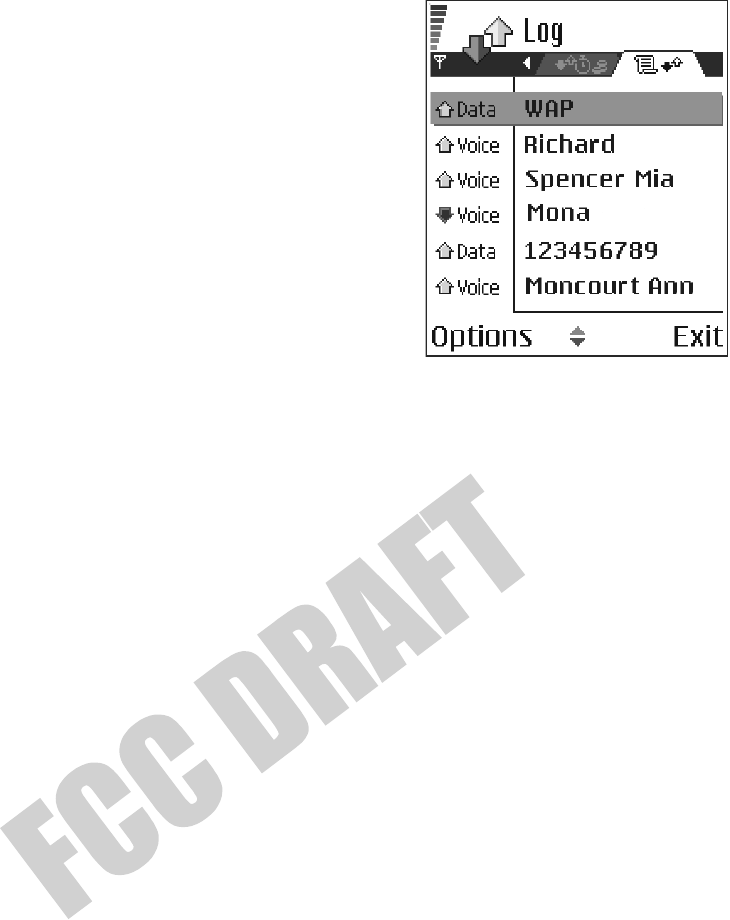
Nokia User GuideCopyright © 2004 Nokia
Your phone
View the general log
Select Menu > Log and scroll right.
In the general log, the sender or recipient name,
phone number, name of the service provider, or access
point is displayed for each communication event.
Events such as a text message sent in more than one
part and packet data connections, are logged as one
communication event.
FILTER THE GENERAL LOG
1Select Options > Filter. A list of filters opens.
2Scroll to a filter, and press Select.
ERASE THE CONTENTS OF THE GENERAL LOG
To erase all the log contents, recent calls log, and messaging delivery reports
permanently, select Options > Clear log. Select Yes to confirm.
PACKET DATA COUNTER AND CONNECTION TIMER
To view how much data, measured in kilobytes, has been transferred and how long
a certain GPRS connection has lasted, scroll to an incoming or outgoing event
labeled GPRS and select Options > View details.
Log settings
Select Menu > Log > Options > Settings to open the list of settings.
Log duration—The log events remain in the phone memory for a set number of
days after which they are automatically erased to free memory.
If you select No log, all the log contents, recent calls log, and messaging delivery
reports are permanently deleted.
Show call duration—Set to Yes or No. See "Call timers" on page 22.

24 Copyright © 2004 Nokia
5 Personal information
•CONTACTS
To open Contacts, press the center of the Scroll key in the standby
mode, or select Menu > Contacts.
In Contacts, you can store and manage contact information, such as
names, phone numbers, and addresses.
You can also add a personal ringing tone, voice tag, or a thumbnail image to a
contact card. You can create contact groups, which allow you to send text
messages or e-mail to many recipients with compatible devices at the same time.
Options in Contacts are Open, Call, Create message, New contact, Open conversation,
Edit, Delete, Duplicate, Add to group, Belongs to groups, Mark/Unmark, Copy to SIM
direct., Go to web address, Send, Contacts info, SIM directory, Service numbers,
Settings, Help, and Exit.
Create and edit contact cards
1Open Contacts and select Options > New contact. An empty contact card opens.
2Fill in the fields you want, and press Done.
The contact card is saved in the phone memory and closed, after which you
can see it in the contacts directory.
To edit contact cards, see “Common actions for all applications” on page 15.
Options when editing a contact card are Add thumbnail or Remove thumbnail, Add
detail, Delete detail, Edit label, Help, and Exit.
To delete contact cards, in the contacts directory, scroll to the contact card and
select Options > Delete.
To attach a small thumbnail image to a contact card, open a contact card, and
select Options > Edit > Options > Add thumbnail. The thumbnail image is also
shown when the contact is calling you. After you attach a thumbnail image to a
contact card, select Add thumbnail to replace the image with a different thumbnail
or Remove thumbnail to remove the thumbnail from the contact card.
To assign default numbers and addresses to a contact card, open the contact card,
and select Options > Defaults. A pop-up window opens, listing the different options.
Copy between SIM card and phone memory
To copy names and numbers from a SIM card to your phone, open Contacts, select
Options > SIM directory, scroll to the names you want to copy, and select
Options > Copy to Contacts.

Nokia User GuideCopyright © 2004 Nokia
Personal information
If you want to copy a phone, fax, or pager number from Contacts to your SIM card,
select Contacts, open a contact card, scroll to the number, and select Options >
Copy to SIM direct.
Add a ringing tone for a contact card or group
You can set a ringing tone for each contact card and group. When that contact or
group member calls you, the phone plays the chosen ringing tone (if the caller’s
telephone number is sent with the call and your phone recognizes it).
1Press the Scroll key to open a contact card; or scroll right to go to groups, and
select a contact group.
2Select Options > Ringing tone.
A list of ringing tones opens.
3Scroll to the ringing tone you wish to use for the contact or group, and
press Select.
4To remove the ringing tone, select Default tone from the list of ringing tones.
For an individual contact, the phone will always use the ringing tone that was
assigned last. If you change a group ringing tone, then the ringing tone of a single
contact that belongs to that group, the ringing tone of the single contact is used.
Voice dialing
You can make a phone call by saying a voice tag that has been added to a contact
card. Any spoken words can be a voice tag.
When recording, hold the phone at a short distance away from your mouth. After
the starting tone, say clearly the word, or words, you want to record as a voice tag.
REQUIREMENTS FOR VOICE TAGS
Before using voice dialing, note the following:
•Voice tags are not language-dependent. They are dependent on the
speaker's voice.
•You must say the name exactly as you said it when you recorded it.
•Voice tags are sensitive to background noise. Record voice tags, and use them
in a quiet environment.
•Very short names are not accepted. Use long names, and avoid similar names
for different numbers.
Note: Using voice tags may be difficult in a noisy environment or
during an emergency, so you should not rely solely upon voice dialing
in all circumstances.

26 Copyright © 2004 Nokia
ADD A VOICE TAG TO A PHONE NUMBER
Voice tags can only be added to phone numbers stored in phone memory. See "Copy
between SIM card and phone memory" on page 24.
1In Contacts, scroll to the contact to which you want to add a voice tag, and
press the Scroll key to open the contact card.
2Scroll to the number to which you want to add the voice tag, and select
Options > Add voice tag.
3Press Start to record a voice tag.
4After the starting tone, clearly say the words you want to use as a voice tag.
After recording, the phone plays the recorded tag, and Playing voice tag
is displayed.
When the voice tag has been successfully saved, Voice tag saved is displayed and
a beep sounds. A symbol can be seen next to the number in the contact card.
To replay, erase, or change a voice tag, scroll to the item that has a voice tag
(indicated by ), and select Options > Voice tag > Playback, Change, or Delete.
MAKE A CALL USING A VOICE TAG
1In the standby mode, press and hold the Right selection key.
A short tone is played, and Speak now is displayed.
2When you make a call by using a voice tag, hold the phone at a short distance
from your mouth, and say the voice tag clearly.
The phone plays the original voice tag, displays the name and number, and
dials the number of the recognized voice tag.
If the phone plays the wrong voice tag or if you want to retry voice dialing, press Retry.
Voice dialing should not be used when a data call or a GPRS connection is active
because the voice call will interrupt the connection.
Assign 1-touch dialing keys
1-touch dialing is a quick way to call frequently used numbers. You can assign
1-touch dialing keys to eight phone numbers. Number 1 is reserved for voice mail.
1Open the contact card for which you want a 1-touch dialing key, and scroll to
the phone number you want to add to 1-touch dialing.
2Select Options > Assign 1-touch no..
The 1-touch dialing grid opens, showing you the numbers from 2–9.
3Scroll to a number and press Assign. When you return to the contact
information view, the 1-touch dialing icon is displayed next to the number.
4To call the contact by 1-touch dialing in the standby mode, press the 1-touch
dialing key and Send key, or press and hold the 1-touch dialing key.

Nokia User GuideCopyright © 2004 Nokia
Personal information
View subscribed contacts
Select Menu > Contacts, and scroll to the second tab to open the subscribed
contacts list. This list allows you to view presence data, including availability and
IM status, for all subscribed contacts. See also “Presence (network service)” on
page 27 and “Instant messaging (IM) (network service)” on page 88.
Options in the subscribed contacts view are Open, Call, Create message, Open
conversation, Unsubscribe, Subscribe new, Mark/Unmark, My presence, Help, and Exit.
If you are not logged in to the presence service, you will see only a few of these options.
Manage contact groups
Select Menu > Contacts, and scroll to the third tab to open the contact groups list.
Options in the groups list view are Open, New group, Delete, Rename, Ringing tone,
Contacts info, Settings, Help, and Exit.
CREATE CONTACT GROUPS
1In the contacts directory, scroll to the groups tab.
2Select Options > New group.
3Write a name for the group, or use the default name Group 1, and press OK.
ADD MEMBERS TO A GROUP
1In the contacts directory, scroll to the contact you want to add to a group, and
select Options > Add to group.
A list of available groups opens.
2Select a group, and press the Scroll key to add the contact.
• PRESENCE (NETWORK SERVICE)
Select Menu > Presence.
Options in Presence are Open, My availability, Viewers, Update
presence, Login or Logout, Settings, Help, and Exit.
Use the presence service to inform others when, where, and how you want to be
contacted. Presence allows you to view and create a dynamic profile and share
information or control services. Presence information is visible to other users of the
service and can show where you are and what you are doing, as well as let others know
whether you are available and whether you prefer for people to call or send messages.
Before you can use the presence service, you must choose a service provider and save
the settings of that service. You may receive the settings in a special text message,
called a smart message, from the service provider that offers the presence service. See
"Smart messages" on page 49. For more information, contact your service provider.
Select Options > Login or Logout to log in and out of the presence service.
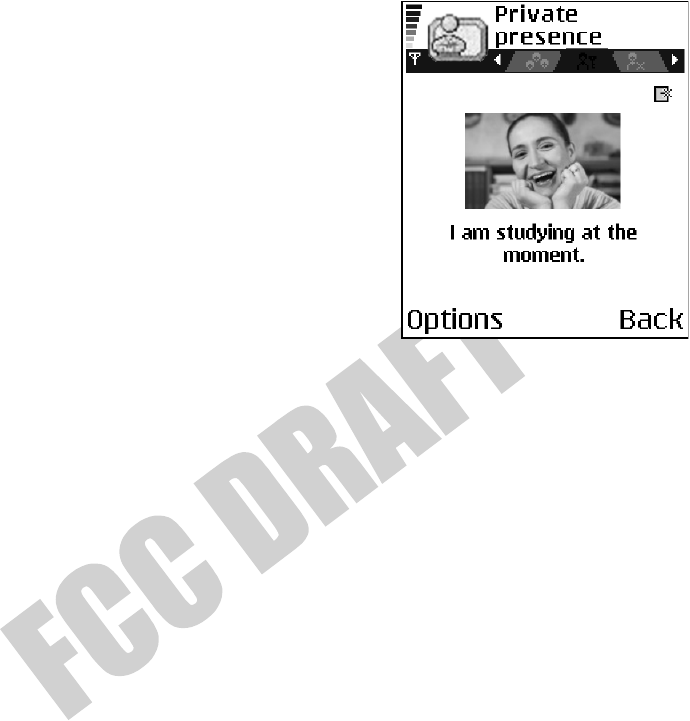
28 Copyright © 2004 Nokia
The presence application on your phone allows you to change your own published
information and determine who is authorized to see your presence. To view the
presence information of others, you must use the Contacts application. See "View
subscribed contacts" on page 27.
Change your availability
Select Options > My availability and one of
the following:
Available—You are available for people to call or
send you messages, for example, your phone is set to
Normal profile. See "Profiles" on page 73.
Busy—You may be available for people to call or
send you messages, for example, your phone is in
Meeting profile.
Not available—You are not available for people to
call or send you messages, for example, your phone
is in Silent profile.
Change your presence information
You can set up public, private, and blocked presence information, and define who
can view your information.
PUBLIC PRESENCE
Select Menu > Presence > Public pres. to change your public presence information.
This information is available to anyone you have not blocked. Select Options and
one of the following:
My availability—Select Available, Busy, or Not available.
Viewers—Open the Current viewers list to see the names, phone numbers, or user
IDs of the viewers whom you do not allow to view your private presence messages,
but who are currently viewing your public presence. You can scroll to a viewer,
press Options, and select from the following options:
•Add to private list—Allow the viewer to also see your private presence.
•Block—Prevent the viewer from seeing your presence information.
•Add to contacts—Add the viewer to your contacts directory.
•Refresh lists—Update the viewer lists. This option is only available when you
are not logged in to the presence service.
Login or Logout—Connect to or disconnect from the presence service.
Update presence—Update your presence information to the presence service.
Settings—Manage the publishing of your presence information.

Nokia User GuideCopyright © 2004 Nokia
Personal information
PRIVATE PRESENCE
Select Menu > Presence > Private pres. to change your private presence information.
This information is only available to those whom you have authorized to view your
private information. Select Options and one of the following:
My availability—Select Available, Busy, or Not available.
My presence msg.—Write a text message of up to 40 characters to describe your
current availability.
My presence logo—Add a logo to your availability information. Logo files are
stored in Gallery. See "Gallery" on page 40.
Viewers—Open your private presence viewers list to see the names, phone numbers,
or user IDs of the viewers whom you allow to view your private presence messages.
You can scroll to a viewer, press Options, and select from the following options:
•Add new—Add a new viewer manually or from your contacts directory. You
can only select a contact who has a user ID in the contact card.
•Block—Prevent the viewer from seeing your presence information.
•Add to contacts—Add the viewer to your contacts directory.
•Remove from list—Remove the viewer from the private list. This option is
available also when you mark several viewers in the list. If the list is empty, the
option is not available. You can also scroll to a viewer and press the Clear key
to prevent that viewer from seeing your private presence messages.
•View details—Show the user ID information of the viewer.
•Refresh lists—Update the viewer lists. This option is only available when you
are not logged in to the presence service.
Update presence—Update your presence information to the presence service.
Login or Logout—Connect to or disconnect from the presence service.
Settings—Manage the publishing of your presence.
BLOCKED PRESENCE
Select Menu > Presence > Blocked pres. to change your blocked presence
information. Blocked viewers will see a screen containing no personal details.
Select Options and one of the following:
Viewers—Open your blocked viewers list to see the names, phone numbers, or user
IDs of the viewers whom you have blocked from seeing your public or private
presence information. You can scroll to a viewer, press Options, and select from the
following options:
•Unblock—Remove the viewer from the blocked list. You can also unblock a
viewer by scrolling to the viewer and pressing the Clear key.
•Add to private list—Allow the viewer to also see your private presence.

30 Copyright © 2004 Nokia
•Add new—Add a new blocked viewer manually or from your contacts directory.
You can only select a contact who has a user ID in the contact card.
•Add to contacts—Add the viewer to your contacts directory.
•View details—Show the user ID information of the viewer.
•Refresh lists—Connect to the presence service to update the viewer lists. This
option is only available when you are not logged in to the presence service.
Update presence—Update your presence information to the presence service.
Login or Logout—Connect to or disconnect from the presence service.
Settings—Manage the publishing of your presence.
Update your information
Select Menu > Presence > Options > Update presence.
This option is only available when you are logged in to the presence service, have
changed your information in the Private Presence or Public Presence view, and
have not updated that presence information yet.
Presence settings
Select Options > Settings from the Presence main menu, and select from
the following:
Show presence to—Select from the following:
•Private & public—Both public and private presence is published.
•Private viewers—Only private viewers can see your presence information.
•Public viewers—Both public and private viewers see your public presence
information.
•No one—Your presence information is not published.
Sync. with Profiles—Defines whether your published presence information is
linked to your phone profile settings. When you choose an option other than Off,
be sure to define your profile presence information as well (see “Create and
customize profiles” on page 73). Select from the following:
•Off—Your presence information is not changed, even if you change your phone
profile setting.
•On—Both Availability and Private message are changed when you change
your phone profile setting.
•Availability only—Private message is not changed when you change your profile.
•Private msg. only—Availability is not changed when you change your
profile setting.
Server settings—Opens the Server settings menu in the IM feature. Select Presence
login type from this menu to designate when you want to log in to the presence
service. See “IM settings” on page 89 for further information on the login types.
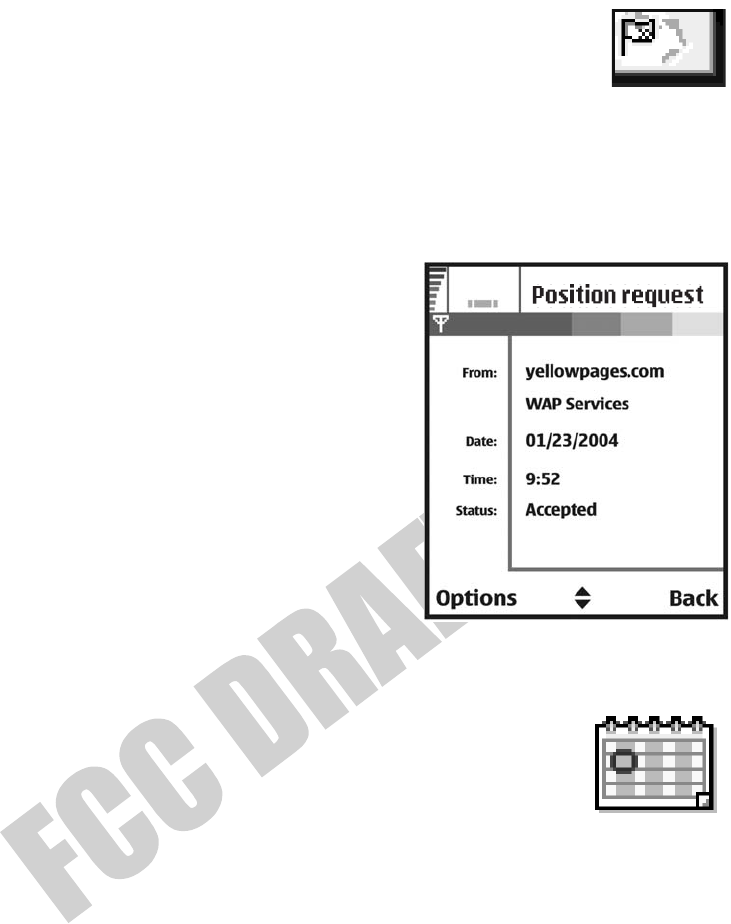
Nokia User GuideCopyright © 2004 Nokia
Personal information
• POSITIONING (NETWORK SERVICE)
Select Menu > Tools > Positioning.
Positioning allows the network to detect the position of your phone.
By enabling or disabling Positioning, you choose when your position information
is provided to the network.
To enable positioning in your phone, select Settings > Positioning > On. If you
need to enter a lock code, see “Security” on page 64.
When you receive a position request, a message
is displayed showing the service that is making
the request. Press Accept to allow your position
information to be sent, or press Reject to deny
the request.
Position request messages are logged in the Recv.
requests list. To view them, select Menu >
Positioning > Recv. requests. The icon beside each
request indicates whether the request is new,
rejected, or accepted. If you want to see details of a
request, scroll to the request, and press the center of
the Scroll key. If you want to clear the Recv.
requests list, select Options > Clear list.
•CALENDAR
In Calendar, you can keep track of your appointments, meetings,
birthdays, anniversaries, and other events. You can also set a
calendar alarm to remind you of upcoming events.
Create entries
1Select Menu > Calendar > Options > New entry and one of the
following options:
Meeting—Creates an appointment that has a specific date and time.
Memo—Creates a general entry for a day.
Anniversary—Creates a reminder for birthdays or special dates. Anniversary
entries are repeated every year.
2Fill in the fields, and scroll to move between fields.
Subject or Occasion—Write a description of the event.
Location—Indicates the place of a meeting (optional).
Start time, End time, Start date, and End date.
Alarm—Select On to display the Alarm time and Alarm date fields.

32 Copyright © 2004 Nokia
Repeat—Press the center of the Scroll key to change the entry to be repeating.
Shown with in the day view.
Repeat until—Set an ending date for the repeated entry, for example, the
ending date of a weekly course you are taking. This option is shown only if you
have selected to repeat the event.
Synchronization—
•Private—After synchronization the calendar entry can be seen only by you
and it will not be shown to others, even if they have online access to view
the calendar.
•Public—The calendar entry is shown to others who have access to view
your calendar online.
•None—The calendar entry will not be copied when you synchronize
your calendar.
3To save the entry, press Done.
When editing or deleting a repeated entry, choose how you want the changes to
take effect:
All occurrences—All repeated entries are changed.
This entry only—Only the current entry will be changed.
Calendar views
Press the #key in the month, week, or day views to automatically highlight
today’s date.
To key in a calendar entry, press any number key (1–0) in any calendar view. A meeting
entry is opened, and the characters you keyed in are added to the Subject field.
To go to a certain date, select Options > Go to date. Write the date, and press OK.
Icons in the day view are memo and anniversary.
Synchronization icons in the week and month views are red for private synchronization,
blue for public synchronization, pink for no synchronization, and black for more
than one synchronization entry in a day.
Calendar settings
Select Options > Settings and one of the following options:
Calendar alarm tone—Select a personalized alarm tone, or no tone at all.
Default view—Select the view that is shown first when you open Calendar.
Week starts on—Change the starting day of the week. If you change the settings so
that the week starts on a day other than Sunday, the week numbers will not be shown.
Week view title—Change the title of the week view to be the week number or the
week dates.

Nokia User GuideCopyright © 2004 Nokia
Personal information
Clear calendar memory
To remove more than one event at a time, go to the month view, and select Options >
Delete entry and one of the following:
Before date—Delete all calendar entries that take place before a certain date.
Enter the date before which all calendar entries will be deleted.
All entries—Delete all calendar entries.
•TO-DO
In the To-do list you can keep a list of tasks that you need to do. The
to-do list uses shared memory. See "Shared memory" on page 3.
1Select Menu > To-do.
2To start entering a to-do note, press any number key (1–0).
The editor opens, and the cursor blinks after the letters you have entered in
the Subject field.
3Finish entering the task in the Subject field.
4Scroll to the Due date field, and key in a date.
5To set a priority for the task, scroll to the Priority field, and select High,
Normal, or Low.
6To save the to-do note, press Done.
If you remove all characters from the Subject field and press Done, the note
will be deleted, even if you are editing a previously saved note.
To open a to-do note, scroll to it, and press the Scroll key.
To delete a to-do note, scroll to it, and select Options > Delete; or press the
Clear key, and select Yes to confirm.
To mark a to-do note as completed, scroll to it, and select Options > Mark as done.
To restore a to-do note, select Options > Mark as not done.
•COPY CONTENT FROM COMPATIBLE NOKIA PHONES
You can move calendar, contacts, and to-do data from compatible Nokia phones to
your phone using your PC and the PC Suite content copier application. Instructions for
using the application can be found in the help function of PC Suite on the CD-ROM.

34 Copyright © 2004 Nokia
6Multimedia
•CAMERA
You can use the camera to take pictures and record videos while on
the move. The images are automatically saved in Gallery, where you
can rename them and organize them in folders. You can also send
images and video recordings in a multimedia message, as an e-mail attachment, or
by Bluetooth connection. The camera produces JPEG images, and video clips are
recorded in the 3GPP file format with the .3gp file extension.
To be added: PhotoRing, PhotoMail, Still Image Editor, Office
Viewers, Access Browser
Take pictures
1Select Camera in the standby mode, or select Menu > Camera, and scroll left
to make sure you are on the Image tab.
The camera opens, and you can see the viewfinder and the cropping lines, which
show you the image area to be captured. You can also see the image counter,
which shows you how many images, depending on the selected picture quality,
fit in the memory of your phone or memory card, if you use one.
Options before taking a picture are Capture, New, Activate night mode or
Deact. night mode, Self-timer, Go to Gallery, Settings, Help, and Exit.
2Scroll up to zoom in on your subject before taking the picture; scroll down to
zoom out again.
The zoom indicator to the right of the display shows the zoom level. The
resolution of a zoomed picture is lower than that of a non-zoomed picture, but
the image remains the same size. You may notice the difference in image
quality if viewed on a PC.
3To take a picture, press the Scroll key.
Do not move the phone before the camera application starts to save the
image. The image is saved automatically in Gallery. See "Gallery" on page 40.
To take a photo immediately after another, select Options > Settings > Image
> Show captured image, then select No. The photos do not remain on the
display after being taken, are saved in the Gallery, and the camera is ready for
use again.
If camera images look smudgy, check that the camera lens protection window is
clean. See "Care and maintenance" on page 116.
The camera goes into battery saving mode if there have been no key presses within
a minute. To continue taking pictures, press the Scroll key.
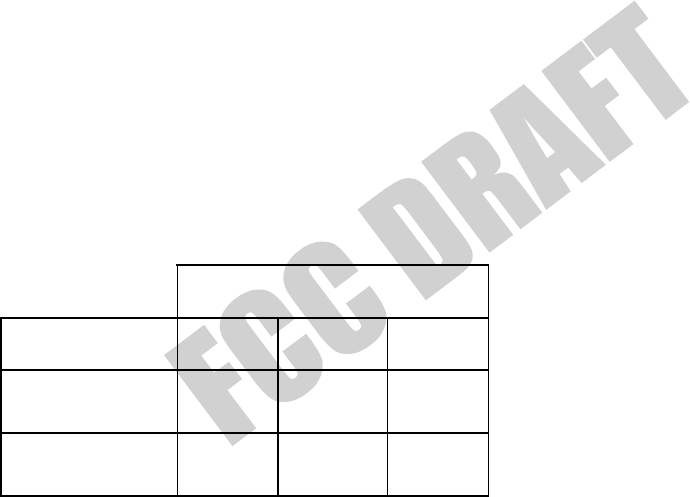
Nokia User GuideCopyright © 2004 Nokia
Multimedia
OPTIONS AFTER CAPTURING AN IMAGE
Options after a picture has been taken are New, Delete, Send, Set as wallpaper,
Rename image, Go to Gallery, Settings, Help, and Exit.
If you do not want to save the image, select Options > Delete.
To return to the viewfinder to take a new picture, press the Scroll key.
You can insert an image into a contact card. See "Create and edit contact cards"
on page 24.
SELF-TIMER
To include yourself in the picture, use the self-timer to delay the taking of a picture.
Select Options > Self-timer > 10 seconds, 20 seconds, or 30 seconds > Activate.
The camera takes the picture after the selected delay has elapsed.
IMAGES AND MEMORY CONSUMPTION
Your phone has approximately 8 MB of free memory for images, contact information,
calendar, messages, and so on. See "Shared memory" on page 3. Images taken using
the high-quality setting and those taken in night mode take up the most memory.
By using a memory card with your phone you can increase the number of images
you can store. To see how much memory is available on your phone and memory
card, see “View memory consumption” on page 70.
The following table shows approximately how many images would fit in 1 MB of
memory, depending on image type and quality:
Record videos
1Press Camera in the standby mode, or select Menu > Camera, and scroll right
to the Video tab.
Options before recording a video are Record, New, Activate night mode or
Deact. night mode, Mute, Go to Gallery, Settings, Help, and Exit.
2Press the Scroll key to start recording.
To pause recording at any time, press Pause. To resume, press Continue.
Scroll up to zoom in on your subject before or during recording; scroll down
to zoom out.
Image quality
Image type Basic Normal High
Standard 55 22 15
Night 50 25 18

36 Copyright © 2004 Nokia
3To stop recording, press Stop.
The video clip is saved to either phone memory or the memory card, depending on
the Memory in use setting. See "Camera and video settings" on page 36.
To immediately play the video clip you just recorded, select Options > Play.
To play previously saved video clips, go to Gallery. See "Gallery" on page 40.
Options after you have recorded a video are New, Play, Delete, Send, Rename, Go
to Gallery, Settings, Help, and Exit.
Camera and video settings
Select Menu > Camera > Options > Settings to adjust the settings for still image
captures and video recording. Select the following options:
Image—Adjust the settings for still images:
•Image quality—High, Normal, and Basic. The better the image quality, the
more memory the image consumes. See "Images and memory consumption"
on page 35.
•Show captured image—To take a photo immediately after another, select No.
The photos do not remain on the display after being taken, are saved in the
Gallery, and the camera is ready for use again.
•Default image name—Allows you to set a name for saved images. By default,
images are named Image(001), Image(002), Image(003), and so forth when
they are saved.
•Memory in use—Select whether you want to save your images in phone
memory or on the memory card, if you use one.
Video—Adjust the settings for recording videos:
•Length—Available recording time is displayed above the top right corner of
the viewfinder. Select one of the following video length options:
Maximum—Recorded video length is restricted by available memory.
Recordings can last up to 10 minutes, depending on available memory.
Short—Restricts video length to optimize it for MMS sending.
•Video resolution—Select 128x96 or 176x144.
•Default video name—Allows you to set a name for saved videos. By default,
videos are named Video(001), Video(002), Video(003), and so forth when
they are saved.
•Memory in use—Select whether you want to save your videos in phone
memory or on the memory card, if you use one.

Nokia User GuideCopyright © 2004 Nokia
Multimedia
• VIEW IMAGES
Pictures taken with the camera are stored as images in Gallery. See "Gallery" on
page 40.
Select Menu > Gallery > Images, and select an image. Press the Scroll key to
display the image.
In the images thumbnail view:
1Scroll right or left to move between the phone and memory card.
2To browse the list of images, scroll up and down.
3Press the Scroll key to open an image. When the image is open, you can see
the name of the image.
When viewing an image, scroll right or left to go to the next or previous image in
the current folder.
Options when viewing an image are Send, Set as wallpaper, Rotate, Zoom in, Zoom
out, Full screen, Delete, Rename, View details, Add to ’Go to’, Help, and Exit.
You can view animated GIF files in the same way as other images.
Zoom on a saved image
1Select Options > Zoom in or Zoom out.
You can see the zooming ratio at the top of the display. See "Keyboard
shortcuts" on page 37.
2Press Back to return to the initial view.
The zooming ratio is not stored permanently.
If you zoom in on GIF animations while they are playing, the animation will freeze
until normal zoom is resumed, when play will continue.
FULL SCREEN
When you select Options > Full screen, the panes around the image are removed
so that you can see more of the image. Press the Right selection key to return to
the initial view.
MOVE THE FOCUS
When you are zooming an image, use the Scroll key to move the focus to the left,
right, up, or down, so that you can take a closer look at one part of the image, for
example, its upper right corner.
Keyboard shortcuts
1 key—Rotate image 90 degrees counterclockwise.
3 key—Rotate image 90 degrees clockwise.
5 key—Zoom in.

38 Copyright © 2004 Nokia
0 key—Zoom out.
* key—Change between full screen and normal view.
Scroll key—Scroll up, down, left, right.
When you rotate an image, the rotation status is not stored permanently.
•PLAYER
Select Menu > RealPlayer.
With RealPlayer, you can play local media files stored in the phone memory or
memory card, or stream media files over the air from a streaming link. The
streaming link can be activated during a browsing session or stored in the phone
memory or memory card.
Media files are video, music, or audio clips. Files with the extensions .3gp, .amr,
.mp4, .ra, .rv, .rm, and .ram are supported by RealPlayer.
RealPlayer does not support all file formats or all the variations of a file format. For
example, RealPlayer will attempt to open all .mp4 files. However, some .mp4 files
may include content that is not compliant with 3GPP standards and, therefore, is
not supported by this phone. In this case, the operation might fail and result in
partial playback or in an error message.
Play media files
Options in RealPlayer are Play, Pause, Continue, Stop, Mute, Unmute, Clip details,
Settings, Help, and Exit. The available options may vary.
To play a media file, select Menu > RealPlayer > Options > Open and one of the
following:
Most recent clips—Play one of the last six files played in RealPlayer.
Saved clip—Scroll to a file in phone memory or on memory card, and press the
Scroll key to play the file.
Mem. card sound clips—Create a track list from all sound files on the memory
card. When you create a track list this way, the first song in the list automatically
begins playing.
STREAM CONTENT OVER THE AIR
•Select a streaming link saved in Gallery. Before your live content begins
streaming, your phone will connect to the site and load the file.
•Open the link to a file in the browser.
To stream live content, you must first configure your default access point. See "Access
points" on page 60. For the default access point, some service providers will require
you to use an access point defined in your phone. Other service providers allow you to
use a WAP access point. Contact your service provider for more information.
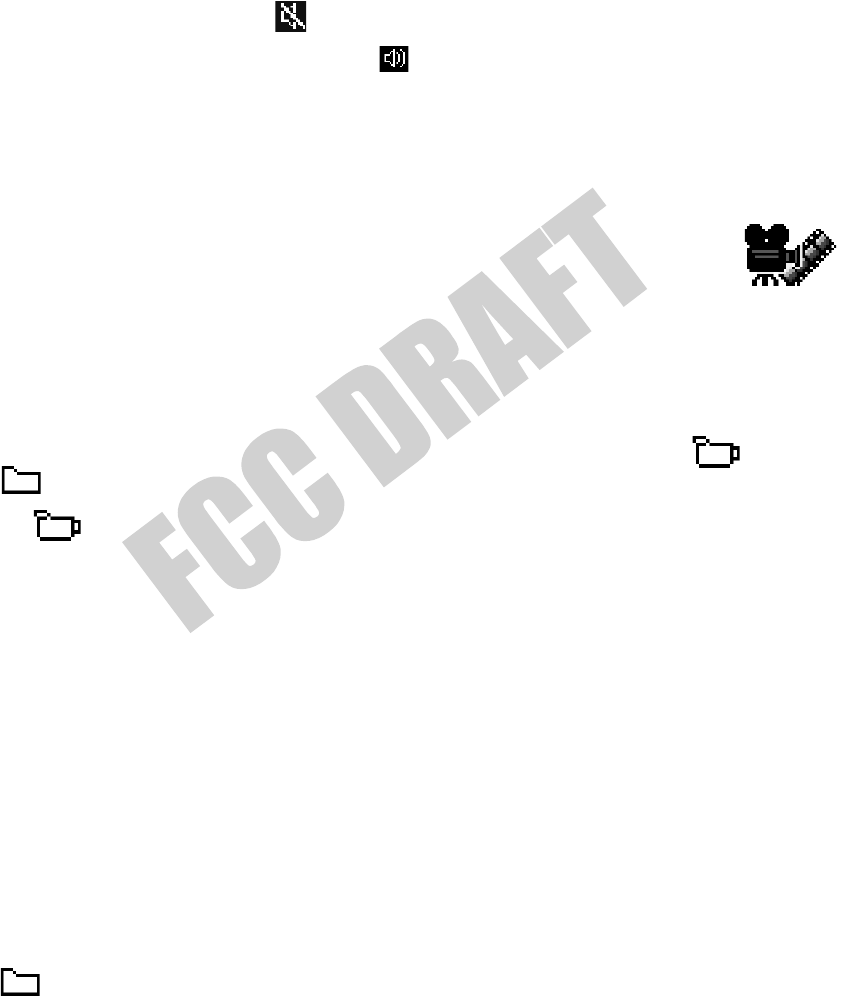
Nokia User GuideCopyright © 2004 Nokia
Multimedia
In RealPlayer, you can only open an rtsp:// URL address. You cannot open an
http:// URL address. However, RealPlayer will recognize an http link to a .ram file
since a .ram file is a text file containing an rtsp link.
SHORTCUTS DURING PLAY
When a media file is playing, use the Scroll key to seek (move quickly through the
media file), and to mute the sound, as follows:
Scroll up and hold to seek forward, or scroll down and hold to seek backward
through the media file.
Scroll left and hold until the indicator is displayed to mute the sound.
Scroll right and hold until you see the indicator to turn on the sound.
Change settings
Select Options > Settings > Audio, Video, or Connection.
• MOVIE DIRECTOR
Select Menu > Movie.
Use Movie director to create edited video clips that may contain
video, sound, and text. Editing is carried out automatically according to the style
that you select. The style determines the transitions and visual effects that are used
in the video clip.
Open Movie director, and scroll right or left to move between the tab and
the tab.
In the tab, you can select the following options:
Quick muvee—Create video clips suitable to be sent by multimedia message. You
can select several video clips and the style you want to apply to them. The duration
of the Quick muvee video clip is typically less than 10 seconds.
Custom muvee—Create custom video clips by applying a style, music, and a message.
You can set the duration and preview the video clip before saving. To create a
custom movie, see “Create a custom movie” on page 40.
Style downlds.—Download and install new styles.
Settings—Select the setting you want to change:
•Memory in use—Select Phone memory or Memory card.
•Resolution—Select High, Low or Automatic.
•Default muvee name—Enter a default name for your video clips.
The tab contains a list of video clips that you can Play, Send, Rename, and Delete.
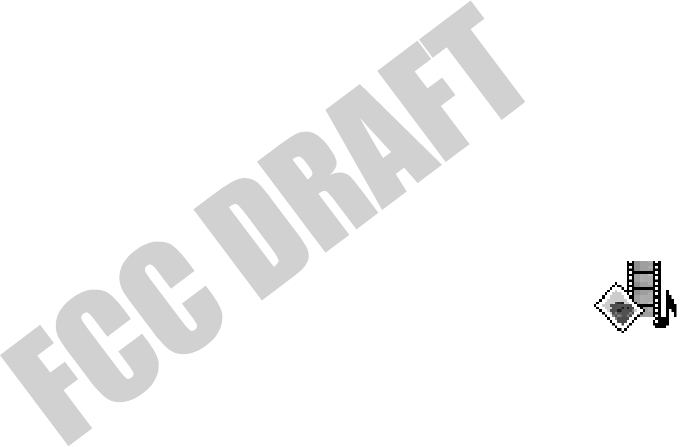
40 Copyright © 2004 Nokia
Create a custom movie
1Select Menu > Movie > Custom muvee. Define the following items:
•Video—Select the source file or files you want to use. Select Mark/
Unmark, Play, or Capture.
•Style—Select a style from the list. Styles determine the effects and message
caption. Each style is associated with default music and message text.
•Music—Select a music clip from the list.
•Message—Add a caption to the beginning and end of the video clip. You
can enter a message or select one from the template. You can edit the
default message text.
2Select Options > Create muvee.
3Select one of the following durations for the video clip:
•Multimedia message to create a video size suitable to be sent by MMS
•Same as music to create a video of the same duration as the selected
music clip
•User defined to enter the video duration manually.
After the video preview is prepared, the Preview muvee view opens, where you can
Play, Save the new video clip, and Recreate (to make a new variation of the video clip).
• GALLERY
Select Menu > Gallery.
Options in Gallery are Open (folder or item), Send, Delete, Create new,
Move to folder, Copy to folder, New folder, Mark/Unmark, Edit, Rename, Gallery
downloads, Image uploader, View details, Add to ’Go to’, Settings, Help, and Exit.
Use Gallery to store and organize your images, sound clips, video clips, and
streaming links.
Open Gallery to see a list of the folders in the phone memory. Scroll right to see
the folders on the memory card, if a memory card is installed.
Scroll to Images, Sound clips, Video clips, or another folder that you have created,
and press the Scroll key to open it.
The open folder displays the following information:
•An icon depicting the type of each file in the folder, or in the case of an image,
a small thumbnail picture giving a preview of the image
•The name of the file
•The date and time a file was saved or the size of the file

Nokia User GuideCopyright © 2004 Nokia
Multimedia
•Subfolders, if present
You can browse, open, and create folders; and you can mark, copy, and move items
to folders. See "Common actions for all applications" on page 15. The options vary
according to the content of the list of media files.
Open files
Select any file and press the Scroll key to open it. Each file will open in its
corresponding application as follows:
•Images files open in the image viewer. See "View images" on page 37.
•Sound clips open and play in the music player.
•Video clips and streaming links open and play in RealPlayer. See "Player" on
page 38.
•Subfolders open to display contents.
Default images folders
Select Gallery > Images. The Images folder is the default location where your
phone saves images taken with the camera. Within the Images folder, there are
additional default folders called Picture msgs., Presence logos, and Wallapers.
PICTURE MESSAGES FOLDER
Select Gallery > Images > Picture msgs..
Use this folder to store pictures sent to you in picture messages. To save a picture
that you have received in a picture message, select Messaging > Inbox, open the
message, and select Options > Save picture.
Options in the picture messages folder are Open, Send, Delete, Mark/Unmark,
Rename, View details, Help, and Exit.
PRESENCE LOGOS FOLDER
Select Gallery > Images > Presence logos.
Use this folder to store logos for Presence. See "Presence (network service)" on
page 27.
WALLPAPERS FOLDER
Select Gallery > Images > Wallpapers.
Use this folder to store pictures that you want to use as background images.

42 Copyright © 2004 Nokia
Download files
To download files into Gallery using the browser, select Options > Gallery
downloads > Graphic downloads, Video downloads, or Tone downloads. The
browser opens and you can choose a bookmark for the site from which to
download. See "Bookmarks" on page 99.
To download files, you must configure your default access point. See "Access
points" on page 60.
Once items have been downloaded, the browser closes, and the phone returns
to Gallery.
Upload images to an image server (network service)
You can send your pictures to an image server to allow others to share your pictures
online. Before you can upload images, you must set up the image server; you can
get the specific settings from your service provider:
1Select Settings > Image servers, and press the Left selection key.
2Fill in the details for each field. (See “Access points” on page 60.)
3Press the Right selection key.
To upload images:
1Select Options > Image uploader.
2To begin an upload, mark the images that you want to upload, and select Upload.
3Enter a name for the folder on the image server in which the images will be
stored, and press the Left selection key.
Track lists for audio files
You can create a track list to play audio files on your phone. Select Menu >
Gallery > Options > Create new > Track list, and follow the screen prompts to
select sound clips for the track list. To add multiple tracks at one time, press the
Edit key and the Scroll key simultaneously to place a checkmark beside each track
you want to add, and select Options > Select marked items.
To play a track list, select Menu > Gallery and locate the track list in phone
memory or on the memory card. Scroll to the track list, and press the Scroll key to
begin playing it.
To modify a track list, locate the track list in Gallery, and select Options > Edit
track list > Options > Add sound clip.
To delete clips, open the track list, scroll to a clip, and select Options > Delete.
Options when the track list is playing are Pause, Edit track list, Clip details, Settings,
Help, and Exit.
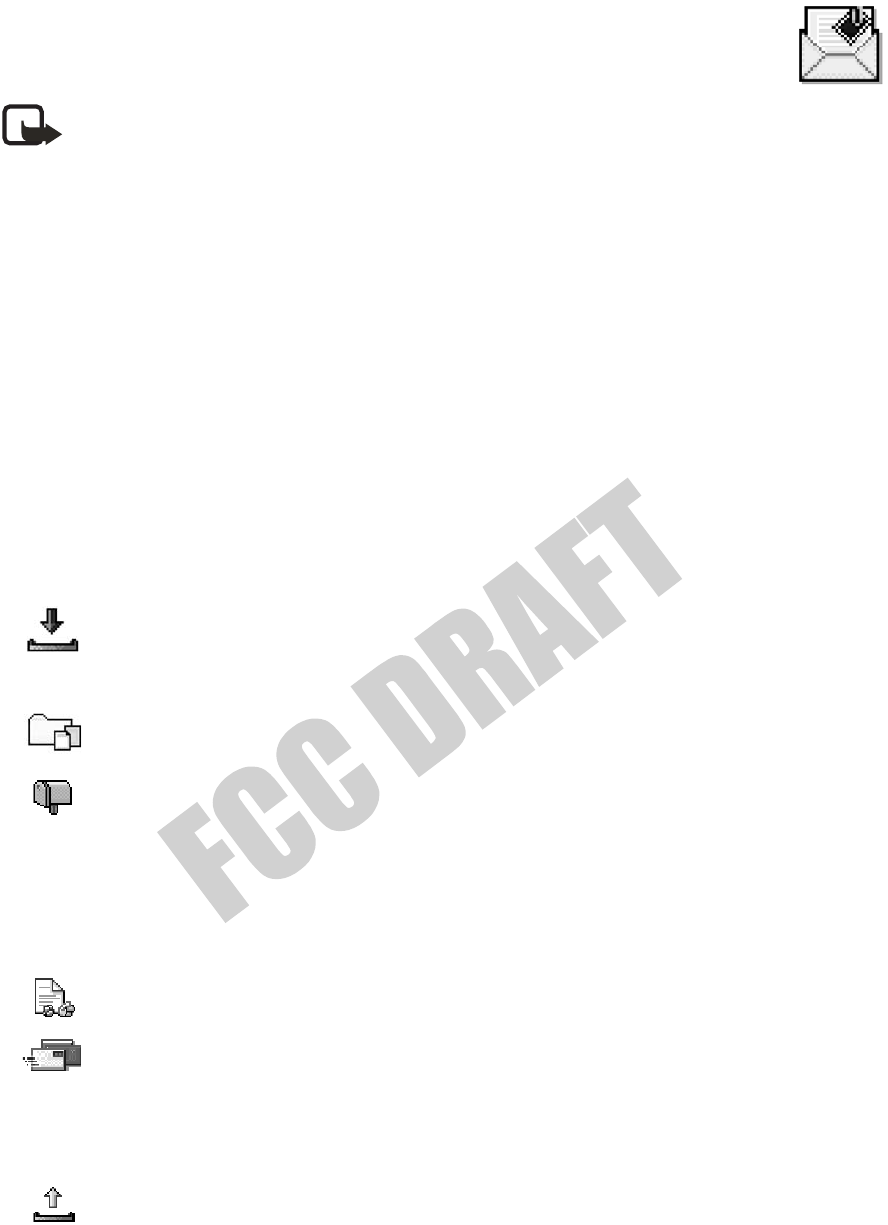
Nokia User GuideCopyright © 2004 Nokia
Messaging
7Messaging
Note: This function can only be used if it is supported by your
network operator or service provider. Only devices that offer compatible
picture message, multimedia message, or e-mail features can receive and
display these messages. Devices that do not have multimedia features may
receive details of a link to a web page.
Select Menu > Messaging.
In Messaging you can create, send, receive, view, edit, and organize:
•Text messages
•Multimedia messages (MMS)
•E-mail messages
•Smart messages
When you open Messaging, you can see the New message selection and a list of
default folders:
Inbox—Contains received messages except e-mail and cell broadcast
messages. E-mail messages are stored in Mailbox. You can read cell
broadcast messages by selecting Options > Cell broadcast.
My folders—For organizing your messages into folders.
Mailbox—When you open this folder, you can either connect to your
remote mailbox to retrieve your new e-mail messages, or you can view
your previously retrieved e-mail messages without logging in to the
e-mail server. After you have defined settings for a new mailbox, the
name given to that mailbox will replace Mailbox in the main view. See
"E-mail" on page 55.
Drafts—Stores drafts of messages that have not been sent.
Sent—Stores the last 20 messages that have been sent. To change the
number of messages to be saved, see “Other settings” on page 57.
Messages or data that have been sent by a Bluetooth connection are
not saved in the Draft or Sent folders.
Outbox—Temporary storage place for messages waiting to be sent.
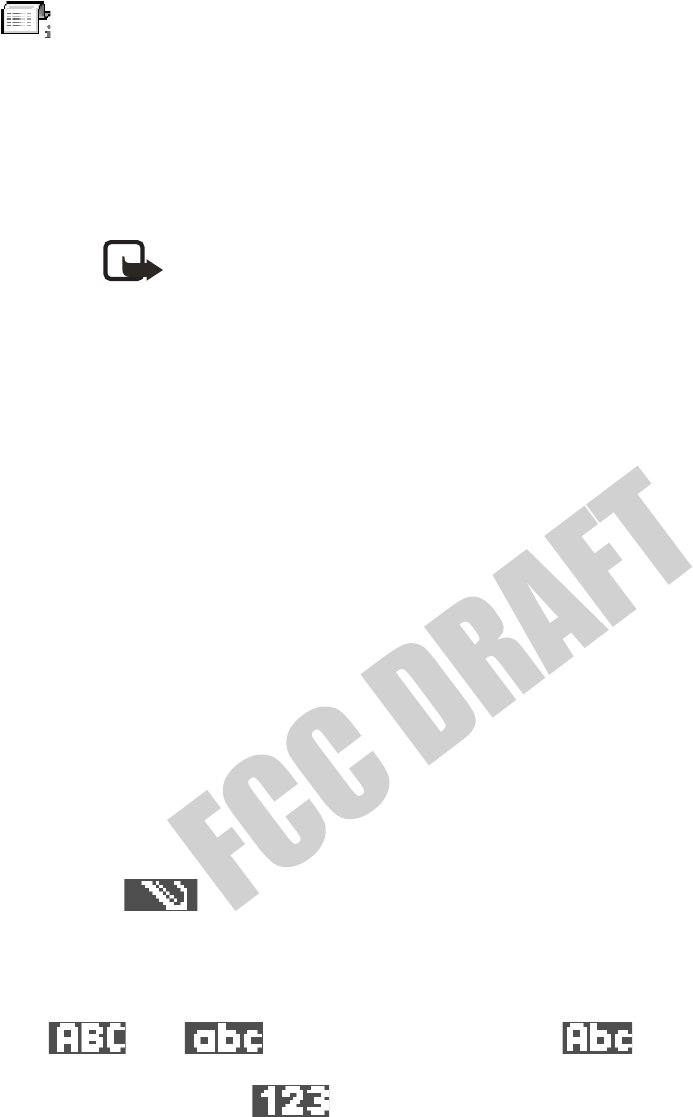
44 Copyright © 2004 Nokia
Messaging options are Create message, Connect (shown if you have defined settings
for the mailbox) or Disconnect (shown if there is an active connection to the
mailbox), SIM messages, Cell broadcast, Service command, Settings, Help, and Exit.
• WRITE TEXT
You can key in text in two different ways, using the method traditionally used in
mobile phones or another method called predictive text input.
Traditional text input
The indicator is shown on the top right of the display when you are writing
text using traditional text input.
Press a number key (1–9), repeatedly until the desired character appears. Note that
there are more characters available for a number key than are printed on the key.
Icons: and indicate the selected case. means that the first
letter of the next word is written in upper case, and all other letters will automatically
be written in lower case. indicates number mode.
To insert a number, press and hold the corresponding number key.
To switch between letter and number mode, press and hold the #key.
If the next letter is located on the same key as the present one, wait until the cursor
appears (or scroll right to end the time-out period), and key in the letter.
If you make a mistake, press the Clear key to remove a character. Press and hold
the Clear key to clear more than one character.
Reports (network service)—You can request that the network send you
a delivery report of the text messages, smart messages, and multimedia
messages you have sent. To turn on delivery report reception, go to the
Messaging main menu, select Options > Settings > Text message or
Multimedia message, and select Receive report > Yes.
It might not be possible to receive a delivery report of a multimedia
message that has been sent to an e-mail address.
Note: When sending messages, your device may display the
words Message Sent. This is an indication that the message has
been sent by your device to the message center number
programmed into your device. This is not an indication that the
message has been received at the intended destination. For more
details about messaging services, check with your service provider.
Before you create a multimedia message, write an e-mail, or connect to
your remote mailbox, you must have the correct connection settings in
place. See "Write and send messages" on page 47. See "Settings needed
for multimedia messaging" on page 48.
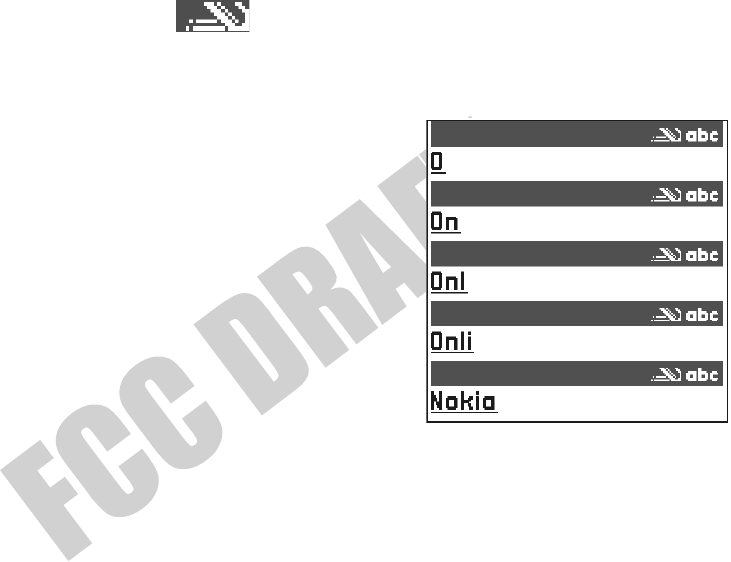
Nokia User GuideCopyright © 2004 Nokia
Messaging
The most common punctuation marks are available under the 1key. Press the 1key
repeatedly to reach the desired punctuation mark. You can also press the *key to
open a list of special characters. Scroll through the list, and press Select to select
a character.
To insert a space, press the 0key. To move the cursor to the next line, press the
0key three times.
To switch between upper and lower case, press the #key.
Predictive text input
To activate predictive text input, press the Edit key and select Predictive text on, or
press the #key twice quickly when writing text. This will activate predictive text input
for all editors in the phone. The indicator is shown at the top of the display.
1Write the desired word by pressing the keys 2–9. Press each key only once for
one letter. The word changes after every key press.
For example, to write Nokia when the English
dictionary is selected, press the following keys:
6 key for N
6 key for o
5 key for k
4 key for i
2 key for a
The word suggestion changes after each key press.
2When you have finished the word, check that it is correct.
If the word is correct, confirm it by scrolling right or by pressing the 0key to
insert a space. The underlining disappears and you can begin to write a new word.
If the word is not correct, you have the following options:
•Press the *key repeatedly to view the matching words the dictionary has
found one by one.
•Press the Edit key, and select Predictive text > Matches to view a list of
matching words. Scroll to the word you want to use, and press the
Scroll key to select it.
If the ? character is shown after the word, the word you intended to write is
not in the dictionary. To add a word to the dictionary, press Spell, key in the
word (up to 32 letters) using traditional text input, and press OK. The word is
added to the dictionary. When the dictionary becomes full, a new word
replaces the oldest added word.
To remove the ? and clear characters one by one from the word, press the
Clear key.

46 Copyright © 2004 Nokia
TIPS ON PREDICTIVE TEXT INPUT
Erase a character—Press the Clear key. Press and hold the Clear key to clear more
than one character.
Change between the different character cases—Press the #key to change
between the character cases Abc (), abc (), and ABC (). Note
that if you press the #key twice quickly the predictive text input is turned off.
Insert a number in letter mode—Press and hold the desired number key, or press
the Edit key, and select number mode. Key in the numbers you want, and press OK.
Insert symbols and punctuation marks—
•The most common symbols and punctuation marks are available under the
1key. Press the 1key repeatedly to find the desired entry.
•Press and hold the *key to open a list of special characters. Scroll through the
list, and press Select to select a character; or press the Edit key, and select
Insert symbol.
The predictive text input will try to guess which commonly used punctuation mark
(.,?!‘) is needed. The order and availability of the punctuation marks depend on the
language of the dictionary.
Choose from multiple entries—Press the *key repeatedly to view the matching
words the dictionary has found one by one.
Choose predictive text options—When a word has been entered with predictive text
on, press the Edit key, select Predictive text, and select one of the following options:
•Matches—View a list of words that correspond to your key presses. Scroll to
the desired word, and press the Scroll key.
•Insert word—Add a word (up to 32 letters) to the dictionary by using traditional
text input. When the dictionary becomes full, a new word replaces the oldest
added word.
•Edit word—Open a view where you can edit the word. This option is available
only if the word is active (underlined).
•Off—Turn off predictive text input for all editors in the phone.
WRITE COMPOUND WORDS
Write the first half of a compound word, and confirm it by scrolling right. Write the
last part of the compound word, and press the 0key to add a space to complete
the compound word.
Copy and paste text
If you want to copy text to the clipboard, the following is the easiest method:
1To select letters and words, press and hold the Edit key.
At the same time, scroll right or left. As the selection moves, text is highlighted.

Nokia User GuideCopyright © 2004 Nokia
Messaging
To select lines of text, press and hold the Edit key. At the same time
scroll down or up.
2To end the selection, release the Scroll key while holding the Edit key.
3To copy the text to the clipboard while still holding the Edit key, press Copy;
or release the Edit key, and press it once to open a list of editing commands,
for example, Copy or Cut.
If you want to remove the selected text from the document, press the Clear key.
4To paste the text into a document, press and hold the Edit key, and press Paste;
or press the Edit key once, and select Paste.
• WRITE AND SEND MESSAGES
Before you can create a multimedia message, write an e-mail message, or connect
to your remote mailbox, you must have the correct connection settings in place.
See “Settings needed for multimedia messaging” on page 48.
Options in the text message editor are Send, Add recipient, Insert, Delete, Check
names, Message details, Sending options, Help, and Exit.
1Select New message and one of the following options:
Text message—Create and send a text message.
To send a picture message, select Options > Insert > Picture. Each picture
message is made up of several text messages. Therefore, sending one picture
message may cost more than sending one text message.
Multimedia message—Create and send a multimedia message (MMS).
Copyright protections may prevent some images, ringtones, and other content
from being copied, modified, transferred, or forwarded.
E-mail—Create and send an e-mail. If you have not set up your e-mail
account, you will be prompted to do so.
2Press the Scroll key to select recipients from the contacts directory, or write
the phone number or e-mail address of the recipient in the To field if you are
sending an MMS or e-mail to the recipient. Press the #key to add a semicolon (;)
to separate each recipient.
3Scroll to the message field.
4Write the message.
Your device supports the sending of text messages beyond the normal 160-
character limit. If your message exceeds 160 characters, it will be sent as a series
of two or more messages.
In the navigation bar, you can see the message length indicator counting
backwards from 160. For example, 10 (2) means that you can still add 10
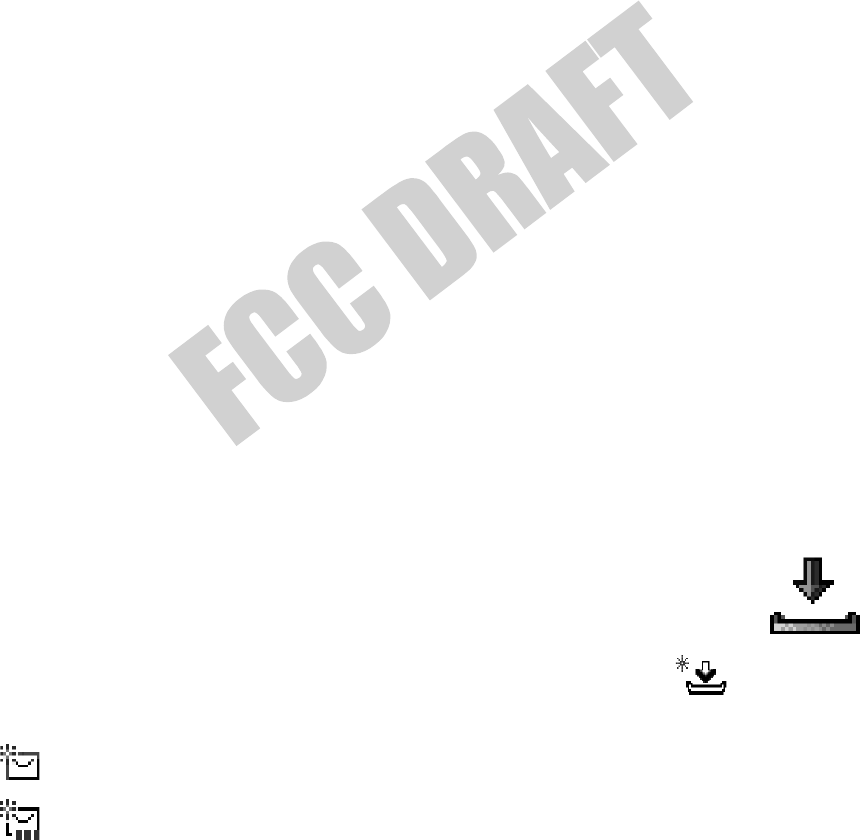
48 Copyright © 2004 Nokia
characters for the text to be sent as two messages. Using special (Unicode)
characters such as ë, â, á, ì will take up more space.
To add a media object to a multimedia message, select Options > Insert new >
Image, Sound clip, Video clip, or Slide. Select the item you wish to add.
5To send the message, select Options > Send, or press the Send key.
Settings needed for multimedia messaging
You may receive the settings as a smart message from your network operator or
service provider. See "Smart messages" on page 49.
For availability of and subscription to data services, contact your network operator
or service provider.
Select Messaging > Options > Settings > Multimedia message > Access point in
use and select the access point you created. See "Multimedia messages" on page 54.
Settings needed for e-mail
Before you can send, receive, retrieve, reply to, and forward e-mail to a separate
e-mail account, you must:
•Configure an Internet access point (IAP). See "Connection" on page 60.
•Define your e-mail settings. See "E-mail" on page 55.
Follow the instructions given by your remote mailbox and Internet service provider.
• VIEW A MULTIMEDIA PRESENTATION
When you receive a multimedia message that includes a presentation, select Play
presentation. The presentation opens and starts.
A multimedia message containing presentation content can still be viewed as a
standard multimedia message.
Objects within the presentation may not start automatically. If, for example, a
video does not play when the presentation starts, move to the video clip object, and
press the Scroll key. All objects can be selected individually and opened.
• INBOX—RECEIVE MESSAGES
Options in Inbox are Open, Create message, Reply, Delete, Message
details, Move to folder, Mark/Unmark, Help, and Exit.
When there are unread messages in Inbox, the icon changes to .
In Inbox, the message icons indicate the kind of message:
An unread text message
An unread smart message
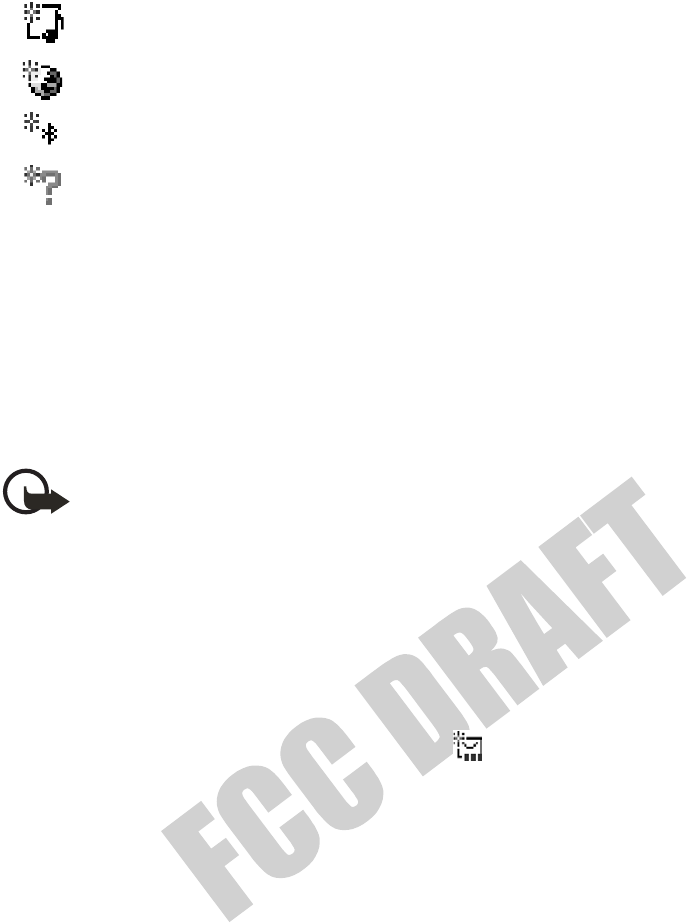
Nokia User GuideCopyright © 2004 Nokia
Messaging
View multimedia objects
Options in Objects are Open, Save, Send, Help, and Exit.
To see the available media objects in the multimedia message, open the message,
and select Options > Objects. In Objects you can view files that have been
included in the multimedia message. You can choose to save the file in your phone
or send it, for example, by Bluetooth connection to another compatible device.
Important: Multimedia message objects may contain viruses or be
harmful to your device or PC. Do not open any attachment if you are not
sure of the trustworthiness of the sender.
See "Certif. management" on page 65.
Smart messages
Your phone can receive many kinds of smart messages; text messages that contain
data (also called over-the-air (OTA) messages). To open a received smart message,
open Inbox, scroll to the smart message ( ), and press the Scroll key.
Picture message—Saves the picture in the Picture messages folder in Gallery for
later use; select Options > Save picture. If you receive a business card file that has
a picture attached, the picture will be saved to Contacts as well.
Business card—Saves the contact information; select Options > Save business card.
If certificates or sound files are attached to business cards, they will not be saved.
Ringing tone—Saves the ringing tone to Gallery; select Options > Save.
Operator logo—Saves the logo; select Options > Save. The operator logo can now
be seen in the standby mode instead of the network operator’s own identification.
Calendar entry—Saves the entry to Calendar; select Options > Save to Calendar.
Web message—Saves the bookmark; select Options > Save to bookmarks. The
bookmark is added to the Bookmarks list in browser services.
If a message contains both browser access point settings and bookmarks, to save
the data, select Options > Save all; or to view the bookmark and access point
information separately, select Options > View details. If you do not want to save
all data, select a setting or bookmark, open the details, and select Options > Save
to Settings or Save to bookmarks, depending on what you are viewing.
An unread multimedia message
An unread service message
Data received by Bluetooth connection
An unknown message type
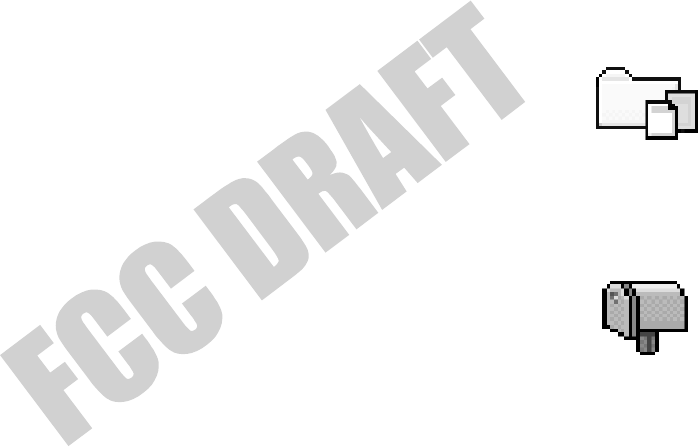
50 Copyright © 2004 Nokia
E-mail notification—Tells you how many new e-mails you have in your remote
mailbox. An extended notification may list more detailed information such as
subject, sender, attachments, and so on.
Wallet—Receives payment cards, loyalty cards, access cards, address cards, RFIDs,
and tickets.
In addition, you can receive a text message service number; voice mail number;
profile settings for remote synchronization; access point settings for the browser,
multimedia messaging, or e-mail; presence and IM settings; access point login
script settings; or e-mail settings. To save the settings, select Options > Save to
SMS sett., Save to Voice mail, Save to Settings, or Save to e-mail sett.
Service messages (network service)
Service messages can be, for example, notifications of news headlines, and they
may contain a text message or address of a browser service. For availability and
subscription, contact your service provider.
• MY FOLDERS
In My folders you can organize your messages into folders, create new
folders, and rename and delete folders.
You can use Templates to create text templates for messages that you send often.
To create a new template, select Options > New template.
• REMOTE MAILBOX (NETWORK SERVICE)
When you open this folder, you can connect to your remote mailbox to
do the following:
•Retrieve new e-mail headings or messages.
•View your previously retrieved e-mail headings or messages without logging
in to the e-mail server.
If you select New message > E-mail in Messaging, and you have not set up your
e-mail account, you will be prompted to do so. See "Write and send messages" on
page 47.
When you create a new mailbox, the name you give to the mailbox automatically
replaces Mailbox in Messaging. You can have up to six mailboxes.
Open the mailbox
When you open the mailbox, you can choose whether you want to view the previously
retrieved e-mail messages and e-mail headings with or without connecting to the
e-mail server.

Nokia User GuideCopyright © 2004 Nokia
Messaging
When you scroll to your mailbox and press the Scroll key, Connect to mailbox?
appears. Select Yes to connect to your mailbox or No to view previously retrieved
e-mail messages while not logged in to the e-mail server.
Another way to start a connection is to select Options > Connect.
Retrieve e-mail messages
If you are not logged in to the e-mail server, select Options > Connect to start a
connection to a remote mailbox.
1When you have an open connection to a remote mailbox, select Options >
Retrieve e-mail and one of the following:
New—Retrieve all new e-mail messages to your phone.
Selected—Retrieve only the e-mail messages that have been marked. Use the
Mark/Unmark > Mark or Unmark commands to select messages one by one.
See "Common actions for all applications" on page 15.
All—Retrieve all messages from the mailbox.
To cancel retrieving, press Cancel. After you have retrieved the e-mail messages,
you can continue viewing them online.
2Select Options > Disconnect to close the connection and view the messages
offline from the e-mail server.
3To open an e-mail message, scroll to the e-mail you want to view, and press
the Scroll key.
If the e-mail message has not been retrieved (arrow in the icon is pointing
outwards) and you are offline from the e-mail server, and select Open, you will
be asked if you want to retrieve this message from the mailbox.
To view e-mail attachments, open a message that has the attachment
indicator , and select Options > Attachments. In Attachments, you can
retrieve, open, or save attachments in supported formats. You can also send
attachments by Bluetooth connection.
Important: E-mail attachments may contain viruses or otherwise be
harmful to your device or PC. Do not open any attachment if you are not
sure of the trustworthiness of the sender.
If your mailbox uses the IMAP4 protocol, you can decide whether to retrieve e-mail
headings only, messages only, or messages and attachments. With the POP3
protocol, the options are e-mail headings only or messages and attachments. See
"E-mail" on page 55.
Delete e-mail messages
To delete an e-mail from the phone while still retaining it in the remote mailbox,
select Options > Delete > Phone only.
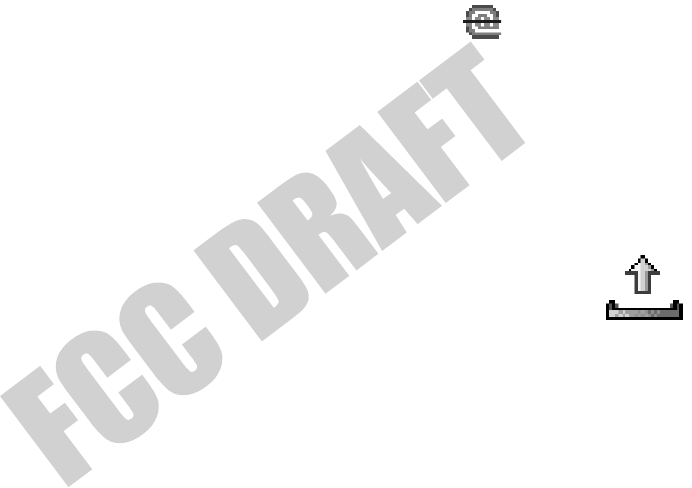
52 Copyright © 2004 Nokia
The phone mirrors the e-mail headings in the remote mailbox. If you delete the
message content, the e-mail heading stays in your phone. If you want to remove
the heading, delete the e-mail message from your remote mailbox first; then make
a connection from your phone to the remote mailbox again to update the status.
To delete an e-mail from both the phone and the remote mailbox, select Options >
Delete > Phone and server.
If you are not logged in to the e-mail server, the e-mail will be deleted from your
phone. During the next connection to the remote mailbox, it will be automatically
deleted from the remote mailbox. If you are using the POP3 protocol, messages
marked to be deleted are removed only after you have closed the connection to the
remote mailbox.
UNDELETE MESSAGES WHEN OFFLINE FROM THE E-MAIL SERVER
To undelete an e-mail from both the phone and server, scroll to an e-mail that
has been marked to be deleted during the next connection ( ), and select
Options > Undelete.
Disconnect
When you are online, select Options > Disconnect to end the data call or GPRS
connection to the remote mailbox.
•OUTBOX
Outbox is a temporary storage place for messages that are waiting to
be sent. Status of the messages in Outbox are as follows:
Sending—A connection is being made and the message is being sent.
Waiting or Queued—When there are two similar types of messages in Outbox, one
of them is waiting until the first one is sent.
Resend at (time)—Sending has failed. The phone will try to send the message again
after a time-out period. Press Send if you want to restart the sending immediately.
Deferred—You can set documents to be on hold while they are in Outbox. Scroll
to a message that is being sent, and select Options > Defer sending.
Failed—The maximum number of sending attempts has been reached. If you were
trying to send a text message, open the message and check that the sending
settings are correct.
• VIEW MESSAGES ON A SIM CARD
Select Messaging > Options > SIM messages.
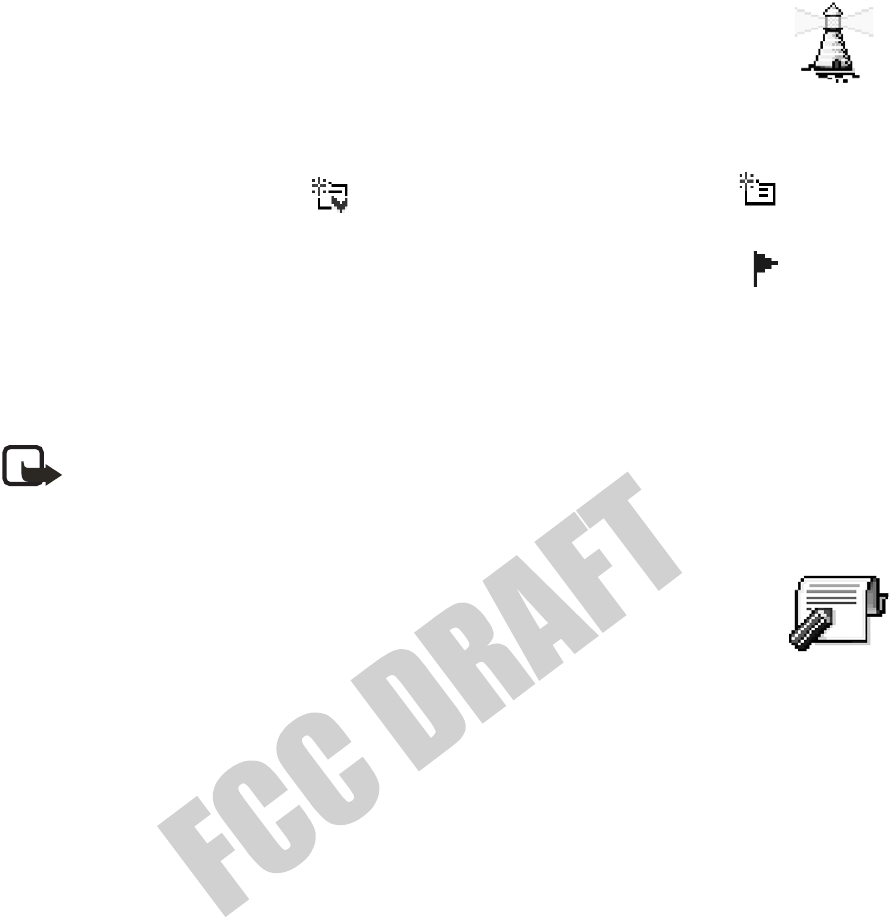
Nokia User GuideCopyright © 2004 Nokia
Messaging
• CELL BROADCAST (NETWORK SERVICE)
Select Messaging > Options > Cell broadcast.
You may be able to receive messages on various topics, such as weather
or traffic conditions, from your service provider. For available topics and relevant
topic numbers, contact your service provider. In the main view you can see:
•The status of the topic: for new, subscribed messages and for new,
unsubscribed messages.
•The topic number, topic name, and whether it has been flagged ( ) for
follow-up. You will be notified when messages belonging to a flagged topic
have arrived.
Options in Cell broadcast are Open, Subscribe or Unsubscribe, Hotmark or Remove
hotmark, Topic, Settings, Help, and Exit.
Note: A packet data (GPRS) connection may prevent cell broadcast
reception. Contact your network operator for the correct GPRS settings.
See "GPRS" on page 62.
• SERVICE COMMAND EDITOR
Select Messaging > Options > Service command. Key in and send
service requests (also known as USSD commands) for network services
to your service provider (for example, a request for activation commands).
• MESSAGING SETTINGS
Messaging settings have been divided into groups according to the different
message types. Scroll to the settings you want to edit, and press the Scroll key.
Text messages
Select Messaging > Options > Settings > Text message to open the following list
of settings:
Message centers—Lists all the message centers that have been defined.
Msg. center in use (message center in use)—Defines which message center is used
for delivering text messages and smart messages such as picture messages.
Options when editing message center settings are Edit, New msg. center, Delete,
Help, and Exit.
Receive report (delivery report)—When this network service is set to Yes, the status
of the sent message (Pending, Failed, or Delivered) is shown in the reports
(network service).

54 Copyright © 2004 Nokia
Message validity—If the recipient of a message cannot be reached within the
validity period, the message is removed from the message service center. Note that
the network must support this feature. Maximum time is the maximum amount
of time allowed by the network.
Message sent as—The options are Text, Fax, Paging, and E-mail. For further
information, contact your network operator. Change this option only if you are sure
that your message center is able to convert text messages into these other formats.
Preferred connection—You can send text messages over the normal GSM network
or by GPRS, if supported by the network.
Reply via same ctr. (network service)—By setting this option to Yes, if the recipient
replies to your message, the return message is sent using the same message service
center number. Note that this may not work between all operators.
Multimedia messages
Select Messaging > Options > Settings > Multimedia message to open the
following list of settings:
Access point in use—Select which access point is used as the preferred connection
for the multimedia message center. See "Settings needed for multimedia messaging"
on page 48.
If you receive multimedia message settings in a smart message and save them, the
received settings are automatically used for the access point. See "Smart messages"
on page 49.
Multimedia reception—Select from the following:
•Only in home net.—Receive multimedia messages only when you are in your
home network. When you are outside your home network, multimedia message
reception is turned off.
•Always on—Allow your phone to receive multimedia messages.
•Off—Do not receive multimedia messages or advertisements at all.
If Only in home net. or Always on is selected, your phone can make an active data
call or GPRS connection without your knowledge.
On receiving msg.—Select from the following:
•Retr. immediately—The phone will try to retrieve multimedia messages instantly.
If there are messages with deferred status, they will be retrieved as well.
•Defer retrieval—The multimedia messaging center will save the message to
be retrieved later. When you want to retrieve the message, set On receiving
msg. to Retr. immediately.
•Reject message—Reject multimedia messages. The multimedia message
center will delete the messages.

Nokia User GuideCopyright © 2004 Nokia
Messaging
Allow anon. messages—Select No, if you want to reject messages coming from an
anonymous sender.
Receive ads—Define whether you want to allow reception of multimedia message
advertisements or not.
Receive report—Set to Yes if you want the status of the sent message (Pending,
Failed, or Delivered) to be shown in the reports. Receiving a delivery report of a
multimedia message that has been sent to an e-mail address might not be possible.
Deny report sending—Choose Yes if you do not want your phone to send delivery
reports of received multimedia messages.
Message validity (network service)—If the recipient of a message cannot be reached
within the validity period, the message is removed from the multimedia message
center. Maximum time is the maximum amount of time allowed by the network.
Image size—Define the size of the image in a multimedia message. The options are
Small (up to 160x120 pixels) and Large (up to 640x480 pixels).
E-mail
Select Messaging > Options > Settings > E-mail. Select Mailboxes to open a list
of mailboxes that have been defined, or select Mailbox in use to choose which
mailbox you want to use.
Options when editing Mailbox settings are Editing options, New mailbox, Delete,
Help, and Exit.
If no mailboxes have been defined, you will be prompted to do so. The following list
of settings is shown (this information is available from your e-mail service provider):
Mailbox name—Write a descriptive name for the mailbox.
Access point in use (must be defined)—The Internet access point (IAP) used for the
mailbox. Choose an IAP from the list. See "Connection" on page 60.
My e-mail address (must be defined)—Write the e-mail address given to you by
your service provider. The address must contain the @ character. Replies to your
messages are sent to this address.
Outgoing mail server (must be defined)—Write the IP address or host name of the
computer that sends your e-mail.
Send message (network service)—Define how e-mail is sent from your phone:
•Immediately—A connection to the mailbox is started immediately after you
have selected Send.
•During next conn.—E-mail is sent when you connect to your remote mailbox
the next time.
Send copy to self—Select Yes to save a copy of the e-mail to your remote mailbox
and to the address defined in My e-mail address.

56 Copyright © 2004 Nokia
Include signature—Select Yes if you want to attach a signature to your e-mail
messages and to start to write or edit your signature text.
User name—Write your user name, given to you by your service provider.
Password—Write your password. If you leave this field blank, you will be prompted
for the password when you try to connect to your remote mailbox.
Incoming mail server (must be defined)—Write the IP address or host name of the
computer that receives your e-mail.
Mailbox type—Defines the e-mail protocol your remote mailbox service provider
recommends. The options are POP3 and IMAP4. This setting can be selected only
once and cannot be changed if you have saved or exited from the mailbox settings.
Security—Used with the POP3, IMAP4, and SMTP protocols to secure the connection
to the remote mailbox.
APOP secure login—Used with the POP3 protocol to encrypt the sending of
passwords to the remote e-mail server. This option is only shown if POP3 is selected
for Mailbox type.
Retrieve attachments—Retrieve e-mail with or without attachments. This option
is only shown if the Mailbox type is set to IMAP4.
Retrieve headers—Limit the number of e-mail headers you want to retrieve to your
phone. The options are All and User defined. Used with the IMAP4 protocol only.
Service messages
When you select Messaging > Options > Settings > Service message, the
following list of settings opens:
Service messages—Choose whether or not you want to allow reception of
service messages.
Download messages—Choose if you want to receive service messages only from
authorized sources.
Cell broadcast (network service)
Check with your service provider about whether Cell broadcast is available and
what the available topics and related topic numbers are. Select Messaging >
Options > Settings > Cell broadcast to change the settings:
Reception—On or Off.
Language—All allows you to receive cell broadcast messages in every possible
language. Selected allows you to choose in which languages you wish to receive
cell broadcast messages. If the language you prefer is not in the list, select Other.

Nokia User GuideCopyright © 2004 Nokia
Messaging
Topic detection—If you receive a message that does not belong to any of the
existing topics, select On to save the topic number automatically. The topic number
is saved to the topic list and shown without a name. Select Off if you do not want
to save new topic numbers automatically.
Other settings
Select Messaging > Options > Settings > Other to open the following list of settings:
Save sent messages—Choose if you want to save a copy of every text message,
multimedia message, or e-mail that you have sent to the Sent folder.
No. of saved msgs.—Define how many sent messages will be saved to the Sent
folder at a time. The default limit is 20 messages. When the limit is reached, the
oldest message is deleted.
Memory in use—Define the memory store. Choices are phone memory or memory
card, if one is used.
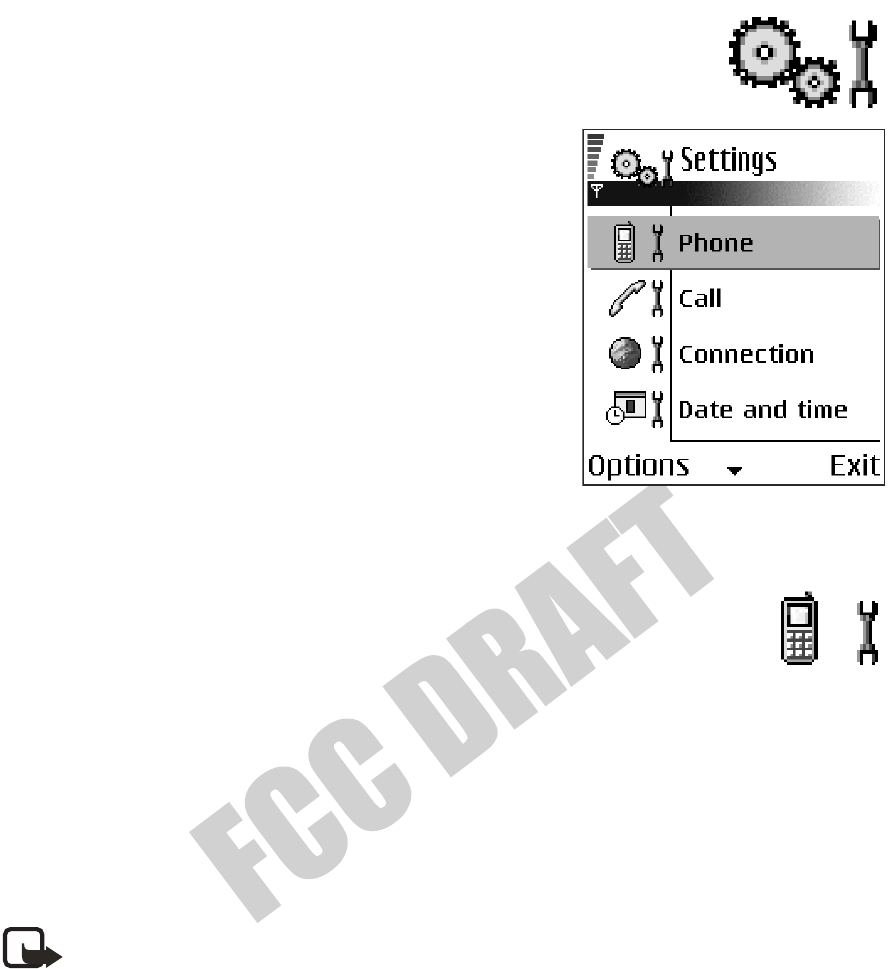
58 Copyright © 2004 Nokia
8 Settings
Select Menu > Settings.
1Scroll to a setting group, and press the
Scroll key to open it.
2Scroll to a setting you want to change and press
the Scroll key to:
•Switch between options if there are
only two (On/Off).
•Open a list of options or an editor.
•Open a slider view (scroll right to increase
or left to decrease the value).
You may be able to receive some settings from your
service provider in a smart message, or some settings
may be preprogrammed into the phone. See "Smart messages" on page 49.
•PHONE
Select Menu > Settings > Phone > General, Standby mode,
or Display.
General
Phone language—You can change the language for the display texts in your phone.
This change may also affect the format used for date and time and the separators
used, for example, in calculations. If you select Automatic, the phone selects the
language according to the information on your SIM card. After you have changed
the display text language, you must restart the phone.
Note: Changing the settings for Phone language or Writing language
affects every application in your phone and the change remains effective
until you change these settings again.
Writing language—You can change the writing language of your phone. Changing
the language affects the following features:
•The characters available when you press any key (1–9)
•The predictive text dictionary used
•The special characters that are available when you press the *and 1keys
Predictive text—Set predictive text input On or Off for all editors in the phone.
Select a language for entering predictive text from the list available. You can also
change this setting when you are in an editor. Press the Edit key, and select
Predictive text > On or Off.
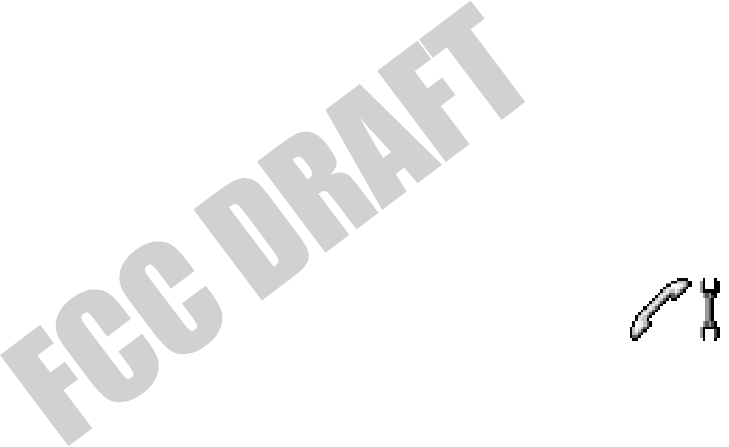
Nokia User GuideCopyright © 2004 Nokia
Settings
Welcome note or logo— The welcome note or logo is displayed briefly each time
you switch on the phone. Select Default if you want to use the default image or
animation. Select Text to write a welcome note (up to 50 letters). Select Image to
choose a photo or picture from Gallery.
Orig. phone settings—You can reset some of the settings to their original values.
To do this, you need the lock code. See "Security" on page 64. After resetting the
settings, the phone may take a longer time to power on. All documents and files
that you have created are left as they are.
Standby mode
Left selection key and Right selection key—You can change the shortcuts that
appear over the Left selection key and Right selection key in the standby mode.
In addition to the applications, you can have the shortcut point to a function, for
example, New message.
Display
Brightness—Adjust the slide bar between Dark and Bright.
Screen saver timeout—The screen saver is activated after the screen saver
time-out period. When the screen saver is active, the display is cleared and you can
see the screen saver bar.
To deactivate the screen saver, press any key.
•CALL
Select Menu > Settings > Call > Send my caller ID, Call waiting,
Automatic redial, Summary after call, 1-touch dialing, Anykey
answer, or Line in use.
Send my caller ID (network service)
This service allows you to display your phone number (Yes) or hide your number
(No) from the person you call. This option may be set by your network operator or
service provider when you subscribe.
Call waiting (network service)
The network will notify you of a new incoming call while you have a call in progress.
Select Activate to request the network to activate call waiting, Cancel to request
the network to deactivate call waiting, or Check status to check if the function is
active or not.
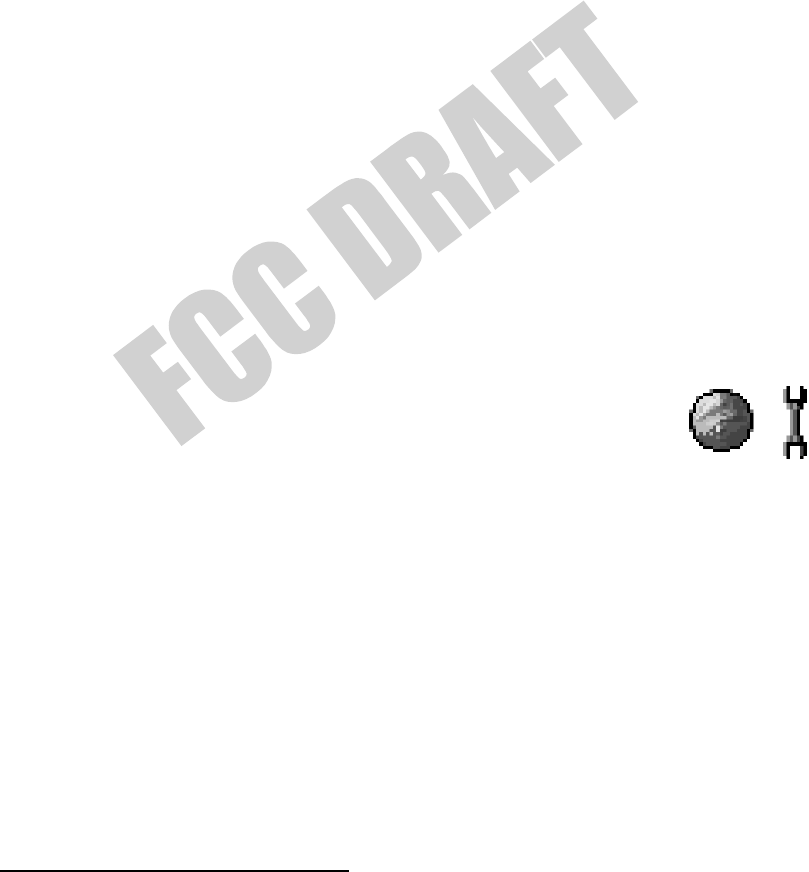
60 Copyright © 2004 Nokia
Automatic redial
When this setting is activated, your phone attempts to connect the call a maximum
of ten times after an unsuccessful call attempt. Press the End key to stop
automatic redialing.
Summary after call
Activate this setting if you want the phone to briefly display the approximate
duration of the last call.
1-touch dialing
Select On, and the numbers assigned to the 1-touch dialing keys (2–9) can be dialed
by pressing and holding the key. See "Assign 1-touch dialing keys" on page 26.
Anykey answer
Select On, and you can answer an incoming call by briefly pressing any key, except
the Right selection key, the Power key, and the End key.
Line in use (network service)
This setting is shown only if the SIM card supports two subscriber numbers, that is,
two phone lines. Select the phone line (Line 1 or Line 2) you want to use for
making calls and sending short messages. Calls on both lines can be answered
regardless of the selected line.
You cannot make calls if you select Line 2 and have not subscribed to this
network service.
To prevent line selection, select Line change > Disable if your SIM card supports
this function. To change this setting, you need the PIN2 code.
•CONNECTION
Select Menu > Settings > Connection > Access points, GPRS,
Data call, or Configurations.
Access points
An access point is where your phone connects to the mobile Internet by way of a data
call or packet data connection. An access point can be provided, for example, by a
commercial Internet service provider (ISP), service provider, or network operator.
Many service providers require an Internet access point (IAP) for your default
access point. Other service providers allow you to use a browser access point.
Contact your service provider for more information.
To define access point settings, select Menu > Settings > Connection > Access
points. If you have not yet used your phone to make a WAP connection, you may
need to contact your service provider for assistance with the first-time connection,
or visit www.nokia.com/phonesettings.

Nokia User GuideCopyright © 2004 Nokia
Settings
Fill in these settings from the top because your Data bearer selection determines
which fields are available:
•Connection name—Give a descriptive name for the data connection.
•Data bearer—The options are GPRS and Data call. The data bearer selection
affects the other fields that are available. Fill in all fields marked with Must
be defined, or with an asterisk. Other fields can be left empty, unless you have
been instructed otherwise by your service provider.
To use a data connection, your network operator or service provider must
support this feature, and if necessary, activate it for your SIM card.
•Access point name (for packet data only)—The access point name is needed
to establish a connection to the GPRS network. You obtain the access point
name from your network operator or service provider.
•Dial-up number (for Data call only)—Enter the the modem telephone number
of the access point.
•User name—Enter a user name if the service provider requires it. The user
name may be needed to make a data connection and is usually provided by the
service provider. The user name is often case-sensitive.
•Prompt password—If you must key in a new password every time you log on to
a server or if you do not want to save your password to the phone, choose Yes.
•Password—A password may be needed to make a data connection and is
usually provided by the service provider. The password is often case-sensitive.
When you are writing the password, the characters you enter are shown briefly
and then changed to asterisks (*). The easiest way to enter numbers is to press
and hold the number you want to enter, and then continue entering letters.
•Authentication—Normal or Secure.
•Homepage—This setting depends on what you are setting up. Write either the
service address or the address of the multimedia messaging center.
•Data call type (for data call only)—Analog, ISDN v.110, or ISDN v.120 defines
whether the phone uses an analog or digital connection. This setting depends
on both your GSM network operator and your Internet service provider (ISP)
because some GSM networks do not support certain types of ISDN connections.
For details, contact your ISP. If ISDN connections are available, they connect
more quickly than analog methods.
•Maximum data speed (for data call only)—The options are Automatic, 9600,
or 14400, depending on what you have chosen in Data call type. This option
allows you to limit the maximum connection speed when GSM data is used.
Higher data rates may cost more, depending on the service provider.
These speeds represent the maximum speed at which your connection will
operate. During the connection, the operating speed may be less, depending
on network conditions.

62 Copyright © 2004 Nokia
ADVANCED ACCESS POINT SETTINGS
If you need to enter advanced settings, contact your Internet service provider. To
access advanced access point settings, select Menu > Settings > Connection >
Access points, select the access point you want to modify, and select Options >
Advanced settings. You can then define the following settings:
•Phone IP address—The IP address of your phone
•Primary name server—The IP address of the primary DNS server
•Second. name server—The IP address of the secondary DNS server
•Proxy serv. address—The IP address of the proxy server
•Proxy port number—The port number of the proxy server
These additional settings are shown if you selected Data call as the Data bearer type:
•Use callback—This option allows a server to call you back once you make the
initial call. Contact your service provider to subscribe to this service.
The phone expects that the callback will use the same data call settings. The
network must support that type of call in both directions.
•Callback type—The options are Use server no. or Use other no. Ask your
service provider which setting their configuration uses.
•Callback number—Key in the phone data phone number that the dial back
server uses. Usually, this number is the data call phone number of your phone.
•Use PPP compression—When set to Yes, this option speeds up the data transfer,
if the remote PPP server supports the compression. If you have problems with
establishing a connection, try setting this to No. Contact your service provider
for guidance.
•Use login script—The options are Yes or No.
•Login script—Insert the login script.
•Modem initialization (modem initialization string)—This option controls your
phone using modem AT commands. If modem initialization is required, enter
characters specified by your service provider or Internet service provider.
GPRS
GPRS (general packet radio service) is a network service that allows mobile phones
to send and receive data over an IP-based network. GPRS is a data bearer that
enables wireless access to data networks, such as the mobile Internet.
The applications that may use GPRS are multimedia, IM and text messaging, presence,
streaming, browsing sessions, e-mail, data sync, Java™ application downloading,
and the PC dial-up (such as Internet and e-mail).
To use GPRS technology, you must first do the following:
• Contact your service provider for availability and subscription.
• Save the GPRS settings for each of the applications used.

Nokia User GuideCopyright © 2004 Nokia
Settings
For information on pricing, contact your service provider.
To define GPRS connection settings, select Menu > Settings > Connection >
GPRS, and specify these settings:
GPRS connection—If you select When available and your network supports packet
data, the phone registers to the GPRS network. Also, starting an active packet data
connection, for example, to send and receive e-mail, is quicker. If you select When
needed, the phone will use a packet data connection only if you start an application
or action that needs it. The GPRS connection can be closed after the applications
no longer use it.
If there is no GPRS coverage and you have chosen When available, the phone
periodically tries to establish a packet data connection.
Access point—The access point name is needed when you use your phone as a
packet data modem to your computer.
Data call
Online time—This setting affects all access points using a GSM data call. If there
are no actions, the data call is dropped automatically after a time-out period.
Select User defined (in which case you enter a time) or Unlimited.
Configurations
When you open a message that contains configuration settings for your phone, the
message is displayed in this viewer. If you do not have any configuration settings
messages, this screen will be empty. To delete a message from this screen, press the
Clear key.
Options in the configurations viewer are Save, Message details, and Move to folder.
• DATE AND TIME
Select Menu > Settings > Date and time.
The Date and time settings allow you to define the date and time
used in your phone, as well as change the date and time format and separators.
You can also change the following settings:
Clock type—Select Analog or Digital to change how the clock is displayed in the
standby mode. See "Clock" on page 79.
Clock alarm tone—Changes the tone played when the clock reaches an alarm time.
Auto time update—Allows the network to update time, date, and time zone
information to your phone (network service). For the auto time update setting to
take effect, the phone needs to be restarted. Check any alarms because they may
be affected by the auto time update.
GMT offset—Changes the time zone for the clock time.
Daylight-saving—Sets daylight saving time on or off.

64 Copyright © 2004 Nokia
•SECURITY
Select Menu > Settings > Security > Phone and SIM or
Certif. management.
Phone and SIM
If your phone requests a security code, refer to the following explanations to
determine what you should enter. If you forget or lose a PIN or PUK code or if you
have not received such a code, contact your service provider.
You can change the following codes: lock code, PIN code, and PIN2 code. These
codes can only include the numbers from 0 to 9.
The PUK (personal unblocking key) code is required to change a blocked PIN code.
The PUK2 code is required to change a blocked PIN2 code. If the codes are not
supplied with the SIM card, contact your service provider for the codes. The PUK
and PUK2 codes are 8 digits long.
Avoid using security codes similar to emergency numbers, such as 911, to prevent
accidental dialing of the emergency number.
•PIN code request—When the PIN code request is active, the code is requested
each time the phone is switched on. Note that deactivating the PIN code
request may not be allowed by some SIM cards.
•PIN code (4 to 8 digits)—The PIN code protects your SIM card against
unauthorized use. The PIN code is usually supplied with the SIM card.
•After three consecutive incorrect PIN code entries, the PIN code is blocked. If
the PIN code is blocked, you need to unblock the PIN code before you can use
the SIM card again. See also the information below about the PUK code.
•PIN2 code (4 to 8 digits)—The PIN2 code is supplied with some SIM cards and
is required to access some functions, such as fixed dialing numbers (FDN).
•Autolock period—You can set an autolock period, a time-out after which the
phone is automatically locked and can be used only if the correct lock code is
entered. Key in a number for the time-out in minutes, or select None to turn
off the autolock period.
To unlock the phone, key in the lock code.
When the phone is locked, calls may still be possible to the official emergency
number programmed into your phone.
•Lock code (5 digits)—The lock code can be used to lock the phone and keypad
to avoid unauthorized use. The factory setting for the lock code is 12345. To
prevent unauthorized use of your phone, change the lock code. Keep the new
code secret and in a safe place separate from your phone. If you forget or lose
the lock code, contact your service provider.
•Lock if SIM changed—Select Yes if you want the phone to prompt for the lock
code when an unknown, new SIM card is inserted into your phone. The phone
maintains a list of SIM cards that are recognized as the owner’s cards.

Nokia User GuideCopyright © 2004 Nokia
Settings
•Fixed dialing—You can restrict your outgoing calls to selected phone numbers,
if supported by your SIM card. You need the PIN2 code for this function. When
this function is active, you can only call those phone numbers that are included
in the fixed dialing list or which begin with the same digits as a phone number
on the list.
Press the Scroll key to set fixed dialing on. When fixed dialing is activated,
calls still may be possible to the official emergency number programmed into
your phone. To add new numbers to the fixed dialing list, select Options >
New contact or Add from Contacts.
Options in fixed dialing are Open, Call, Activ. fixed dialing or Deact. fixed
dialing, New contact, Edit, Delete, Add to Contacts, Add from Contacts, Find,
Mark/Unmark, Help, and Exit.
•Closed user group (network service)—You can specify a group of people whom
you can call and who can call you. For more information, contact your network
operator or service provider. Select one of the following:
Default—Activate the default group agreed on with the network operator.
On—Use another group (you need to know the group index number).
Off—Do not use closed user groups.
When calls are limited to closed user groups, calls still may be possible to the
official emergency number programmed into your phone.
•Confirm SIM services (network service)—Sets the phone to display
confirmation messages when you are using a SIM card service.
•Restore server—Reset your connection settings allowing you to receive new
settings from your service provider.
Certif. management
Options in Certif. management are Certificate details, Delete, Trust settings, Mark/
Unmark, Help, and Exit.
In the certificate management main view, you can see a list of authority certificates
that have been stored in your phone. Scroll right to see a list of personal certificates,
if available.
Authority certificates are used by some browser services, such as banking services,
for checking signatures or server certificates or other authority certificates.
Server certificates are used to improve security in the connection between the
phone and the gateway. The phone receives the server certificate from the service
provider before the connection is established, and its validity is checked using the
authority certificates saved in the phone. Server certificates are not saved.
Server certificates may be needed, for example, when you want to do the following:
•Connect to an online bank or another site or remote server for actions that
involve transferring confidential information.
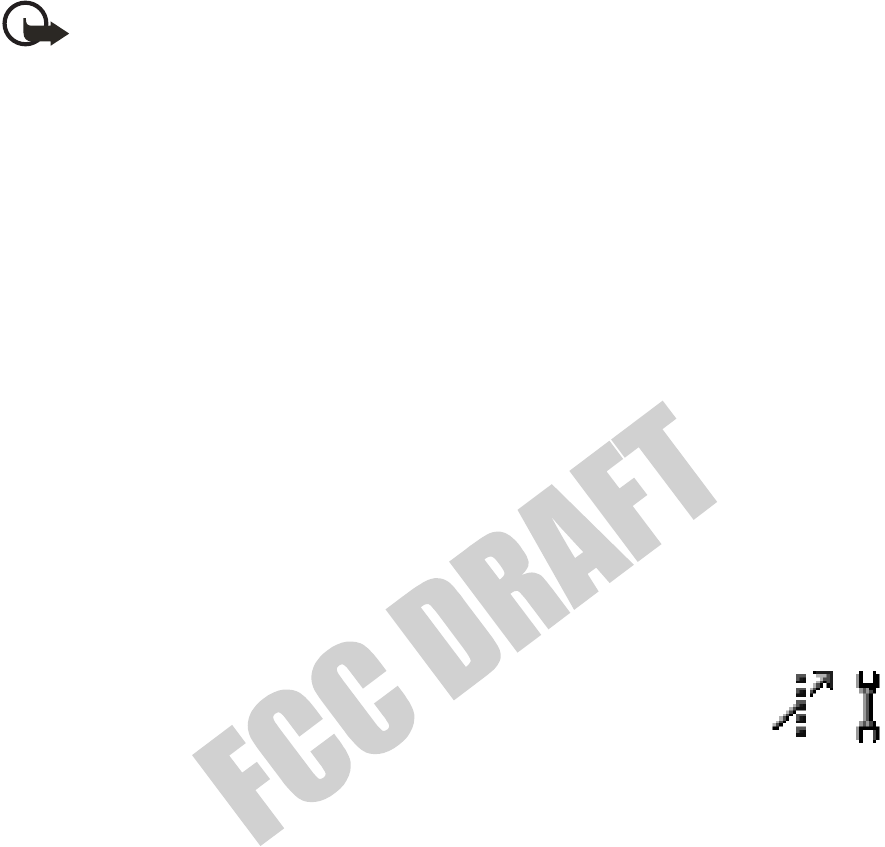
66 Copyright © 2004 Nokia
•Decrease the risk of viruses or other malicious software and be sure of the
authenticity of software when downloading and installing software.
Important: Note that even if the use of certificates makes the risks
involved in remote connections and software installation considerably
smaller, they must be used correctly in order to benefit from increased
security. The existence of a certificate does not offer any protection by
itself; the certificate manager must contain correct, authentic, or trusted
certificates for increased security to be available. Certificates have a
restricted lifetime. If Expired certificate or Certificate not valid yet is
shown even if the certificate should be valid, check that the current date
and time in your device are correct.
Before changing any certificate settings, you must make sure that you really
trust the owner of the certificate and that the certificate really belongs to the
listed owner.
CHANGE THE TRUST SETTINGS OF AN AUTHORITY CERTIFICATE
Scroll to an authority certificate, and select Options > Trust settings. Depending
on the certificate, a list of the applications that can use the selected certificate is
shown. For example:
•Internet—The certificate can certify e-mail and imaging servers.
•App. installation—The certificate can certify the origin of new software.
• CALL RESTRICTION (NETWORK SERVICE)
Select Menu > Settings > Call restriction.
Call restriction allows you to restrict outgoing and incoming calls
with your phone. For this function, you need the restriction
password, which you can obtain from your service provider.
Select Options, and choose one of the following:
Activate—Request the network to set call restriction on.
Cancel—Set the selected call restriction off.
Check status—Check whether the calls are blocked.
Edit restr. passw.—Change the restriction password.
Cancel all restrict.—Cancel all active call restrictions.
You cannot restrict incoming calls while call forwarding or fixed dialing is active. See
"Call forwarding (network service)" on page 21. See also “Security” on page 64. When
calls are restricted, calls still may be possible to certain official emergency numbers.
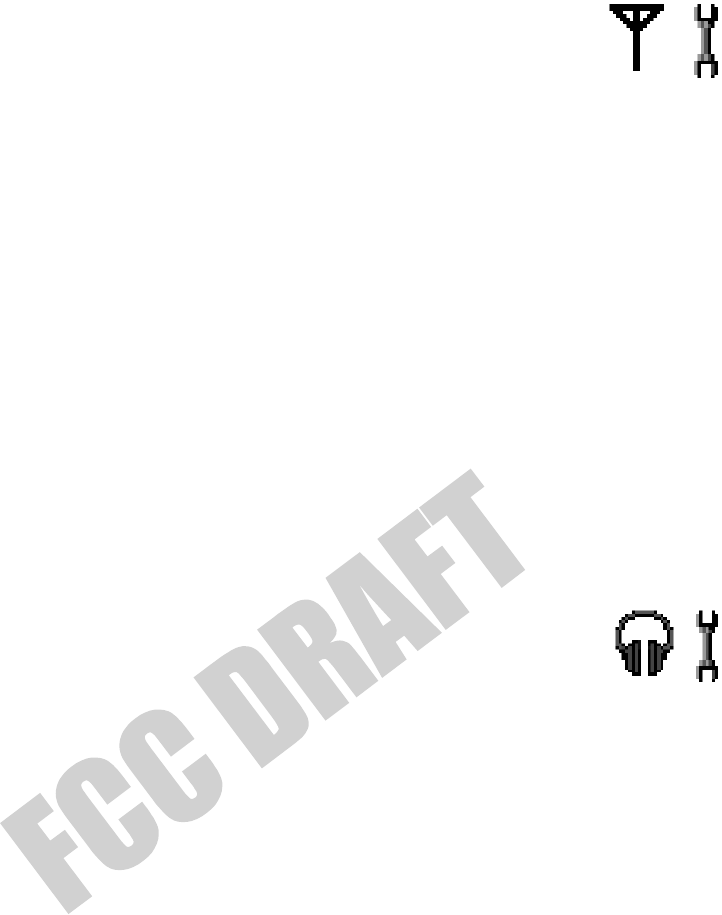
Nokia User GuideCopyright © 2004 Nokia
Settings
•NETWORK
Select Menu > Settings > Network > Operator selection or Cell
info display.
Operator selection
Automatic—Set the phone to automatically search for and select one of the
cellular networks available in your area.
Manual—Select the desired network manually from a list of networks. If the
connection to the manually selected network is lost, the phone will sound an error
tone and ask you to select a network again. The selected network must have a
roaming agreement with your home network, that is, the operator whose SIM card
is in your phone.
Cell info display
On or Off—Set the phone to indicate when it is used in a cellular network based
on microcellular network (MCN) technology and to activate cell info reception
(network service).
• ENHANCEMENT
Select Menu > Settings > Enhancement and one of these options:
Enhancement in use—If you are using an enhancement such as a
loopset, headset, or TTY adapter, you must activate it by selecting Headset,
Loopset, or TTY. If you have activated a loopset, the headset will use the same
settings as the loopset.
Headset, Loopset, TTY, and Handsfree—For each of these items, define the
following settings:
•Default profile—Select the profile to be activated each time you connect a
certain enhancement to your phone. See "Change the profile" on page 73.
•Automatic answer—Set the phone to answer an incoming call automatically
after 5 seconds time when you connect a certain enhancement to your phone.
If the incoming call alert is set to Beep once or Silent, you must answer the
phone manually. This option is not available for TTY.
See also “Enhancement indicators” on page 13.
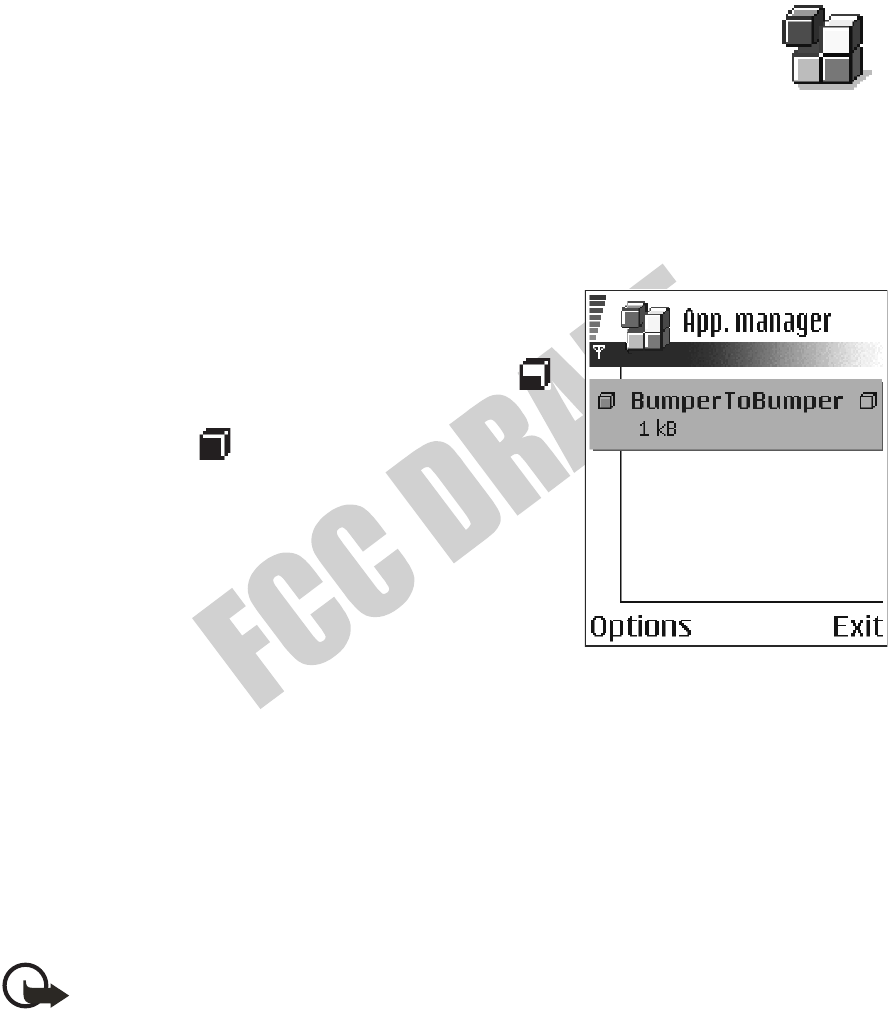
68 Copyright © 2004 Nokia
9 Tools and applications
Select Menu > Tools to access common tools and applications. For instructions on
voice mail and 1-touch dialing, see “Call voice mail” on page 18 and “1-touch
dialing” on page 19.
• APPLICATION MANAGER
Select Menu > Tools > Manager.
In App. manager you can install new compatible Symbian operating
system applications (SIS files) and Java applications (Java MIDlets
and MIDlet suites). You can also update and uninstall applications from the phone
and monitor the installation history.
Options in App. manager are Install, View details, View certificate, Update, Go to
web address, Remove, View log, Send log, Settings, App. downloads, Help, and Exit.
When you open App. manager, you can see a list of:
•Applications saved in App. manager
•Partially installed applications (indicated by )
•Fully installed applications that you can remove
(indicated by )
You can only use Symbian operating system
applications with a .SIS extension.
Your phone supports J2ME™Java applications. Do
not download PersonalJava™ applications to your
phone; they cannot be installed.
Install applications
You can install applications that are specifically intended for this phone and
suitable for the Symbian operating system.
If you install an application that is not intended specifically for this phone, it may
function and look different from what was originally intended.
Applications may be downloaded to your phone during browsing, received as
attachments in multimedia messages or e-mails, or received by Bluetooth
connection from another device, for example, a phone or a compatible PC.
Important: Only install applications from sources that offer adequate
protection against harmful software.
To increase protection, the application installation system uses digital signatures
and certificates for applications. Do not install the application if App. manager
gives a security warning during installation.

Nokia User GuideCopyright © 2004 Nokia
Tools and applications
If you install an update or repair to an existing application, the original application
is removed and the update or repair takes its place. You must have the original
application or a full backup copy of it in order to restore it after it has been
removed. To restore the original application, first remove the updated or repaired
application, and then install again from the original application or the backup copy.
During installation, the phone checks the integrity of the application to be
installed. The phone shows information about the checks being carried out, and you
are given options on whether to continue or cancel the installation. Once the
phone has checked the integrity of the application, it is installed on your phone.
INSTALL APPLICATIONS
Open App. manager, scroll to the application, and select Options > Install to start
the installation.
You can also search the phone memory or the memory card, select the application,
and press the Scroll key to start the installation.
Some applications may give the option of partial installation, allowing you to
select the particular components of an application that you want to install. If you
are installing an application without a digital signature or a certificate, the phone
warns you of the risks. Continue installation only if you are absolutely sure of the
origin and contents of the application.
INSTALL JAVA™ APPLICATIONS
The .JAR file is required for installation. If it is missing, the phone may ask you to
download it. If there is no access point defined for App. manager, you will be asked
to select one. When you are downloading the .JAR file, you may need to enter a
user name and password to access the server. You obtain these from the supplier
or manufacturer of the application.
•To start a data connection and to view extra information about the
application, scroll to it and select Options > Go to web address.
•To start a data connection and check if there is an update available for the
application, scroll to it and select Options > Update.
JAVA SETTINGS
To change the default access point that a Java application uses for downloading extra
data, select Options > Settings > Access point. See "Access points" on page 60.
To change the security settings that determine the actions that a Java application
is permitted to do, select Options > Settings. Not all Java applications permit you
to change the security settings.
Remove an application
1Scroll to the application and select Options > Remove.
2Press Yes to confirm the removal.
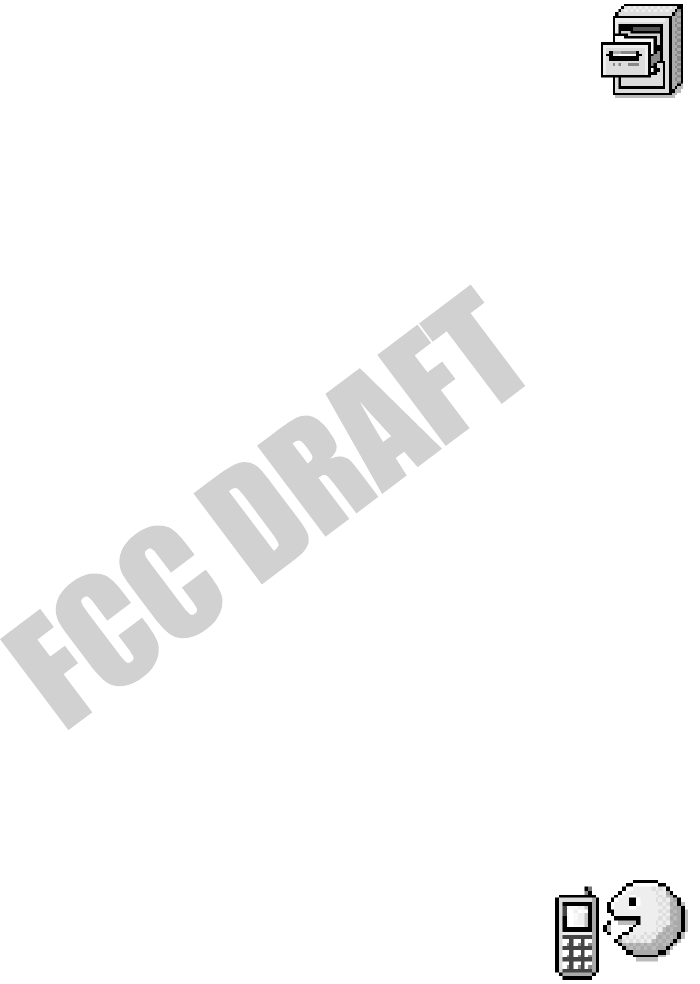
70 Copyright © 2004 Nokia
If you remove an application, you can only reinstall it if you have the original
application or a full backup of the removed application. If you remove an application,
you may no longer be able to open documents created with that application. If another
application depends on the application that you removed, the other application may
stop working. Refer to the documentation of the installed application for details.
•FILE MANAGER
Select Menu > Tools > File mngr.
Options in File manager are Open, Send, Delete, Move to folder, Copy
to folder, New folder, Mark/Unmark, Rename, Find, View details,
Memory details, Help, and Exit.
In File manager, you can browse, open, and manage files and folders in the phone
memory or on the memory card, if you use one.
Open File manager to see a list of the folders in the phone memory. Scroll right to
see the folders on the memory card, if you use one.
You can browse, open, and create folders, mark, copy and move items to folders.
See "Common actions for all applications" on page 15.
Not all folders are visible in File manager (for example, system folders are not visible).
View memory consumption
If you have a memory card installed on your phone, you will have a choice of two
memory views, one for the phone memory and one for the memory card.
Scroll right or left to move from one memory tab to another.
To check memory consumption of the current memory, select Options >
Memory details.
The phone calculates the approximate amount of free memory for storing data and
installing new applications.
In the memory views, you can view the memory consumption of the different data
groups: Calendar, Contacts, Documents, Messages, Images, Sound files, Video
clips, Applications, Mem. in use, and Free memory.
• VOICE COMMANDS
Select Menu > Tools > Voice com..
Options in Voice commands are Add voice command, Open, New
application, Playback, Change, Delete, Delete all, Help, and Exit.
You can use voice commands to start applications and profiles, and to dial numbers
from Contacts, without having to look at the phone display. You record a word, or
words, (voice command) and then say this voice command to open an application,
activate a profile, or dial a number.

Nokia User GuideCopyright © 2004 Nokia
Tools and applications
You can have only one voice command per item. Any spoken words can be a
voice command.
When recording, hold the phone at a short distance away from your mouth. After the
starting tone, say clearly the word, or words, you want to record as a voice command.
Voice commands have the same requirements as voice tags. Before recording a
voice command, see “Requirements for voice tags” on page 25.
Note: You must say the voice command exactly as you said it when you
recorded it. This may be difficult in, for example, a noisy environment or
during an emergency, so you should not rely solely upon voice commands
in all circumstances.
Add a voice command to an application
1In Voice commands, scroll to the application to which you are adding a voice
command, and select Options > Add voice command. To add a voice command
to a profile, you must have the Profiles folder open and a specific profile selected.
Press ’Start’, then speak after tone is displayed.
2Press Start to record a voice command.
The phone sounds a starting tone, and the note Speak now is displayed.
3Say the voice command.
The phone will stop recording after approximately 5 seconds. After recording,
the phone plays the recorded command. Voice command saved is displayed,
and a beep sounds. A symbol can be seen next to the application.
If you do not want to save the recording, press Quit before the recording stops.
Add an application to the list
You can assign voice commands to other applications that are not listed in the
Voice commands main view.
1In the Voice commands main view, select Options > New application.
Available applications are displayed.
2Scroll to the application that you want to add, and press Select.
3Add a voice command to the new application. See "Add a voice command to
an application" on page 71.
Use a voice command to start an application
1In the standby mode, press and hold the Right selection key.
A short tone is played, and Speak now is displayed.
2When you start an application by saying a voice command, hold the phone a
short distance from your mouth, and say the voice command clearly.
The phone plays the original voice command and starts the application.
3If the phone plays the wrong voice command, press Retry.
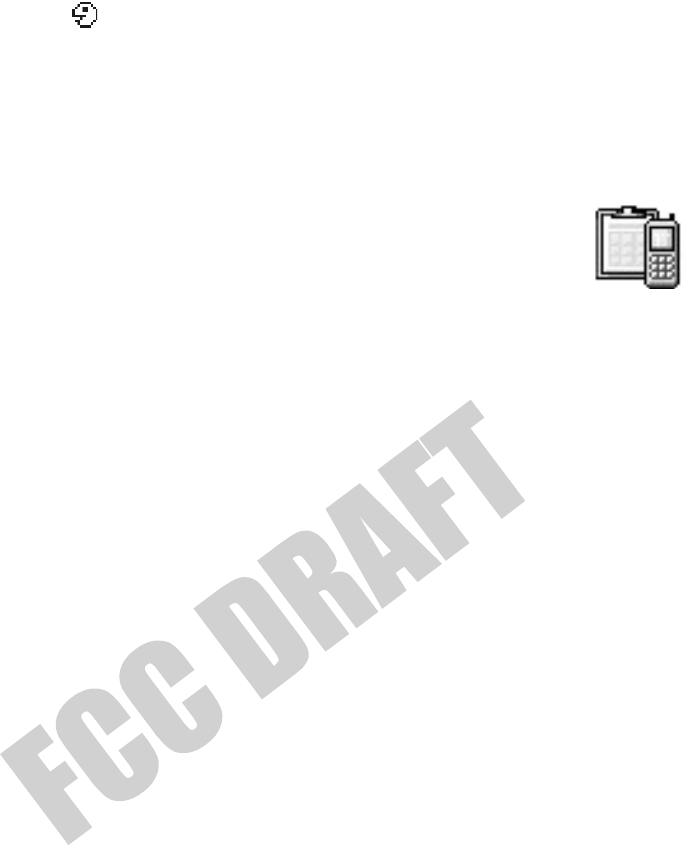
72 Copyright © 2004 Nokia
Replay, erase, or change a voice command
To replay, erase, or change a voice command, scroll to the item that has a voice
command (indicated by ), and select Options and one of the following:
Playback—Listen to the voice command again.
Delete—Erase the voice command.
Change—Record a new voice command. Press Start to record.
•DEVICE MANAGER
This feature is operator dependent and may not be available on all
phones. Contact your service provider for information and availability.
Select Menu > Tools > Dev. mgr.
Options in Device manager are Connect, New profile, Edit profile, Delete profile,
Enable or Disable configurations, View log, Help, and Exit.
When you need help with difficult phone configurations, Device manager allows a
third party, such as your service provider, to assist you directly with phone settings. To
allow device management, your phone must establish a connection and synchronize
with the third party’s server. You can start the synchronization session from your
phone, and you can accept or reject server-initiated synchronization attempts.
A device manager profile must be defined before you can connect to a server. The
third party who is assisting you can help define the profile settings:
Server name—Display name of the server.
Server ID—Remote device manager server ID.
Server password—Password used in server alerts. Enter the password that must be
provided by the device manager server when synchronizing with your phone.
Access point—Internet access point your phone uses to establish the server
connection. Choose from the list of access points defined in your phone. See
"Access points" on page 60.
Host address—Device management server URL.
Port—Device management server port.
User name—Your user name for this profile.
Password—Your password for this profile.
Allow configuration—Device management allowed on this server. Select Yes or No.
Auto-accept all reqs.—Automatic or approved device management on this server.
Select Yes to allow synchronization without your verification, or select No to verify
each synchronization attempt.

Nokia User GuideCopyright © 2004 Nokia
Personalization
10 Personalization
•PROFILES
Select Menu > Profiles.
Use Profiles to adjust and customize sound tones for different events,
environments, or caller groups.
The currently selected profile is defined at the top of the display in the standby
mode. If the Normal profile is in use, only the current date is shown.
Options in Profiles are Activate, Customize, Create new, Delete profile, Help, and Exit.
Change the profile
1Select Menu > Profiles.
A list of profiles opens.
2Scroll to a profile, and select Options > Activate.
Shortcut: To change the profile in the standby mode, press the Power key briefly,
scroll to the profile you want to activate, and press OK.
Create and customize profiles
To create a new profile, select Options > Create new. To modify a profile, select
Options > Customize.
Scroll to the setting you want to change, and press the Scroll key to open the choices:
Ringing tone—Set the ringing tone for voice calls. Choose a ringing tone from the
list. Press any key to stop the sound. If a memory card is used, tones stored on it
have the icon next to the tone name. Ringing tones use shared memory. See
"Shared memory" on page 3. You can also change ringing tones in Contacts. See
"Add a ringing tone for a contact card or group" on page 25.
Ringing type—When Ascending is selected, the ringing tone volume starts from
level one and increases level by level to the set volume level.
Ringing volume—Set the volume level for the ringing and message alert tones.
Message alert tone—Set the tone for messages.
IM alert tone—Set the tone for instant messages.
Vibrating alert—Set the phone to vibrate at incoming voice calls and messages.
Keypad tones—Set the volume level for keypad tones.
Warning tones—Instruct the phone to sound a warning tone, for example, when
the battery is running low on power.
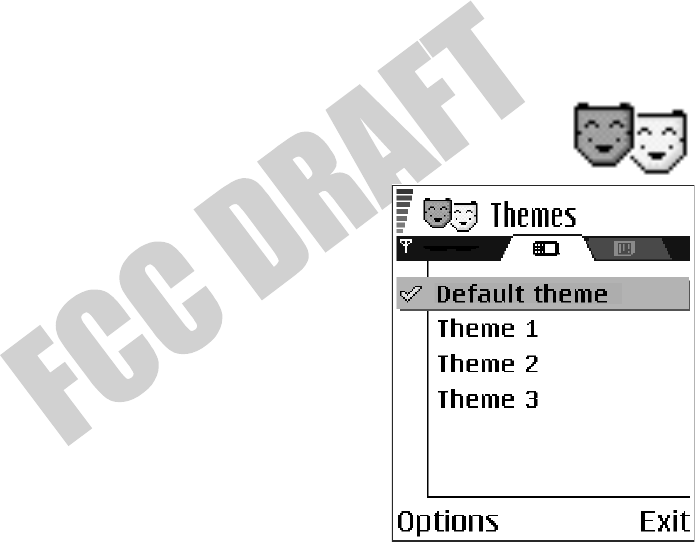
74 Copyright © 2004 Nokia
Alert for—Set the phone to ring only with calls from phone numbers that belong
to a selected contact group. Phone calls coming from people outside the selected
group will have a silent alert. You can select All calls, or you can select items from
a list of contact groups, if you have created them. See "Create contact groups" on
page 27.
Availability—Choose Available, Busy, or Not available to be displayed as your
presence information for the selected profile. This option is displayed only if you
activate the proper Sync. with Profiles setting in the Presence application. See
"Presence settings" on page 30.
User availab. alerts—Enter a customized message (up to 40 characters) to display
your current presence status for the selected profile. This option is displayed only
if you activate the proper Sync. with Profiles setting in the Presence application.
See "Presence settings" on page 30.
Profile name—If you are creating a new profile, use this setting to give it a name.
You can rename a profile and give it any name you want. The Normal profile cannot
be renamed.
•THEMES
Select Menu > Themes.
You can change the look of your phone display by
activating a theme. A theme can include the idle
screen wallpaper, color palette, screen saver, and
background image in Go to. Edit a theme for more
detailed personalization.
When you open Themes you will see a list of the
available themes. The currently active theme is
indicated by a check mark. Scroll right to see the
themes on the memory card, if you use one.
To preview a theme, scroll to the theme, and select
Options > Preview. Press Select to activate the
theme. You can activate the theme without
previewing it by selecting Options > Apply from the main view.
Options in Themes are Preview, Apply, Edit, Theme downloads, Delete, Help, and
Exit.
You can copy themes that you have downloaded. To copy a theme from your
memory card to the phone memory, scroll to the theme and select Options > Copy
to phone mem.. To copy a theme from your phone memory to the memory card,
scroll to the theme and select Options > Copy to mem. card..
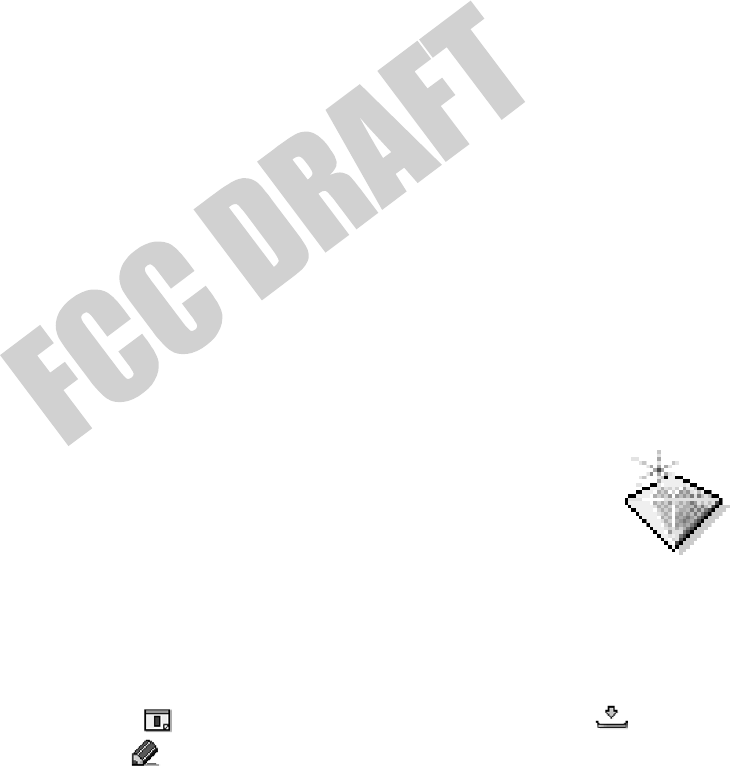
Nokia User GuideCopyright © 2004 Nokia
Personalization
Edit themes
To personalize themes further, you can group together elements from other themes
or images from Gallery:
1Scroll to a theme, and select Options > Edit to change the following options:
Wallpaper—Choose an image to use as a background image in the standby
mode. Select an image from one of the available themes or from Gallery,
where your own images are saved.
Color palette—Change the color used on the display.
Screen saver—Select what is shown on the screen saver bar. Choose to display
the time and date or write the text you want displayed. The location and
background color of the screen saver bar changes in one minute intervals.
Also, the screen saver changes to indicate the number of new messages and
missed calls. You can set the time that elapses before the screen saver is
activated. See "Standby mode" on page 59.
Image in ‘Go to’—Choose an image to use as a background image in Go to.
You can select an image from one of the available themes or from Gallery,
where your own images are saved.
2Select Back to accept the changes.
3Select Options > Set to select the current theme. You can preview the
updated theme by selecting Options > Preview. Note that you cannot preview
all elements.
Restore themes
To restore the currently selected theme to its original settings, select Options >
Restore orig. theme when editing a theme.
•GO TO
Press Go to (Right selection key) in the standby mode, or select
Menu > Extras > Go to.
In Go to, you can store shortcuts, saved browser pages, and links to
your favorite photos, video clips, notes, recorder sound files, and browser bookmarks.
Options in Go to are Open, Edit shortcut name, Move, List view or Grid view, Help,
and Exit.
Default shortcuts in Go to: —opens Calendar to the current date, —opens
the Messaging inbox, and —opens the Notes editor.
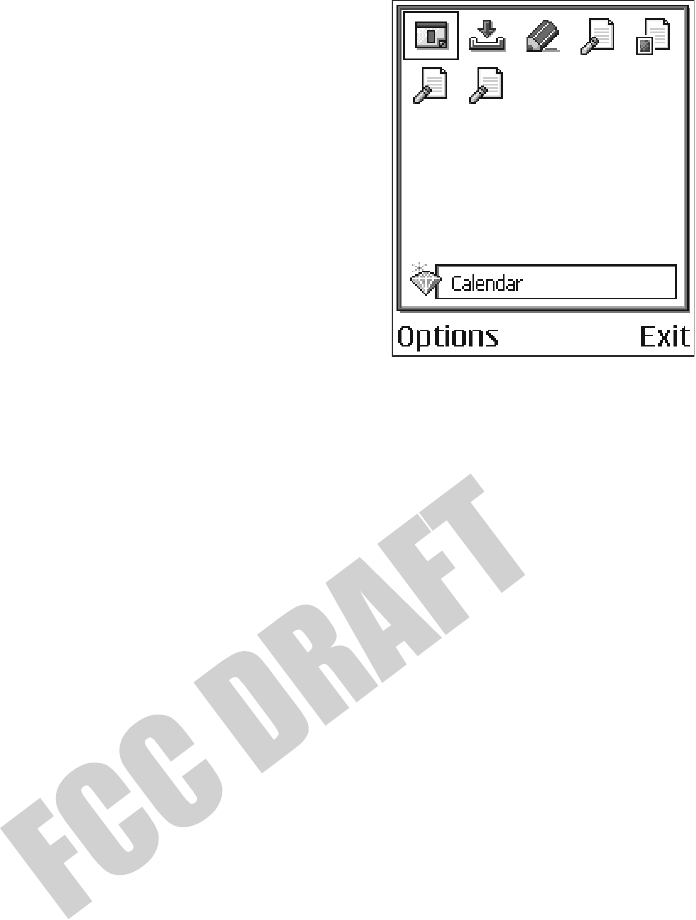
76 Copyright © 2004 Nokia
You can only add shortcuts from preinstalled
applications and functions.
1Open the application and scroll to the item that
you want to add as a shortcut.
2Select Options > Add to ’Go to’, and press OK.
A shortcut in Go to is automatically updated if you
move the item to which it points, for example, from
one folder to another.
Hints on using shortcuts:
•To open a shortcut, scroll to the icon,
and press the Scroll key. The file opens
in the corresponding application.
•To delete a shortcut, scroll to the shortcut, and select Options > Delete
shortcut. Removing a shortcut does not affect the file to which it refers.
•To change the shortcut name, select Options > Edit shortcut name. Write the
new name. This change affects only the shortcut, not the file or item to which
the shortcut refers. The default shortcuts can not be deleted.
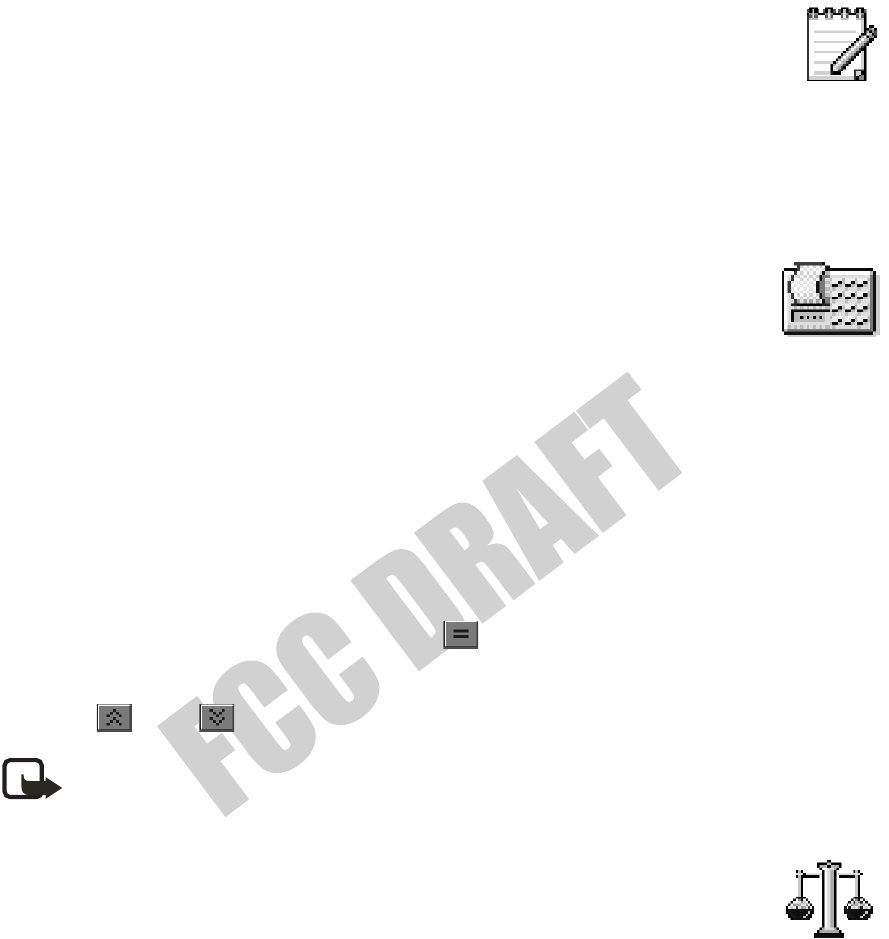
Nokia User GuideCopyright © 2004 Nokia
Extras
11 Extras
•NOTES
Select Menu > Extras > Notes.
You can link notes to Go to and send them to other devices. Plain text
files (TXT format) you receive can be saved to Notes.
Press any key from 1 to 0 to start to write. Press the Clear key to clear letters. Press
Done to save.
• CALCULATOR
Select Menu > Extras > Calculator.
Options in the calculator are Last result, Memory, Clear screen,
Help, and Exit.
1Enter the first number of your calculation.
To add a decimal, press the #key.
If you make a mistake, press the Clear key to erase it.
2Scroll to an arithmetic function, and press the Scroll key to select it.
3Enter the second number.
4To execute the calculation, scroll to and press the Scroll key.
Press and hold the Clear key to clear the result of the previous calculation.
Use and to view previous calculations and move in the sheet.
Note: This calculator has limited accuracy and is designed for simple
calculations. Rounding errors may occur, especially in long division.
•CONVERTER
Select Menu > Extras > Converter.
In Converter, you can convert measures from one unit to another; for
example, you can convert length from yards to meters. Converter has limited
accuracy and rounding errors may occur.
Convert units
Options in Converter are Conversion type, Currency rates (not applicable to other
units), Help, and Exit.
To make currency conversions, you must first set the exchange rate. See "Set a base
currency and exchange rates" on page 78.
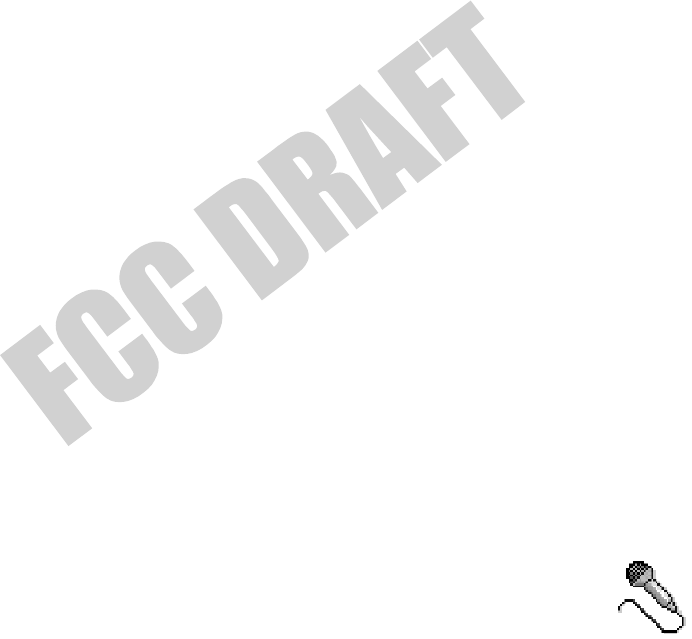
78 Copyright © 2004 Nokia
1Scroll to Type, and press the Scroll key to open a list of measures.
2Scroll to the measure you want to use, and press OK.
3Scroll to the first Unit field, and press the Scroll key to open a list of
available units.
4Select the unit from which you want to convert, and press OK.
5Scroll to the next Unit field, and select the unit to which you want to convert.
6Scroll to the first Amount field, and key in the value you want to convert.
Press the #key to add a decimal, and press the *key to insert the +, - (for
temperature), and E (exponent) symbols.
The second Amount field changes automatically to show the converted value.
The conversion order changes if you write a value in the second Amount field.
The result is shown in the first Amount field.
Set a base currency and exchange rates
Before you can make currency conversions, you must choose a base currency (usually
your domestic currency) and add exchange rates. The rate of the base currency is
always 1. The base currency determines the conversion rates of the other currencies.
1Select Currency as the measure type, and select Options > Currency rates.
A list of currencies opens with the current base currency at the top.
2To change the base currency, scroll to the currency (usually your domestic
currency), and select Options > Set as base curr..
When you change base currency, all previously set exchange rates are reset to
zero, and you must enter new rates.
3Add exchange rates, scroll to the currency, and key in a new rate, that is, how
many units of the currency equal one unit of the base currency you have selected.
4After you have inserted all the required exchange rates, make the currency
conversions. See "Convert units" on page 77.
• VOICE RECORDER
Select Menu > Extras > Recorder.
Options in Voice recorder are Record sound clip, Delete, Rename sound
clip, Send, Go to Gallery, Settings, Add to ’Go to’, Help, and Exit.
The voice recorder allows you to record telephone conversations and voice memos.
If you are recording a telephone conversation, both parties will hear a tone every
5 seconds during recording. Voice recorder cannot be used when a data call or
GPRS connection is active.
Recorded files are stored in Gallery. See "Gallery" on page 40.
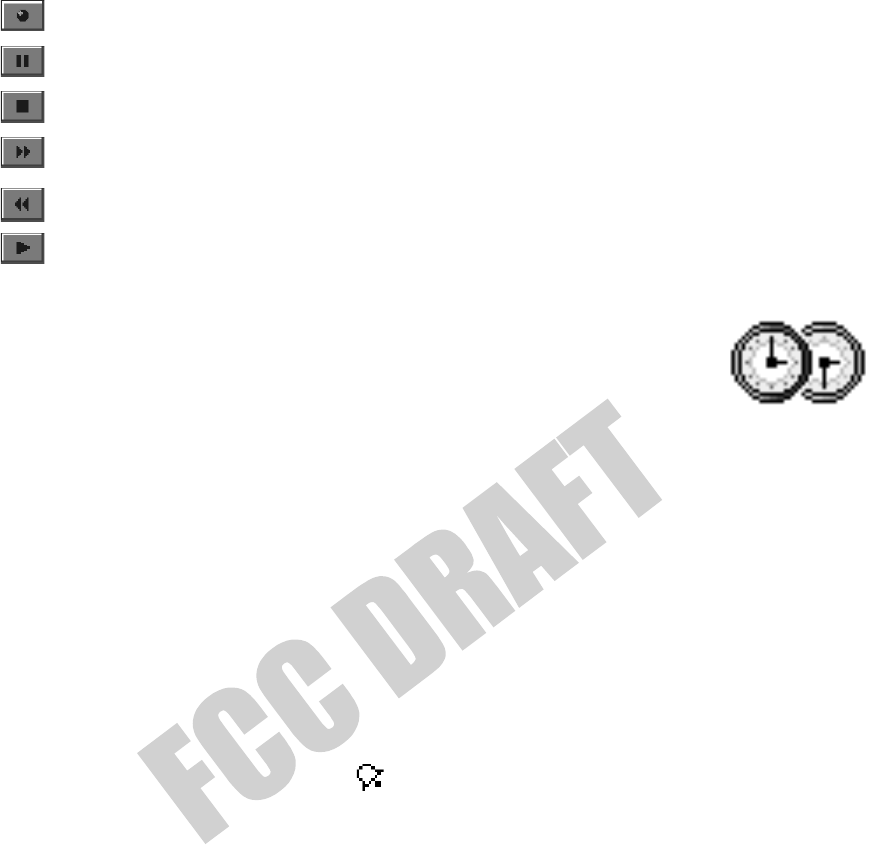
Nokia User GuideCopyright © 2004 Nokia
Extras
Select Options > Record sound clip, scroll to a function, and press the Scroll key
to select it:
•CLOCK
Select Menu > Extras > Clock.
Options in Clock are Set alarm, Reset alarm, Remove alarm,
Settings, Help, and Exit.
Change settings
To change the time or date, select Options > Settings. See also “Date and time”
on page 63.
Set an alarm
1To set a new alarm, select Options > Set alarm.
2Enter the alarm time, and press OK.
When the alarm is active, the indicator is shown.
To cancel an alarm, select Clock > Options > Remove alarm.
Stop an alarm
Press Stop to turn off the alarm.
Press Snooze to stop the alarm for 5 minutes, after which it will resume. You can
do this a maximum of 5 times.
If the alarm time is reached while the phone is switched off, the phone switches
on and starts sounding the alarm tone. If you press Stop, you receive a message
asking whether you want to activate the phone for calls. Press No to switch off the
phone or Yes to make and receive calls.
Do not press Yes when wireless phone use is prohibited or when it may cause
interference or danger.
Record
Pause
Stop
Fast forward
Fast rewind
Play an opened sound file
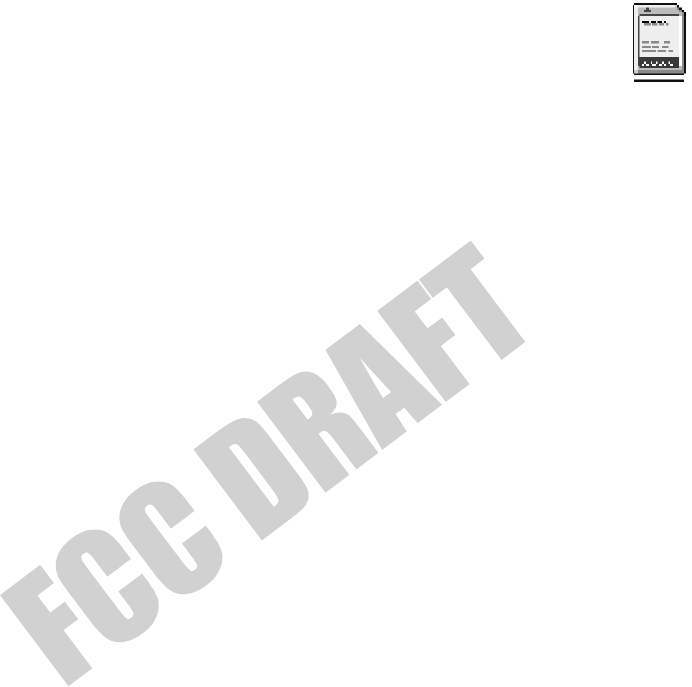
80 Copyright © 2004 Nokia
Personalize the alarm tone
1To personalize the alarm tone, select Options > Settings > Clock alarm tone.
When you scroll through the list of tones, you can stop on a tone to listen to
it before you make your selection.
2Press Select to select the current tone.
•MEMORY CARD
Select Menu > Tools > Memory.
Options in Memory card are Backup phone mem., Restore from card,
Format mem. card, Memory card name, Set password, Change password,
Remove password, Memory details, Help, and Exit.
Keep all memory cards out of the reach of small children.
For details on inserting a memory card into the phone, see “Insert the memory card”
on page 8. You can use the memory card to back up information from phone
memory and to store your multimedia files such as video clips, sound files, photos,
messaging data, etc.
Your phone may come with a Reduced Size MultiMediaCard (RS-MMC) that may
contain add-on applications from independent developers. These applications are
designed by the devlopers to be compatible with your phone. Nokia does not provide
any warranty or support for these applications. Contact the content provider for any
assistance needed.
Use only compatible MultiMediaCards (MMC) with this device. Other memory
cards, such as Secure Digital (SD) cards, do not fit in the MMC card slot and are not
compatible with this device. Using an incompatible memory card may damage the
memory card as well as the device, and data stored on the incompatible card may
be corrupted.
BY USING THE APPLICATIONS PROVIDED ON THE RS-MMC, YOU ACKNOWLEDGE THE
SOFTWARE AND/OR APPLICATIONS (COLLECTIVELY, THE "SOFTWARE") ARE PROVIDED
"AS IS" WITHOUT WARRANTY OF ANY KIND EXPRESS OR IMPLIED AND TO THE
MAXIMUM EXTENT PERMITTED BY APPLICABLE LAW NEITHER NOKIA NOR ITS
AFFILIATES MAKE ANY REPRESENTATIONS OR WARRANTIES, EXPRESS OR IMPLIED,
INCLUDING BUT NOT LIMITED TO WARRANTIES OF TITLE, MERCHANTABILITY OR
FITNESS FOR A PARTICULAR PURPOSE OR THAT THE SOFTWARE WILL NOT INFRINGE
ANY THIRD PARTY PATENTS, COPYRIGHTS, TRADEMARKS OR OTHER RIGHTS.
THERE IS NO WARRANTY BY NOKIA OR BY ITS AFFILIATES THAT ANY ASPECT OF THE
SOFTWARE WILL MEET YOUR REQUIREMENTS OR THAT THE OPERATION OF THE
SOFTWARE WILL BE UNINTERRUPTED OR ERROR-FREE. YOU ASSUME ALL
RESPONSIBILITY AND RISK FOR THE SELECTION OF THE SOFTWARE TO ACHIEVE YOUR
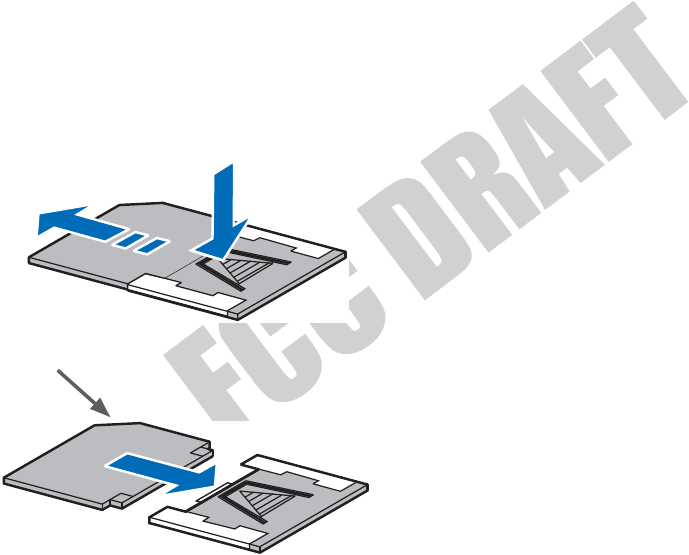
Nokia User GuideCopyright © 2004 Nokia
Extras
INTENDED RESULTS AND FOR THE INSTALLATION, USE AND RESULTS OBTAINED FROM
IT. TO THE MAXIMUM EXTENT PERMITTED BY APPLICABLE LAW, IN NO EVENT SHALL
NOKIA, ITS EMPLOYEES OR AFFILIATES BE LIABLE FOR ANY LOST PROFITS, REVENUE,
SALES, DATA, INFORMATION OR COSTS OF PROCUREMENT OF SUBSTITUTE GOODS OR
SERVICES, PROPERTY DAMAGE, PERSONAL INJURY, INTERRUPTION OF BUSINESS, OR
FOR ANY DIRECT, INDIRECT, INCIDENTAL, ECONOMIC, COVER, PUNITIVE, SPECIAL OR
CONSEQUENTIAL DAMAGES, HOWEVER CAUSED AND WHETHER ARISING UNDER
CONTRACT, TORT, NEGLIGENCE, OR OTHER THEORY OF LIABILITY ARISING OUT OF THE
INSTALLATION OR USE OF OR INABILITY TO USE THE SOFTWARE, EVEN IF NOKIA OR ITS
AFFILIATES ARE ADVISED OF THE POSSIBILITY OF SUCH DAMAGES. BECAUSE SOME
COUNTRIES/STATES/JURISDICTIONS DO NOT ALLOW THE ABOVE EXCLUSION OR
LIMITATION OF LIABILITY, BUT MAY ALLOW LIABILITY TO BE LIMITED, IN SUCH CASES,
NOKIA, ITS EMPLOYEES’ OR AFFILIATES' LIABILITY SHALL BE LIMITED TO U.S.$50.
Nothing contained in this disclaimer shall prejudice the statutory rights of any party
dealing as a consumer.
Attach and remove the memory card adapter
The RS-MMC comes with an adapter attachment that allows you to use the card
in regular sized MMC slots (for instance, in other Nokia phones or in a card reader).
Be sure to remove the adapter when you use
the RS-MMC in your Nokia 6670 phone. See
"Insert the memory card" on page 8.
To remove the adapter, press the arrow labeled
Push to release the catch (1), and gently pull
the RS-MMC away from the adapter (2).
To reattach the adapter, locate the long side of
the RS-MMC (opposite from the side with the
bevelled corner) and slide the card into the
metal slots of the adapter.
Make sure the RS-MMC is attached securely to
the adapter before you attempt to use the card
in another Nokia phone or in a card reader.
Format memory card
When a memory card is formatted, all data on the card is permanently lost.
Some memory cards are supplied pre-formatted and others require formatting.
When formatting, the memory card should always be formatted in your Nokia 6670
phone to ensure correct operation. The memory access and performance cannot be
guaranteed when formatting with another operating system.
2
1
bevelled corner

82 Copyright © 2004 Nokia
You can use File manager to check for data on a memory card before formatting
it. See "File manager" on page 70.
To format a memory card, select Options > Format mem. card, and select Yes to
confirm. When formatting is complete, key in a name for the memory card (up to
11 letters or numbers).
Back up and restore information
You can back up the phone memory and restore it to your phone. To back up
information from phone memory to the memory card, select Options > Backup
phone mem. To restore information from the memory card to phone memory,
select Options > Restore from card.
Lock the memory card
You can set a password to lock your memory card against unauthorized use. Select
Options > Set password. You will be asked to enter and confirm your password.
The password can be up to eight characters long.
The password is stored in your phone and you do not have to enter it again while
you are using the memory card on the same phone. If you want to use the memory
card on another phone, you will be asked for the password again to unlock the card.
Unlock a memory card
If you insert another password-protected memory card in your phone, you will be
prompted upon startup to enter the password of the card. Enter the password, and
press OK to unlock the card, or press Cancel to leave the card locked. To unlock the
card later, select Menu > Extras > Memory > Options > Unlock memory card.
Enter the password, and press OK.
Remove memory card password
To remove a memory card password entirely, select Options > Remove password.
Once the password is removed, the memory card is unlocked and can be used on
your phone or another phone without a password.
Check memory consumption
You can check the memory consumption of different data groups and the available
memory for installing new applications or software on your memory card. Select
Options > Memory details.
• WALLET
Select Menu > Extras > Wallet.
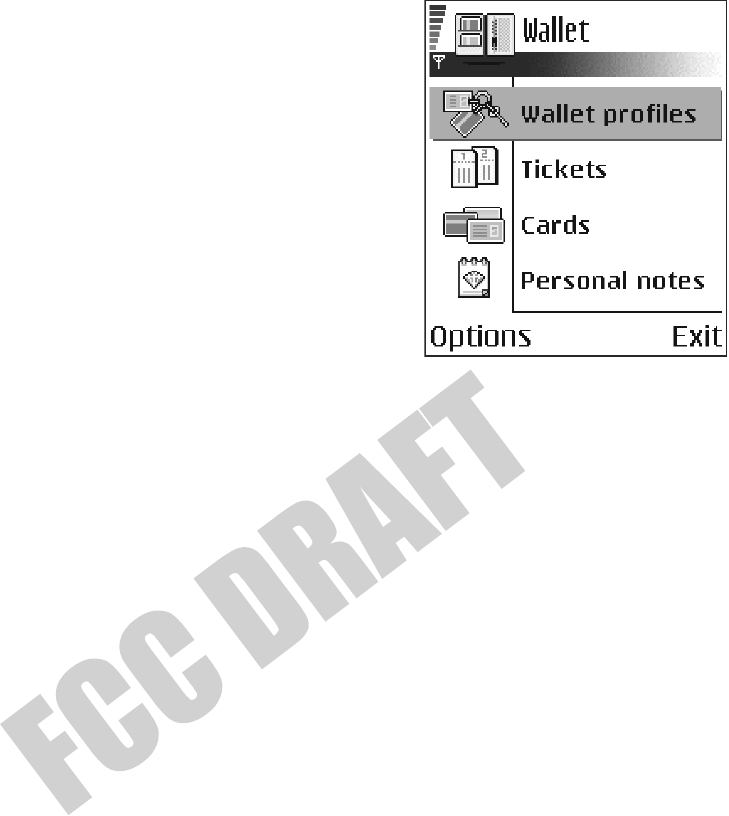
Nokia User GuideCopyright © 2004 Nokia
Extras
Wallet provides you with a storage area for your personal information, such as
credit and debit card numbers, addresses, and other useful data (for example, user
names and passwords).
The information stored in the wallet can be easily
retrieved while browsing to automatically fill in
online forms on browser pages, for example, when
the service asks for credit card details. Data in the
wallet is encrypted and protected with a wallet code
that you define.
You can group wallet data into profiles that can be
accessed, for example, for making purchases online.
Because of the nature of the wallet, it will
automatically close after 5 minutes. Enter the wallet
code to regain access to the contents. You can
change this automatic time-out period, if required.
See "Wallet settings" on page 85.
Options in Wallet are Open, Settings, Help, and Exit.
Enter the wallet code
Each time you open the wallet you will be prompted for a wallet code.
When you open the wallet for the first time, you must create your own security code:
1Enter a code of your choice (4–10 alphanumeric characters), and press OK.
You will be prompted to verify the code.
2Enter the same code, and press OK.
Do not give your wallet code to anyone else.
If you enter the wallet code incorrectly on three consecutive attempts, the
wallet application is blocked for 5 minutes. The blocked time increases if
further incorrect wallet codes are entered.
If you forget your wallet code, you will have to reset the code, and you will lose all
information stored in the wallet. See "Reset the wallet and wallet code" on page 87.
Store personal card details
Options when viewing or editing card details are Delete, Help, and Exit.
1Select Cards from the main wallet menu.
2Select a type of card:
Payment cards—Credit and debit cards
Loyalty cards—Membership and store cards

84 Copyright © 2004 Nokia
Online acc. cards—Personal user names and passwords to online services
Address cards—Basic contact details for home/office
User info cards—Customized personal preferences for online services
3Select Options > Create new.
An empty form opens.
4Fill in the fields, and press Done.
You can also receive card information directly to the phone from a card issuer or
service provider (if they offer this service). You are notified as to which category
the card belongs. Save or discard the card. You can view and rename a saved card,
but you cannot edit it.
You can open, edit, or delete the fields in the card. Any changes will be saved
upon exiting.
Create personal notes
Personal notes are a means of storing sensitive information, for example, a bank
account number. You can access the data in a personal note from the browser or
send a note as a message.
1Select Personal notes from the main wallet menu.
2Select Options > Create new.
An empty note opens.
3Press any key from 1 to 0 to start writing, and press the Clear key to clear
characters if necessary.
4Press Done to save.
Create a wallet profile
Once you have stored your personal details, you can combine them into a wallet
profile. Use a wallet profile to retrieve wallet data from different cards and
categories to the browser.
1Select Wallet profiles from the main wallet menu.
2Select Options > Create new.
A new wallet profile form opens.
3Enter a name for the profile in the Profile name field.
4Scroll to each of the following fields, and press the Scroll key to open a list
of selections:
Payment card—Select a card from the list.
Loyalty card—Select a card from the list.
Online access card—Select a card from the list.

Nokia User GuideCopyright © 2004 Nokia
Extras
Shipping address—Select an address from the list.
Billing address—By default this is Use shipping ad. If you require a billing
address that is different from the shipping address, select one from the billing
address list.
User info card—Select a card from the list.
Receive e-receipt—Select a destination from the list.
Deliver e-receipt—Select To phone, To e-mail, or To pho. & e-mail.
RFID sending—Set to On or Off. Defines whether or not your unique phone
identification is sent with the wallet profile (for future development dependent
on RFID-based ticketing).
5Press Done to save the new profile.
Retrieve information from wallet to your browser
When using online mobile services supporting the wallet functionality, you can
upload the data stored in your wallet to automatically enter your details into an
online form. For example, by uploading your payment card details, you do not need
to key in the card number and expiration date each time you need them (depending
on the content being browsed). Also, you can retrieve your user name and password
stored as an access card when connecting to a mobile service that requires
authentication. See "Purchase an item" on page 101.
View ticket details
You can receive notifications of electronic tickets purchased online with the browser.
Received ticket notifications are stored in the wallet. To view the notifications:
1Select Tickets from the main Wallet menu.
2Select Options > View.
The ticket details are displayed in a form. None of the fields in the ticket
notification form can be edited.
Options in Tickets are View, Delete, Rename, Mark/Unmark, Help, and Exit.
Wallet settings
Select Options > Settings from the main wallet menu to modify the following items:
Wallet code—Change your wallet code. You will be prompted to enter the current
code, create a new code, and verify the new code.
RFID—Set the phone ID code, type, and sending options (for future development
dependent on RFID-based ticketing).

86 Copyright © 2004 Nokia
Automatic close—Change the automatic time-out period (1–60 minutes). After
the time-out period has elapsed, the wallet code must be re-entered to gain access
to the contents.

Nokia User GuideCopyright © 2004 Nokia
Extras
Reset the wallet and wallet code
To reset both the contents of the wallet and the wallet code:
1Key in *#7370925538# in the standby mode.
2Enter the phone lock code, and press OK. See "Security" on page 64.
3To confirm that the data is erased, press OK.
When opening the wallet again, you must enter a new wallet code. See "Enter the
wallet code" on page 83.
• GAMES
Select Menu > Games.
To start a game, scroll to the game icon, and press the Scroll key. For instructions
on how to play the game, select Options > Help.
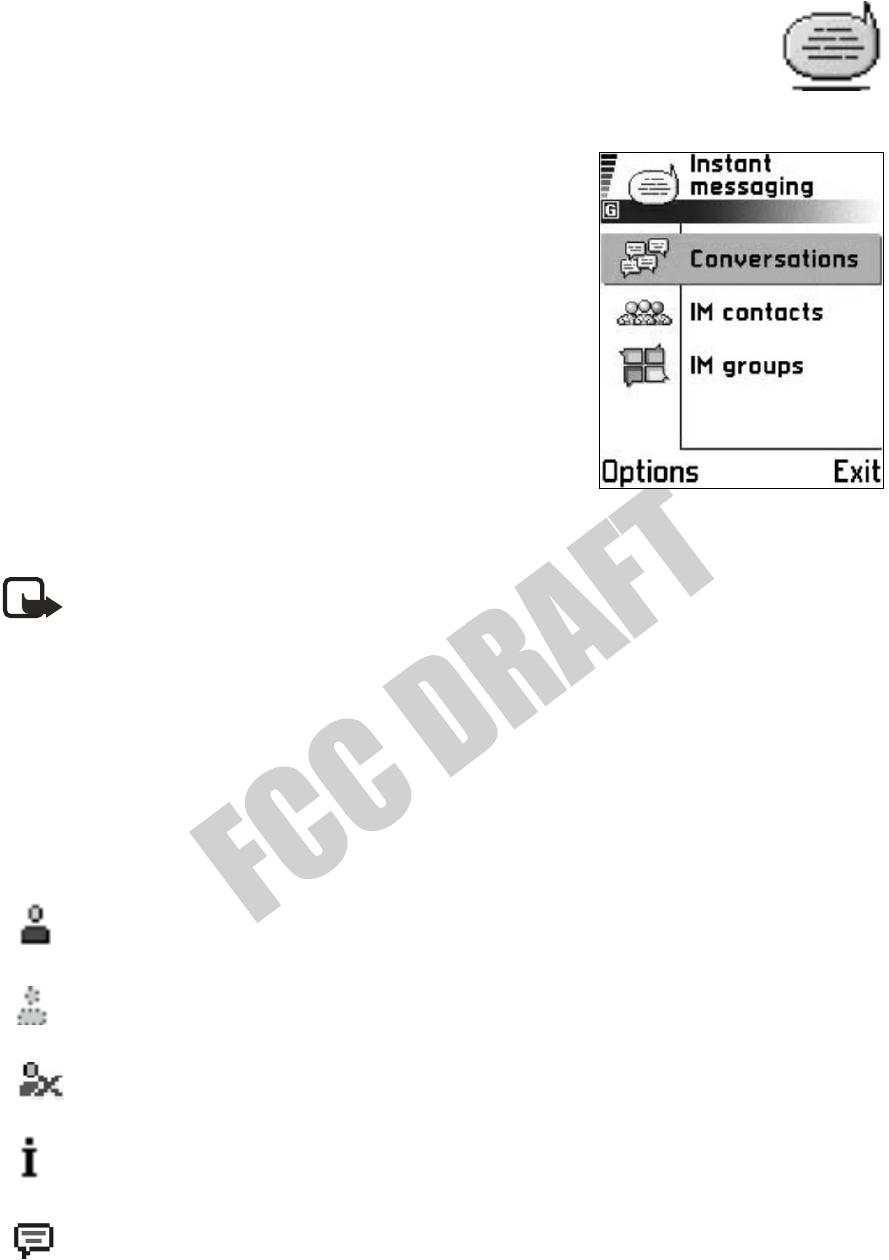
88 Copyright © 2004 Nokia
12 Instant messaging (IM)
(network service)
Select Menu > IM.
Options in Instant Messaging are Open, Login or
Logout, Settings, Help, and Exit.
Take text messaging to the next level by experiencing
instant messaging in a wireless environment. Engage
in instant messaging with friends and family as long
as you all use the same IM service. Check with your
wireless service provider for availability.
Before you can start using IM on your phone, you
must make sure that your phone can establish a GPRS
connection. You must also register with the IM service
you want to use. See “IM service provider icons” on page 88 for more information.
Note: Due to variations in IM and wireless service providers, you may not
have access to all of the features described in this guide.
• IM SERVICE PROVIDER ICONS
Since each IM service has its own display text and icons associated with it, the
display text and icons on your phone may appear differently for each IM service
provider. If you have any questions about the differences in the various IM service
providers’ display text and icons, contact your wireless service provider for more
information. Examples of IM icons and their descriptions are as follows:
Contact online
Contact not logged in to IM
Contact blocked
Tracking set for contact
New unread message

Nokia User GuideCopyright © 2004 Nokia
Instant messaging (IM) (network service)
• REGISTER WITH AN IM SERVICE
Before you can use IM, you must register with an IM service to obtain an IM user name
and password. You can obtain an IM user name and password by registering over the
Internet (using your computer) with the IM service provider you have selected to use.
During the registration process, you will have the opportunity to create the user name
and password of your choice. For more information about signing up for IM services,
contact your wireless service provider.
• BEFORE USING IM
Before you can use the IM feature, your phone must have at least one access
point defined. See "Access points" on page 60. An IM server must also be defined
in your phone:
1Select Menu > IM > Options > Settings > Server settings > Servers.
2Select a server from the list, or select Options > New server to define a
new server.
If you need help defining a new server, contact your wireless service provider
or IM service provider.
You must also obtain a user name and password (see “Register with an IM service”
on page 89). For more information about signing up for instant messaging services,
contact your wireless service provider.
•LOG IN
Select Menu > IM > Options > Login, enter your user name and password, and
press OK. After you have logged into IM initially, you have the option of a manual
login or an automatic login. See “Automatic login” on page 90.
• IM SETTINGS
You can customize your IM settings, depending upon the IM service you have selected.
Select Options > Settings > IM settings from the main IM menu screen, and
select the following:
Use screen name—Select Yes to key in a nickname (up to 10 characters).
IM presence—Select one of the following options:
•Active for all—All other users see your status as online and you receive
availability information and messages from all other users.
•Active for cntcts.—Even though only the contacts in IM contacts see your
status as online, you receive availability information and messages from all
other users.
•Not active—Your status to other users appears to be offline from the IM service,
but you receive availability information and messages from all other users.
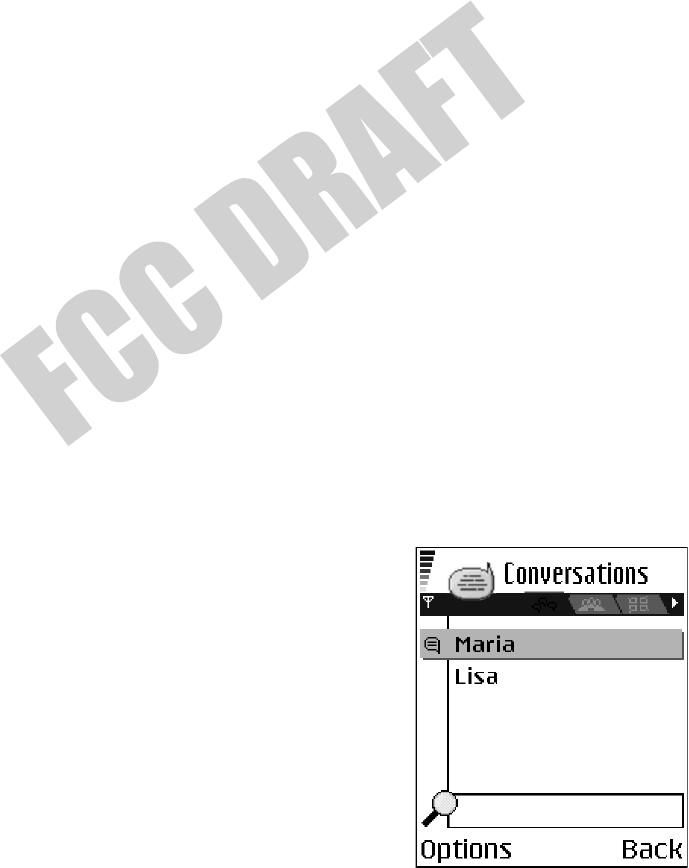
90 Copyright © 2004 Nokia
Allow messages from and Allow invitations from—These settings define whether
you receive instant messages or group invitations from All, IM contacts only, or None.
Message speed—Select the speed at which new messages are displayed.
Auto-reload availab.—Choose how to update information when your IM contacts
log in or out of the IM service. Select Automatically or Manually.
Reload user availab.—Use this setting to define which IM contacts are included in
a manual or automatic status update. Select For all contacts to refresh the status
information of all your IM contacts, or choose specific IM contacts.
Automatic login
You can log in automatically when you start the IM application. First you must
ensure that your IM user ID and password are entered for your IM server. To check
this, go to the IM main menu, and select Options > Settings > Server settings >
Servers and the IM server you are using. Scroll to the User ID and Password fields
to enter your information.
To turn automatic login on, scroll to the IM login type field in the Server settings
screen, and select On app. start-up. If you want to turn automatic login off,
select Manual.
Set up presence status updates
Presence allows you and other users to know who is online and available to chat.
You can set your phone to update a contact’s presence status automatically every
time it is changed. From the IM main menu, select Options > Settings >
IM settings > Reload user availab.
You can also designate whether your own presence information is updated when
you log in to IM. From the IM main menu, select Options > Settings > Server
settings > Presence login type > Automatic, Aut. in home net. (automatic in
home network), On app. start-up, or Manual.
For more information on the presence feature, see “Presence (network service)” on
page 27.
• IM CONVERSATIONS
Select Menu > IM > Conversations.
Options in Conversations are Open, Delete, Add to IM
contacts, New conversation, Set auto reply on, Blocking
options, Close conversation, Settings, Help, and Exit.

Nokia User GuideCopyright © 2004 Nokia
Instant messaging (IM) (network service)
You can send instant messages to anyone who uses the same IM service as you do,
as long as you have that person’s user name. You can also add that person to IM
contacts during an IM conversation. See “IM contacts” on page 92 for more
information. More than one IM conversation can be active at the same time.
Conversations lists all active conversations by IM contact name. Select one of the
names to open the conversation with that person. The contact’s name is displayed at
the top of the screen, and as the conversation progresses, the most recent message
appears at the bottom of the screen, causing the last message to move up one level.
Start a conversation
You must be able to select a contact who is online before you can begin a conversation.
1From the IM main menu, select Conversations.
2Select Options > New conversation > Select recipient or Enter User ID.
If you choose Select recipient, a list of your IM contacts who are currently
online is displayed. If you select Enter User ID, you must enter the exact user
ID of the contact.
After you select a recipient, a conversation view is opened with the recipient’s
name displayed at the top of the screen. The conversation is still active, even if you
leave the conversation view. You can return to it when you want by selecting
Conversations from the IM main menu.
Write and send to contact
1Start a new conversation or open an active one from Conversations.
2Enter your message in the field at the bottom of the screen. See "Write text"
on page 44.
3To send the message, press the Scroll key, or select Options > Send.
The message is displayed in the conversation view for that contact.
Receive message and reply
When you receive an instant message, your phone beeps (if the phone is not set to
the Silent profile) and the sender’s reply appears beneath the most recent message
in the conversation.
Select Conversations from the IM main menu and open the conversation with the
new message indicated by the icon. You can also select IM contacts from the
IM main menu, and the new message icon is displayed by the contact who sent you
the message. Select the name to open the conversation.

92 Copyright © 2004 Nokia
Save
To save your conversation or group chat, perform the following steps before you
end the conversation:
1From the conversation view or group conversation view, select Options >
Record convers.
2In the Conversation name screen, enter a name for the conversation, and
select OK.
The conversation is saved as a note under the Extras phone menu.
3To stop recording the conversation, select Options > Stop recording.
To view saved conversations, select Menu > Extras > Notes, and open the
conversation you want to view.
To delete a saved conversation, highlight it in the list of Notes documents, and
select Options > Delete.
End a conversation
Select Conversations from the IM main menu, open the conversation you want to
end, and select Options > End conversation.
•IM CONTACTS
Add to IM contacts the names of your friends and family with whom you want to
interact frequently through IM.
Options in IM contacts are Open conversation, Contact details, Switch tracking on or
off, New IM contact, Edit, Delete, Blocking options, My server contacts, Search, Settings,
Help, and Exit.
Add manually or from phone Contacts list
From the IM main menu, select IM contacts > Options > New IM contact and
one of the following:
Enter manually—This option opens a new contact card. At a minimum, you must
enter an exact IM user ID in the User ID field. You may also enter a first name, last
name, and other contact numbers on this contact card. If you want to modify the
contact card later, see “Contacts” on page 24.
Add from Contacts—This option displays a list of entries from your contact
directory. To select a contact to add to your IM contacts list, scroll to the contact,
and press the Scroll key to select it (this places an X in the box beside the contact
name). When you have chosen all the contacts you want to add, press OK.

Nokia User GuideCopyright © 2004 Nokia
Instant messaging (IM) (network service)
Search
To search for a person or group that is currently online, from the IM contacts
screen, select Options > Search and one of the following:
Groups—Select this option to search for an IM group by Group name, Topic, or
Group members. If you search by group member, you must enter the member’s
exact IM user ID.
Users—Select this option to search for an IM user by User’s name, User ID, Phone
number, or E-mail address. The search criteria does not have to be an exact match
for the item for which you are searching.
Add contact to IM contacts during IM session
1Select Conversations from the IM main menu.
2Scroll to the contact you want to add, and select Options > Add to IM
contacts. You can also open the conversation, and select Options > Add to
IM contacts.
A contact card is opened for the new contact, and the contact’s IM user ID is
automatically entered in the User ID field. You may also specify a first name,
last name, and other contact phone numbers on this contact card.
3Select Options > OK.
Remove
From the IM main menu, select IM contacts, the contact you want to remove, and
Delete > Yes.
Block and unblock
To block a contact, select the contact name in IM contacts or in Conversations,
and select Options > Blocking options > Add to blocked list.
To unblock one or more contacts from the IM contacts list or from an open
conversation, select Options > Blocking options > Unblock, scroll to the contact,
and press the Scroll key to select it (this places an X in the box beside the contact
name). When you have chosen all the contacts you want to unblock, press OK.
View blocked list
From the IM contacts list or from an open conversation, select Options > Blocking
options > View blocked list.
Set or remove alert
To set an alert for a contact to notify you when the contact’s availability changes, go
to the IM contacts screen, and select the contact for whom you want to set an alert;
then select Options > Switch tracking on.
To remove the alert, select Options > Switch tracking off.
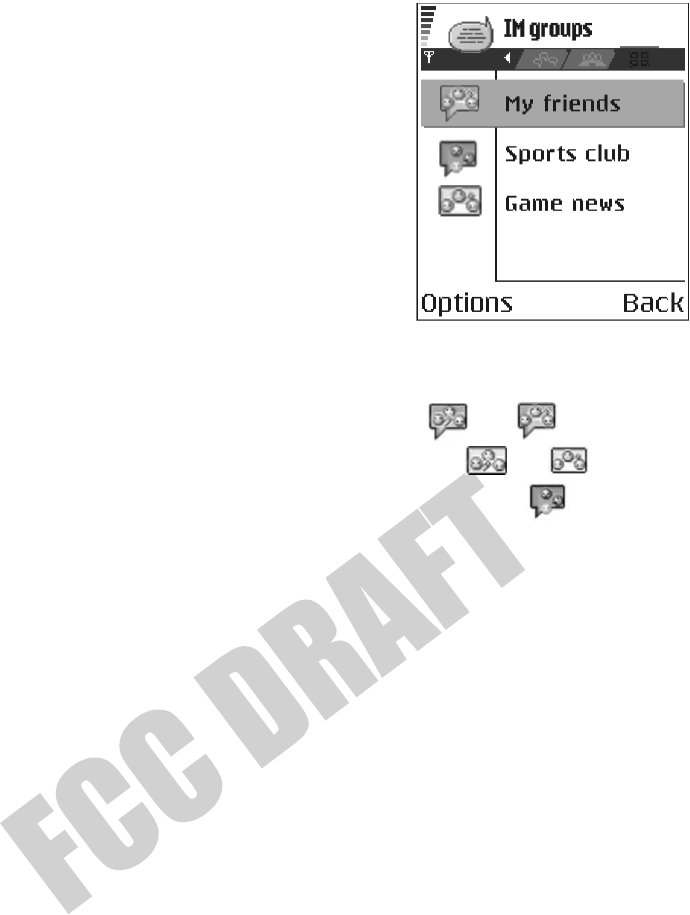
94 Copyright © 2004 Nokia
• GROUP CHAT SESSIONS
Select IM groups from the IM main menu.
The group chat feature allows you to converse with
multiple participants simultaneously. You can create
your own private group chats or be invited to join a
live group chat in progress. During a group chat, all
messages are displayed in one group conversation
view screen. You can also save a group chat history.
See “Save” on page 92.
In IM groups, a list of IM groups that you have saved
or are currently joined to is shown. The icon next to a
group indicates whether it is:
•A group that you saved and are currently joined to ( or )
•A group that you saved but are not currently joined to ( or )
•A group that you are currently joined to but have not saved ( )
Options in the IM groups view are Open, Join group, Create new group, Leave IM group,
IM group, Search, Settings, Help, and Exit.
Options when you have an IM group conversation open are Send, Send private msg.,
Reply, Forward, Send invitation, Leave IM group, Add to banned list, IM group, Record
convers. or Stop recording, Help, and Exit.
Create chat group
1From the IM main menu, select IM groups > Options > Create new group.
2Select each of the following options and follow the prompts to enter the
appropriate information:
Group name—Enter a name for the new group, and select OK.
Group topic—Enter a conversation topic for the group, and select OK. The
default topic is General.
Welcome note—Enter a welcome note of up to 100 characters, and select OK.
The welcome note is displayed to any group member who logs in to the group.
Group size—Enter the maximum group size, and select OK. The default size is
100 members.
Allow search—Determine whether search engines are allowed to show the
chat group as a search result. Select either Yes or No.
Editing rights—Determine which group members should have rights to edit
group properties. To give a member editing rights, scroll to that member name
and press the Scroll key to mark the name. When you are finished, select OK.
The Group creator always has editing rights and cannot be unmarked.

Nokia User GuideCopyright © 2004 Nokia
Instant messaging (IM) (network service)
Group members—Determine whether to restrict the chat group to a list of
members or to allow anyone to participate. Select either Selected only (chat
group is restricted to a list of members) or All (anyone can join the chat group).
See “Add and remove group members” on page 95 for more information.
Banned list—Select contacts that cannot join the group or send messages to
the group.
Allow private msgs.—Determine whether participants in the chat group are
allowed to send private messages during a group chat. Select either Yes or No.
3Select Back.
4Enter your screen name and select OK.
You are connected to the new group conversation in the group conversation view.
Join or leave a chat group
From the IM main menu, select IM groups, and select the group you want to join.
Enter your screen name, and select OK. You are connected to the group conversation
in the group conversation view, and the name of the chat group is displayed at the
top of the screen.
To leave the group, select Options > Leave IM group.
Add and remove group members
You can restrict a chat group to selected members by adding and removing contacts
from the group members list.
1In the group conversation view, select Options > IM group > IM group
settings > Group members.
2Scroll to Selected only, and select OK.
The Group members screen is displayed.
3To add a member, at the Group members screen, select Options > Add member,
and one of the following:
•IM contact to select from your list of IM contacts.
•Enter user ID to enter the exact IM user ID.
4To remove a member, at the Group members screen, scroll to the contact’s
name, and select Options > Remove.
5To remove all group members, at the Group members screen, select Options >
Remove all.
6When you are finished designating group members, select Back and then
Done to return to the group conversation view.

96 Copyright © 2004 Nokia
Send an invitation for a group chat
Members must be online before you can invite them to a group chat.
1From the group conversation view, select Options > Send invitation.
2Scroll to the contacts whom you want to invite to the group chat, press the
Scroll key to insert an X into the box beside the contact name, and select OK.
3Enter an invitation message, and select Done.
The invitation is sent.
4To invite other members to the group, repeat steps 2–3.
When a member accepts an invitation, a message is displayed in the group
conversation view announcing that the member has joined.
Accept or reject invitations to group chat
When you receive an invitation to a group chat, select Accept, enter your screen
name, and select OK to accept the invitation.
To reject the invitation, select Reject.
Chat with group members
All group chat messages are displayed in the group conversation view. The sender
name is displayed in front of each message.
Enter a message in the text entry area at the bottom of the screen; then select
Options > Send, or press the Scroll key.
Your message is displayed in the group conversation view under the last
message received.
If you close the group conversation view while the group chat is still active, you
can return to it. In the IM main menu, select IM groups; then select the name of
the chat group.
Send a private message
While you are in a group chat, you can send a private message to one or more
members of the group. The message cannot be seen by other group members who
are not included in the private message.
1From the group conversation view, select Options > Send private msg.
2Select the contact to whom you want to send the private message.
3Enter the message; then select Options > Send, or press the Scroll key.

Nokia User GuideCopyright © 2004 Nokia
Instant messaging (IM) (network service)
• LOG OFF SERVICE
To close the IM application and log out of the IM service at the same time, press
Exit from the IM main menu. Ongoing conversations are automatically closed
when you exit IM.
To log out of the IM service but leave the IM application open, go to the IM main
menu and select Options > Logout.
You can also exit the IM application but still stay connected to the IM service. Press
and hold the phone Menu key to bring up a list of open applications, and select
Telephone to return to the standby mode.
This enables you to receive instant messages from your contacts, when using your
phone for other purposes, for example, if you want to send a text message. If you
are connected to your IM service, but you have not used the IM application for
some time, you may be automatically disconnected from the IM service. The next
time you open the IM application, you must log in again. If you make a phone call,
you will be disconnected from the IM service.
To return to the IM application, you can either select Menu > IM, or you can press
and hold the Menu key again, and select IM from the list of open applications.
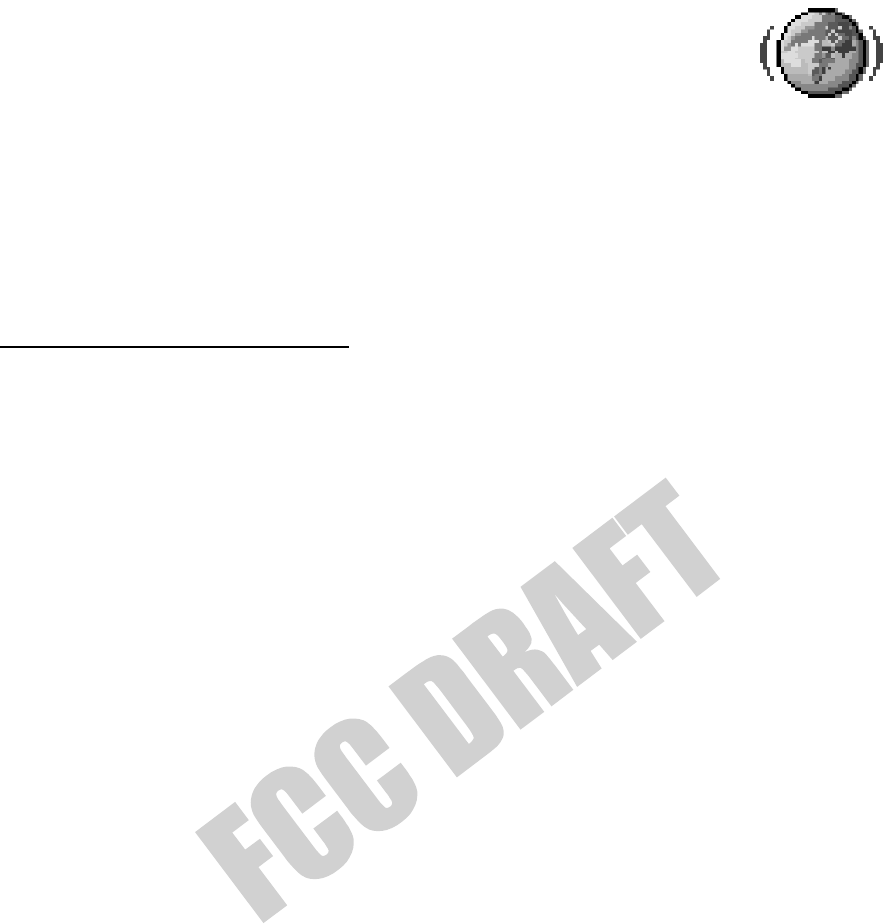
98 Copyright © 2004 Nokia
13 Web (mobile browser)
Select Menu > Web, or press and hold the 0key in the standby mode.
Various service providers maintain pages specifically designed for
mobile phones, offering services such as news, weather reports, banking, travel
information, entertainment, and games. With the mobile browser you can view
these services as WML, XHTML, or HTML pages.
If you have not yet used your phone to make a WAP connection, you may need to
contact your service provider for assistance with the first connection, or visit
www.nokia.com/phonesettings.
Check the availability of services, pricing, and tariffs with your network operator
and/or service provider. Service providers will also give you instructions on how to
use their services.
• BASIC STEPS FOR WEB ACCESS
1Save the settings that are needed to access the browser service that you want
to use. See "Browser service set-up" on page 98.
2Make a connection to the service. See "Make a connection" on page 99.
3Start browsing the web pages. See "Browse" on page 100.
4End the connection to the service. See "End a connection" on page 102.
• BROWSER SERVICE SET-UP
Receive settings in a smart message
You may receive service settings in a special text message called a smart message
from the network operator or service provider that offers the service. See "Smart
messages" on page 49. For more information, contact your network operator or
service provider.
Enter settings manually
Follow the instructions given to you by your service provider.
1Select Menu > Settings > Connection > Access points and define the
settings for an access point. See "Connection" on page 60.
2Select Menu > Web > Options > Bookmark manager > Add bookmark.
3Write a name for the bookmark and the address of the browser page defined
for the current access point.
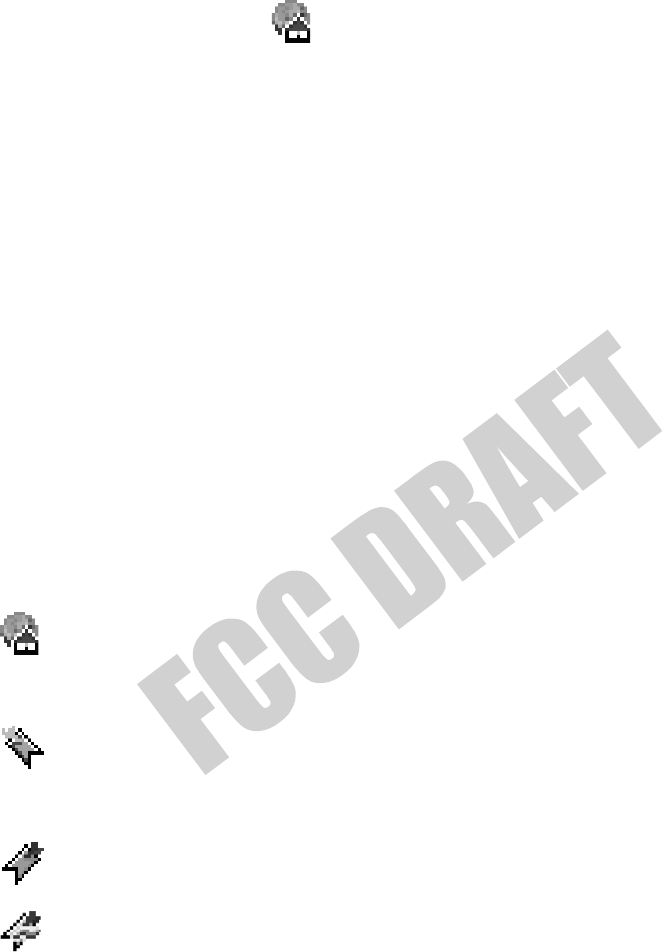
Nokia User GuideCopyright © 2004 Nokia
Web (mobile browser)
• MAKE A CONNECTION
Once you have stored all the required connection settings, you can access
browser pages.
There are three different ways to access browser pages:
•Select the homepage ( ) of your service provider.
•Select a bookmark from the Bookmarks view.
•Press the keys 2–9 to start to write the address of a browser service. The Go to
field at the bottom of the display is immediately activated, and you can
continue to write the address there.
After you have selected a page or written the address, press the Scroll key to start
downloading the page.
•BOOKMARKS
Your device may have some preinstalled bookmarks for sites not affiliated with Nokia.
Nokia does not warrant or endorse these sites. If you choose to access them, you
should take the same precautions for security or content as you would with any site.
In the Bookmarks view, you can see bookmarks pointing to different kinds of
browser pages. When you scroll through bookmarks, you can see the address of the
highlighted bookmark in the Go to field at the bottom of the display.
Bookmarks are indicated by the following icons:
Options in Bookmarks (when a bookmark or folder is selected) are Open, Download,
Back to page, Bookmark manager, Mark/Unmark, Navigation options, Advanced
options, Send, Find bookmark, Details, Settings, Help, and Exit.
Add bookmarks manually
1In Bookmarks, select Options > Bookmark manager > Add bookmark.
The starting page defined for the browser access point. If you use
another browser access point for browsing, the starting page is
changed accordingly.
The last visited page. When the phone is disconnected from the service,
the address of the last visited page is kept in memory until a new page
is visited during the next connection.
A bookmark showing the title.
An automatic bookmark. See "Add bookmarks automatically" on page 100.

100 Copyright © 2004 Nokia
2Start to fill in the fields.
Only the address must be defined. The default access point is assigned to the
bookmark if no other one is selected. Press the *key to enter special characters
such as /, ., :, and @. Press the Clear key to clear characters.
3Select Options > Save to save the bookmark.
Add bookmarks automatically
When you visit a web page, your browser automatically saves a bookmark in the
automatic bookmarks folder ( ), which is located in the list of bookmarks when
you open the Web application. Automatic bookmarks can be renamed and deleted,
but they cannot be moved. To modify automatic bookmarks settings, select
Options > Settings > Automatic bookmarks > On, Hide Folder, or Off.
• BROWSE
On a browser page, new links appear underlined in blue and previously visited links
in purple. Images that act as links have a blue border around them.
Options when browsing are Open, Open Wallet, Service options, Bookmarks, Save
as bookmark, Navigation options, Advanced options, Send bookmark, Find, Details,
Settings, Help, and Exit.
Keys and commands used in browsing
•To open a link, press the Scroll key.
•To scroll the view, use the Scroll key.
•To enter letters and numbers in a field, press the 0–9 keys. Press the *key to enter
special characters such as /, ., :, and @. Press the Clear key to clear characters.
•To go to the previous page while browsing, press Back. If Back is not available,
select Options > Navigation options > History to view a chronological list of
the pages you have visited during a browsing session. The history list is cleared
each time a session is closed.
•To check boxes and make selections, press the Scroll key.
•To retrieve the latest content from the server, select Options > Navigation
options > Reload.
•To open a sublist of commands or actions for the currently open browser page,
select Options > Service options.
•To disconnect from a browser service and to quit browsing, select Options >
Advanced options > Disconnect.
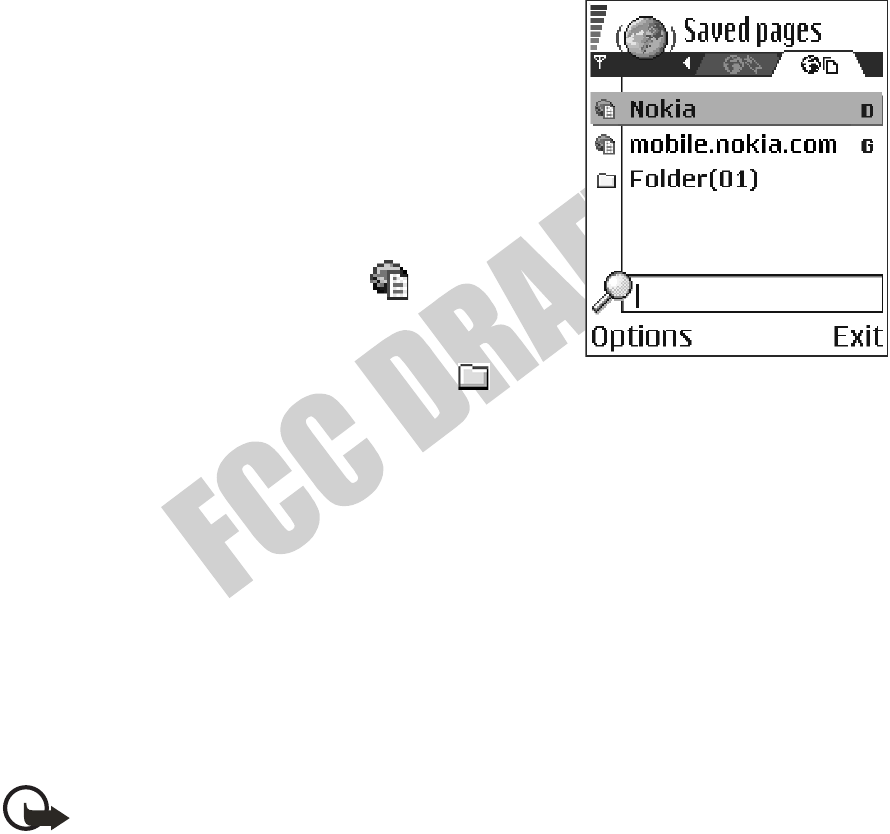
Nokia User Guide Copyright © 2004 Nokia
Web (mobile browser)
Save bookmarks
•To save a bookmark while browsing, select Options > Save as bookmark.
•To save a bookmark received in a smart message, select Menu > Messaging >
Inbox, open the message, and select Options > Save to bookmarks. See
"Smart messages" on page 49.
View saved pages
Options in Saved pages are Open, Back to page, Reload, Saved pages mngr., Mark/
Unmark, Navigation options, Advanced options, Details, Settings, Help, and Exit.
If you regularly browse pages containing
information that does not change very often, you
can save and then browse them when not logged in.
To save a page, while browsing select Options >
Advanced options > Save page.
To open saved pages, scroll right in the Bookmarks
view. In the Saved pages view, press the Scroll key
to open a saved page.
Saved pages are indicated by the icon. In the
Saved pages view you can also create folders to
store your saved browser pages. Folders containing
saved browser pages are indicated by the icon.
To start a connection to the browser service and to retrieve the page again, select
Options > Navigation options > Reload. The phone stays online after you reload
the page.
• DOWNLOAD
You can download items such as ringing tones, images, operator logos, software,
and video clips through the mobile browser. These items may be provided free, or
you can purchase them. To clear the cache after downloads, see “Clear the cache”
on page 102.
Once downloaded, items are handled by the respective applications on your phone
(for example, a downloaded photo will be saved in Gallery).
Important: Only install applications from sources that offer adequate
protection against harmful software.
Purchase an item
To download an item:
1Scroll to the link and select Options > Open.
2Choose the appropriate option to purchase the item, for example, Buy.
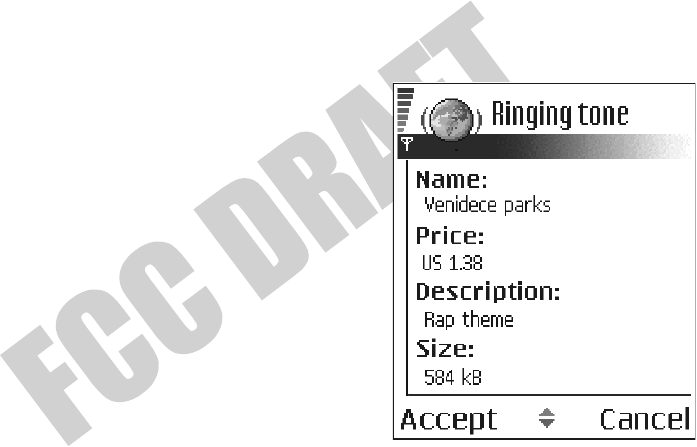
102 Copyright © 2004 Nokia
Carefully read all the information provided.
If the online content is compatible, you can use your wallet information to make
the purchase:
1Select Open wallet.
2Enter your wallet code. See "Enter the wallet code" on page 83.
3Select the appropriate card category from your wallet.
4Select Fill in.
This uploads the selected wallet information.
If the wallet does not contain all information necessary for the purchase, you will
be requested to enter the remaining details manually.
The information or services you access are stored in the cache. To empty the cache,
see “Clear the cache” on page 102.
Copyright protections may prevent some images, ringing tones, and other content
from being copied, modified, transferred, or forwarded.
Check an item before downloading
You can see details about an item before you
download it. Details about an item may include the
price, a brief description, and size.
1Scroll to the link and select Options > Open.
Details about the item are displayed on
your phone.
2If you want to continue with the downloading,
press Accept, or if you want to cancel the
download, press Cancel.
• END A CONNECTION
Select Options > Advanced options > Disconnect, or press and hold the End key
to quit browsing and return to the standby mode.
• CLEAR THE CACHE
A cache is a memory location that is used to store data temporarily. The information
or services you access are stored in the cache memory of the phone. If you have
tried to access or have accessed confidential information requiring passwords,
empty the cache after each use. To empty the cache, select Options > Navigation
options > Clear cache.

Nokia User GuideCopyright © 2004 Nokia
Web (mobile browser)
• BROWSER SETTINGS
From the Bookmarks screen, select Options > Settings and one of the following:
Default access point—To change the default access point, press the Scroll key to
open a list of available access points. The current default access point is highlighted.
See "Connection" on page 60.
Show images—Choose if you want to view pictures when you are browsing. If you
choose No, you can later load images during browsing by selecting Options >
Show images.
Font size—You can choose 5 text sizes in the browser: Largest, Large, Normal,
Small, and Smallest.
Default encoding—Choose a language setting to make sure your browser pages
display text characters correctly.
Automatic bookmarks—Select On, Hide Folder, or Off. When you select Hide
Folder, bookmarks are still automatically added to the Automatic bookmarks
folder. See "Add bookmarks automatically" on page 100.
Screen size—Select Normal screen, Select. keys only, or Full screen to change
how the browser window is displayed in your phone screen.
Rendering—Select By quality or By speed to determine how web pages are loaded.
Cookies—Select Allow or Reject. You can enable or disable the receiving and
sending of cookies (a means of content providers to identify users and their
preferences for frequently used content).
Security warnings—Choose to Hide or Show security warnings.
Confirm touch tones—Select Always or First sending only. Choose whether you
want to confirm before the phone sends DTMF tones during a voice call. For
example, you can make a voice call while you are viewing a browser page, send
DTMF tones while a voice call is in progress, and save a name and phone number
in Contacts from a browser page. See "Options during a call" on page 20.
Wallet—Choose On if you want the wallet to open automatically when a
compatible browser page is opened.
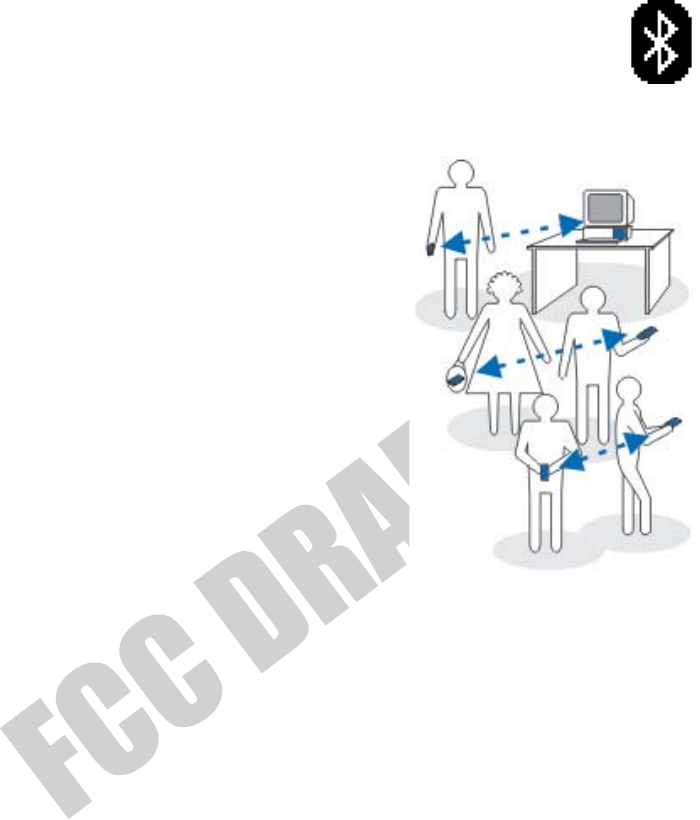
104 Copyright © 2004 Nokia
14 Connectivity
• BLUETOOTH CONNECTION
Select Menu > Connect. > Bluetooth.
There may be restrictions on using Bluetooth devices in some locations.
Check with your local authorities or service provider.
Bluetooth technology enables wireless connections
between electronic devices within a maximum range
of 30 feet (10 meters). A Bluetooth connection can be
used to send images, videos, texts, business cards, and
calendar notes, or it can be used to connect wirelessly
to compatible devices supporting the same Bluetooth
protocols, such as computers.
Since devices using Bluetooth technology communicate
using radio waves, your phone and the other devices
do not need to be in direct line-of-sight. The two
devices only need to be within a maximum of 30 feet
(10 meters) of each other, although the connection
can be subject to interference from obstructions such
as walls or from other electronic devices.
When you activate a Bluetooth connection for the first time, you are asked to give
a name to your phone.
Bluetooth device compatibility
This phone is designed to be compliant with and to adopt Bluetooth Specification 1.1.
However, interoperability between the phone and other products with Bluetooth
wireless technology depends also on the profiles and protocols used. To ensure
interoperability between other devices supporting Bluetooth technology, use Nokia
approved enhancements for this phone. Check with the manufacturers of other
devices to determine their compatibility with this device. The Nokia 6670 phone
supports the following profiles:
•Dial-up networking profile as a gateway
•Object push profile as a client and server
•File transfer profile as a server
•Hands-free profile as an audio gateway
•Generic object exchange profile
•Generic access profile
•Serial port profile with the PC connectivity software
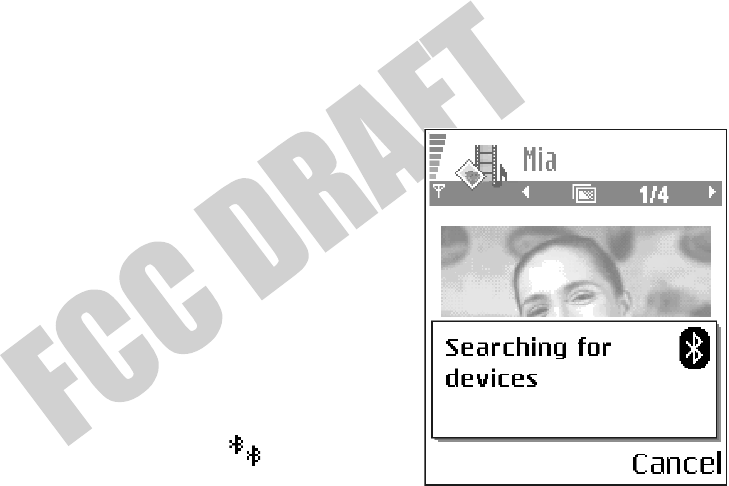
Nokia User GuideCopyright © 2004 Nokia
Connectivity
For more information on the compatibility between Bluetooth devices, consult
their manufacturers.
Bluetooth connection settings
•Bluetooth—Select On if you want to use a Bluetooth connection. If you select
Off, all active Bluetooth connections are ended, and Bluetooth connection
cannot be used for sending or receiving data.
•My phone’s visibility—If you select Shown to all, your phone can be found by
other devices during device search. If you select Hidden, your phone cannot
be found by other devices.
•My phone’s name—Define a name for your phone.
After you have set your Bluetooth connection as active and changed My phone's
visibility to All, your phone and this name can be seen by other devices.
Send data by Bluetooth connection
Your phone can only have one active Bluetooth connection at a time.
1Open an application where the item you wish to send is stored.
For example, to send a photo to another device,
open the Gallery application.
2Scroll to the item you want to send, and select
Options > Send > Via Bluetooth.
The phone starts to search for devices within
range. Devices using Bluetooth technology that
are within range start to appear on the display
one by one. You can see a device icon, the
device name, the device type, or a short name.
Paired devices are shown with . A paired
device is one where a Bluetooth connection
already exists between your phone and the
other device.
To interrupt the search, press Stop. The device list freezes and you can start to
form a connection to one of the devices already found.
When searching for devices, some devices may show only the unique device
addresses. To find out the unique address of your phone, enter the code *#2820#
in the standby mode.
If you have searched for devices earlier, a list of the devices that were found
previously is shown first. To start a new search, select More devices. If you
switch off the phone, the list of devices is cleared and the device search needs
to be started again before sending data.
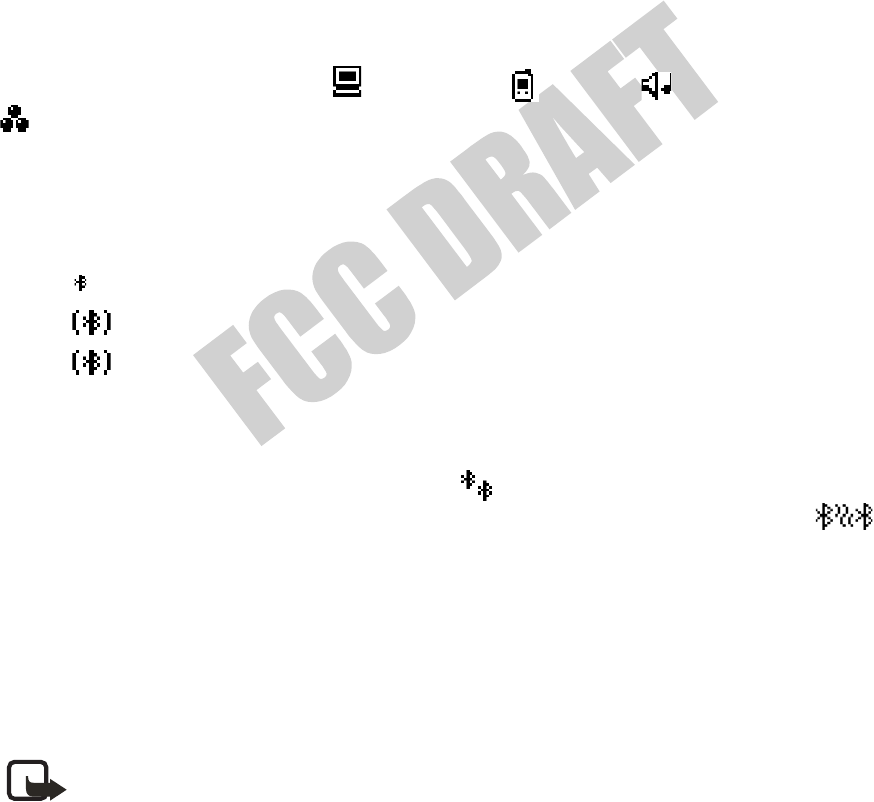
106 Copyright © 2004 Nokia
3Scroll to the device with which you want to connect and press Select.
The item you are sending is copied to Outbox and the note Connecting is shown.
4Pairing (if not required by the other device, go to step 5.)
•If the other device requires pairing before data can be transmitted, a tone
sounds and you are asked to enter a passcode.
•Create your own passcode (1–16 characters long, numeric) and agree with
the owner of the other device to use the same code. This passcode is used
only once and you do not have to memorize it. Devices that do not have a
user interface have a preset passcode. See "Paired devices view" on page 106.
•After pairing, the device is saved to the Paired devices view.
5When the connection has been successfully established, Sending data is shown.
Copyright protections may prevent some images, ringing tones, and other content
from being copied, modified, transferred, or forwarded.
Data received by Bluetooth connection can be found in the Inbox folder in
Messaging. See "Inbox—receive messages" on page 48.
Icons for different devices are —Computer, —Phone, —Audio/video, and
—Bluetooth device
If sending fails, the message or data will be deleted. The Drafts folder in Messaging
does not store messages sent by Bluetooth connection.
Check Bluetooth connection status
When is shown in the standby mode, Bluetooth connection is active.
When is blinking, your phone is trying to connect to the other device.
When is shown continuously, the Bluetooth connection is active.
Paired devices view
Pairing with a device makes device searches easier and quicker. Paired devices are
easier to recognize; they are indicated by in the search result list. In the
Bluetooth connection main view, scroll right to open a list of paired devices ( ).
•To pair with a device, select Options > New paired device. The phone starts a
device search. Scroll to the device with which you want to pair and press Select.
After you exchange passcodes, the device is added to the paired devices list.
•To cancel pairing, scroll to the device whose pairing you want to cancel and
press the Clear key or select Options > Delete. If you want to cancel all
pairings, select Options > Delete all.
Note: If you are currently connected to a device and you delete the
pairing with that device, the pairing is removed and the device connection
is terminated, but the Bluetooth connection remains active on your phone.
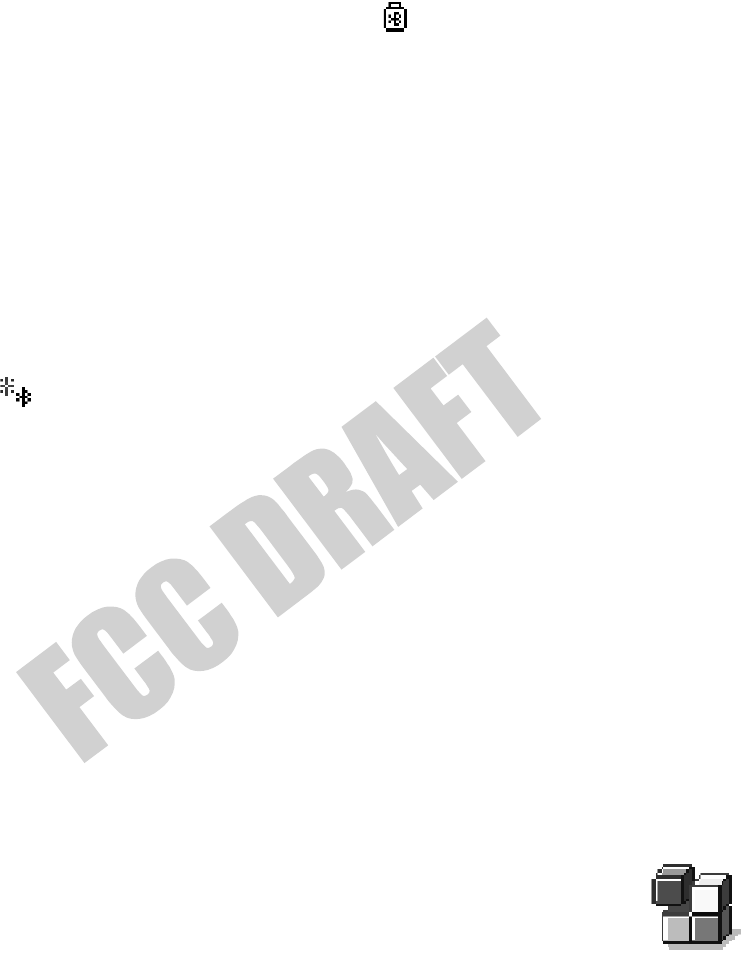
Nokia User GuideCopyright © 2004 Nokia
Connectivity
•To set a device to be authorized or unauthorized, scroll to the device, select
Options, and then select one of the following:
Set as authorized—Connections between your phone and this device can be
made without your knowledge. No separate acceptance or authorization is
needed. Use this status for your own devices, for example, your PC, or devices
that belong to someone you trust. The icon is added next to authorized
devices in the Paired devices view.
Set as unauthorized—Connection requests from this device need to be
accepted separately every time.
•To assign a short name to a device, select Options > Assign short name. Enter
a name for the device.
Receive data by Bluetooth connection
When you receive data by Bluetooth connection, a tone is played, and you are
asked if you want to accept the message. If you accept, the item is placed in the
Inbox folder in Messaging. Messages received by Bluetooth connection are
indicated by . See "Inbox—receive messages" on page 48.
Close the Bluetooth connection
A Bluetooth connection is disconnected automatically after sending or receiving data.
• USB CONNECTION
You can use the Connectivity Cable DKU-2 to connect your Nokia 6670 phone to the
USB port on your computer. Before using the connectivity cable, you must install the
cable driver prior to PC Suite installation. Carefully follow the installation instructions
given in the PC Suite user guide and the DKU-2 (USB) installation guide on the
CD-ROM supplied with the phone.
Making or answering phone calls during a computer connection is not recommended
because it might disrupt the operation.
• CONNECTION MANAGER
Select Menu > Connect. > Conn. mgr..
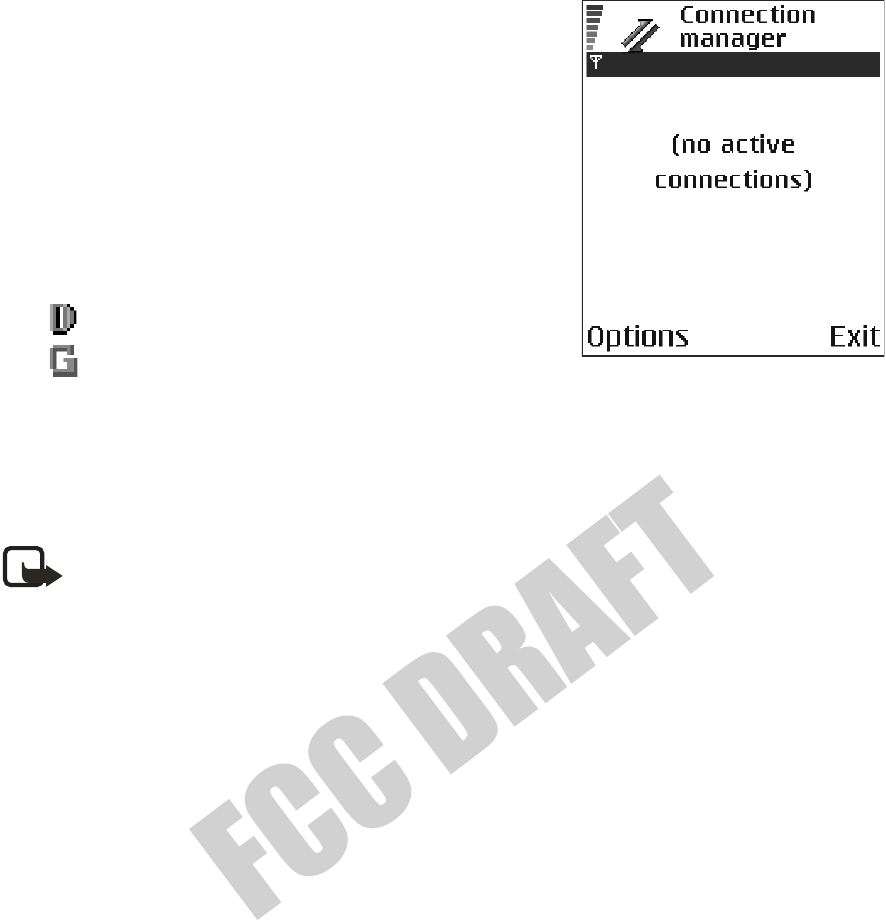
108 Copyright © 2004 Nokia
In Connection manager you can identify the
status of multiple data connections, view details
on the amount of data sent and received, and end
unused connections.
You can view details of data connections only. Voice
calls are not listed.
When you open Connection manager, you can see
the following:
•Open data connections:
Data call
GPRS
•The status of each connection
•Amount of data uploaded and downloaded for each connection (GPRS
connections only)
•The duration of each connection (data call connections only)
Note: The actual time invoiced by your service provider may vary,
depending on network features, rounding off for billing, and so forth.
Options in Connection manager when there are one or more connections are
Details, Disconnect, Disconnect all, Help, and Exit.
View connection details
To view the details of a connection, scroll to a connection and select Options >
Details. The following information is displayed:
Name—The name of the Internet access point (IAP) in use
Bearer—The type of data connection: Data call or GPRS
Status—The current status of the connection
Received—The amount of data, in bytes, received to the phone
Sent—The amount of data, in bytes, sent from the phone
Duration—The length of time that the connection has been open
Speed—The current speed of both sending and receiving data in kB/s
Dial-up (GSM) or Name (GPRS)—The GSM dial-up number used or the name of the
GPRS access point used
Shared—The number of applications using the same connection. This option is not
displayed if the connection is not shared.
End connections
Scroll to a connection and select Options > Disconnect to end that connection
only, or select Options > Disconnect all to close all currently open connections.

Nokia User GuideCopyright © 2004 Nokia
Connectivity
• CONNECT YOUR PHONE TO A COMPUTER
For further information on how to make a connection to a compatible computer by
USB or Bluetooth connection and how to install PC Suite, see the PC Suite user
guide on the CD-ROM supplied with the phone. For further information on how to
use Nokia PC Suite, see the help function on PC Suite or visit the support pages at
www.nokia.com.
• USE THE CD-ROM
The CD-ROM should launch itself after you have inserted it into the CD-ROM drive
of your compatible PC. If not, proceed as follows:
1Click the Windows Start button and select Programs > Windows Explorer.
2On the CD-ROM drive, locate a file called PCSuite_us.exe and double-click it.
The CD-ROM interface opens.
3Locate PC Suite in the Install Software section.
4Double-click the Nokia PC Suite file. The installation wizard will guide you
through the installation process.
• SYNCHRONIZATION
Select Menu > Connect. > Sync.
The Sync application enables you to synchronize your calendar,
contacts, and notes with various calendar, address book, and notes
applications on a compatible computer or on the Internet.
Remote synchronization takes place over a Web or Bluetooth connection that you
can initiate from your phone. Local synchronization takes place by a data cable
connection to your PC.
The synchronization application uses SyncML technology for synchronization. For
information on SyncML compatibility, contact the supplier of the calendar, address
book, or notes application with which you want to synchronize your phone data.
Create a new synchronization profile
Options in the Sync main view are Synchronize, New sync profile, Edit sync profile,
Delete, Help, and Exit.
1Select Options > New sync profile.
2Choose whether you want to use the default setting values or copy the values
from an existing profile to be used as the basis for the new profile.
3Define the following:
Sync profile name—Write a descriptive name for the profile.

110 Copyright © 2004 Nokia
Data bearer—Select Web or Bluetooth as your synchronization method.
Access point—Select the access point you want to use for the data connection.
This option is only available if you choose Web in the Data bearer setting.
Host address—Contact your service provider or system administrator for the
correct values.
Port—Contact your service provider or system administrator for the correct
values. This option is only available if you choose Web in the Data bearer setting.
User name—Your user ID for the synchronization server. Contact your service
provider or system administrator for your correct ID.
Password—Write your password. Contact your service provider or system
administrator for the correct value.
4Scroll right and select which applications you would like to synchronize:
Contacts—Select Yes if you want to synchronize your contacts.
Calendar—Select Yes if you want to synchronize your calendar.
Notes—Select Yes if you want to synchronize your notes.
When you select Yes to synchronize each of these applications, you must
also specify:
•Remote database—Enter the correct path to the server for the remote
address book (to sync with Contacts), the remote calendar (to sync with
Calendar), or the remote notes application (to sync with Notes).
•Synchronization type—Select Normal, To server only, or To phone only.
5Press Done to save the settings.
Synchronize data
In the Sync main view, you can see the different profiles, and what kind of data
will be synchronized: Calendar, Contacts, Notes, or all three.
1In the main view, scroll to a profile and select Options > Synchronize. The
status of the synchronization is shown at the bottom of the screen.
To cancel synchronization before it is finished, press Cancel.
You are notified when the synchronization has been completed.
2After synchronization is complete, press View log, or select Options > View log
to open a log file showing the synchronization status (Complete or Incomplete)
and how many calendar, contact, and notes entries have been added, updated,
deleted, or discarded (not synchronized) in the phone or on the server.

Nokia User GuideCopyright © 2004 Nokia
Troubleshooting
15 Troubleshooting
•SIM CARD
A SIM (subscriber identity module) card is required for your Nokia GSM phone to
operate. The SIM card is supplied by your service provider and has your mobile
phone number and all subscriber account information programmed on it.
You can save contact information from your contacts list on the SIM card so that
when you use the SIM card in another GSM phone or terminal, your phone number
and contacts will be available to you on the SIM card rather than stored in phone
memory. Note that you can only save names and phone numbers on the SIM card.
The SIM card in the Nokia 6670 phone is located under the battery in the top left
corner. The SIM card must be inserted under the hood and the gold-colored
contacts on the card must make direct contact with the gold-colored contacts in
the card slot. See “Insert the SIM card” on page 7.
•MEMORY LOW
When one of the following notes is shown, the phone memory is low and you must
delete some data:
•Not enough memory to perform operation.
•Delete some data first.
•Memory low. Delete some data.
To view what kind of data you have and how much memory the different data
groups consume, select Menu > Tools > File mngr. > Options > Memory details.
You may want to delete the following items regularly to avoid memory getting low:
•Messages from the Inbox, Drafts, and Sent folders in Messaging.
•Retrieved e-mail messages from the phone memory.
•Saved browser pages.
•Images, video clips, and sound clips in Gallery.
If you want to delete contact information, calendar notes, call timers, call cost timers,
game scores, or any other data, go to the respective application to remove the data.
If you are deleting multiple items and one of the low memory notes is shown again,
try deleting items one by one (starting from the smallest item).

112 Copyright © 2004 Nokia
• DIFFERENT WAYS TO STORE DATA
•Use Nokia PC Suite to make a backup copy of all data to your computer. See
"Connect your phone to a computer" on page 109.
•Send images to your e-mail address and then save the images to your computer.
•Send data by Bluetooth connection to a compatible device.
•Store data on a compatible memory card.
•PHONE DISPLAY
If missing, discolored, or bright dots appear on the screen when you turn on your
phone, this is a characteristic of this type of display. Some displays may contain
pixels or dots that remain on or off. This is normal, not a fault.
• BLUETOOTH CONNECTION
If you cannot end a Bluetooth connection, check to see if another device is pairing
with (connected to) your phone but not sending data. If so, you can disconnect it by
deactivating the Bluetooth link altogether. Select Menu > Connect. > Bluetooth,
and select Bluetooth > Off.
If you cannot find a device using Bluetooth technology, check the following:
•Both devices have activated their Bluetooth connections.
•The distance between the two devices is not over 30 feet (10 meters) or that
there are no walls or other obstructions between the devices.
•The other device is not in Hidden mode.
•Both devices are compatible.
• MULTIMEDIA MESSAGING
If the phone cannot receive a multimedia message because memory is full, check
the amount of memory in use (see “Memory low” on page 111).
If the notes Retrieving message or Trying to retrieve message again are shown
briefly, your phone is trying to retrieve a multimedia message from the multimedia
messaging center. To stop the notes from displaying, you need to end the data
connection because the phone is attempting to start the connection again and
again. Also, try the following solutions:
Check that the settings for multimedia messaging have been defined correctly and
that there are no mistakes in phone numbers or addresses. Select Menu >
Messaging > Options > Settings > Multimedia message.

Nokia User GuideCopyright © 2004 Nokia
Troubleshooting
To stop the phone from making a data connection, you have the following options.
Select Menu > Messaging > Options > Settings > Multimedia message, and then:
•Select On receiving msg. > Defer retrieval if you want the multimedia
messaging center to save the message to be retrieved later, for example, after
you have checked the settings. After this change, the phone still needs to send
information notes to the network. When you want to retrieve the message,
select Retr. immediately.
•Select On receiving msg. > Reject message if you want to reject all incoming
multimedia messages. After this change, the phone needs to send information
notes to the network and the multimedia messaging center will delete all
multimedia messages that are waiting to be sent to you.
•Select Multimedia reception > Off if you want to ignore all incoming
multimedia messages. After this change the phone will not make any network
connections related to multimedia messaging.
• MESSAGING
If you are composing a message and you cannot select a contact from the contacts
directory, the contact card does not have a phone number or an e-mail address.
Add the missing information to the contact card in Contacts.
• BROWSER SERVICES
If you receive the message No valid access point defined. Define one in Web
settings, you need to insert the proper browser settings. Contact your service
provider for instructions.
•LOG
If the log appear empty, you may have activated a filter, and no communication
events fitting that filter have been logged. To see all events in Logs, select
Options > Filter > All communication.
• PC CONNECTIVITY
If you have problems connecting the phone to a PC, make sure that Nokia PC Suite
is installed and running on the PC. See the PC Suite user guide on the CD-ROM
provided with the phone. For further information on how to use PC Suite, see the
help function of PC Suite, or visit the support pages at www.nokia.com.
• APPLICATION NOT RESPONDING
If you need to close an application that is not responding, open the application
switching window by pressing and holding the Menu key. Then scroll to the
application, and press the Clear key to close the application.

114 Copyright © 2004 Nokia
16 Reference information
• BATTERY INFORMATION
Your device is powered by a rechargeable battery. The full performance of a new
battery is achieved only after two or three complete charge and discharge cycles.
The battery can be charged and discharged hundreds of times but it will eventually
wear out. When the talk and standby times are noticeably shorter than normal, buy
a new battery. Use only Nokia approved batteries, and recharge your battery only
with Nokia approved chargers designated for this device.
Unplug the charger from the electrical plug and the device when not in use. Do not
leave the battery connected to a charger. Overcharging may shorten its lifetime. If
left unused, a fully charged battery will lose its charge over time. Temperature
extremes can affect the ability of your battery to charge.
Use the battery only for its intended purpose. Never use any charger or battery that
is damaged.
Do not short-circuit the battery. Accidental short-circuiting can occur when a
metallic object such as a coin, clip, or pen causes direct connection of the positive
(+) and negative (-) terminals of the battery. (These look like metal strips on the
battery.) This might happen, for example, when you carry a spare battery in your
pocket or purse. Short-circuiting the terminals may damage the battery or the
connecting object.
Leaving the battery in hot or cold places, such as in a closed car in summer or
winter conditions, will reduce the capacity and lifetime of the battery. Always try
to keep the battery between 59°F and 77°F (15°C and 25°C). A device with a hot or
cold battery may not work temporarily, even when the battery is fully charged.
Battery performance is particularly limited in temperatures well below freezing.
Do not dispose of batteries in a fire! Dispose of batteries according to local
regulations. Please recycle when possible. Do not dispose as household waste.
•ENHANCEMENTS
A few practical rules about accessories and enhancements:
•Keep all accessories and enhancements out of the reach of small children.
•When you disconnect the power cord of any accessory or enhancement, grasp
and pull the plug, not the cord.
•Check regularly that enhancements installed in a vehicle are mounted and are
operating properly.
•Installation of any complex car enhancements must be made by qualified
personnel only.
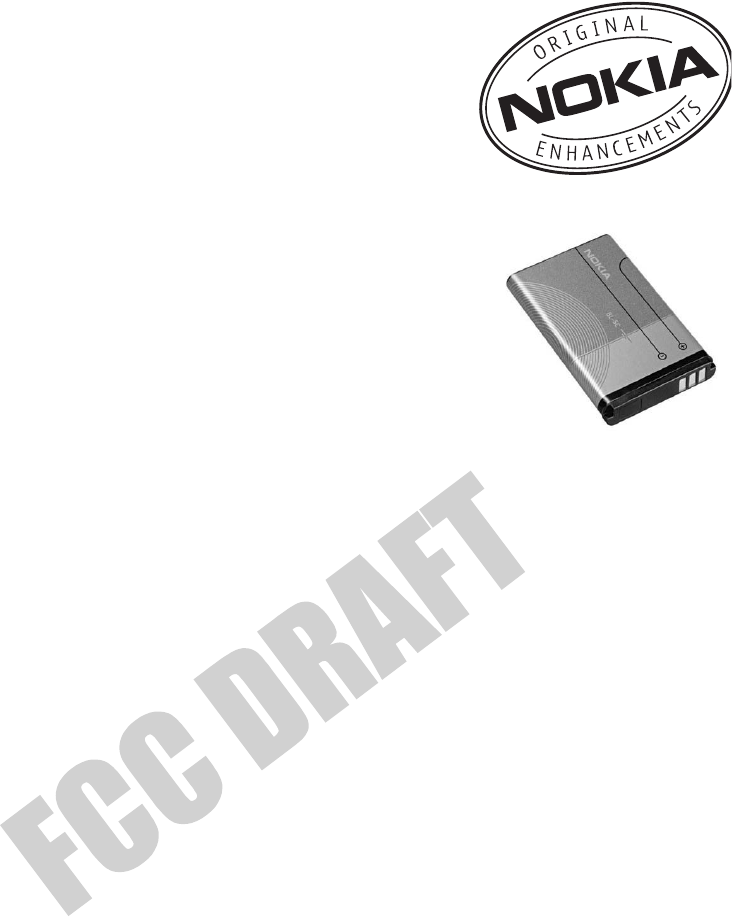
Nokia User GuideCopyright © 2004 Nokia
Reference information
• ENHANCEMENTS, BATTERIES, AND
CHARGERS
For availability of approved enhancements, check with
your dealer.
Battery
The 900 mAh, Li-Ion based BL-5C battery provides power
in a thin and light package. Variation in operation times
will occur depending on the charger used, the SIM card,
network and usage settings, usage style, and environments.
See "Technical information" on page 121.
This device is intended for use when supplied with power
from ACP-12.
See also “Insert the battery” on page 9 and “Charge the
battery” on page 9.
Other compatible Nokia enhancements
Headset audio
•Wireless headsets (HDW-2 and HS-3W)
•Wireless boom headset (HS-4W)
•Boom headset (HDB-4)
•Standard headset (HS-5)
•Retractable headset (HS-10)
•Phone adapter (HDA-10) (See “Phone
adapter HDA-10 accessibility
enhancement” on page 116.)
Power
•Charger (ACP-12)
•Retractable charger (AC-1)
Data
•Connectivity cable (DKU-2)
•RS-MMC (64 MB and 128 MB)
Car
•Wireless car kit (CK-1W)
•Mobile charger (LCH-12)
Imaging
•Nokia observation camera
•Image viewer (SU-5)
•Image album (PD-1)
•Camera flash (PD-2)
Messaging
•Digital pen (SU-1B)
Cover/carrying
•Xpress-on™ covers and
style packs
•Wrist strap
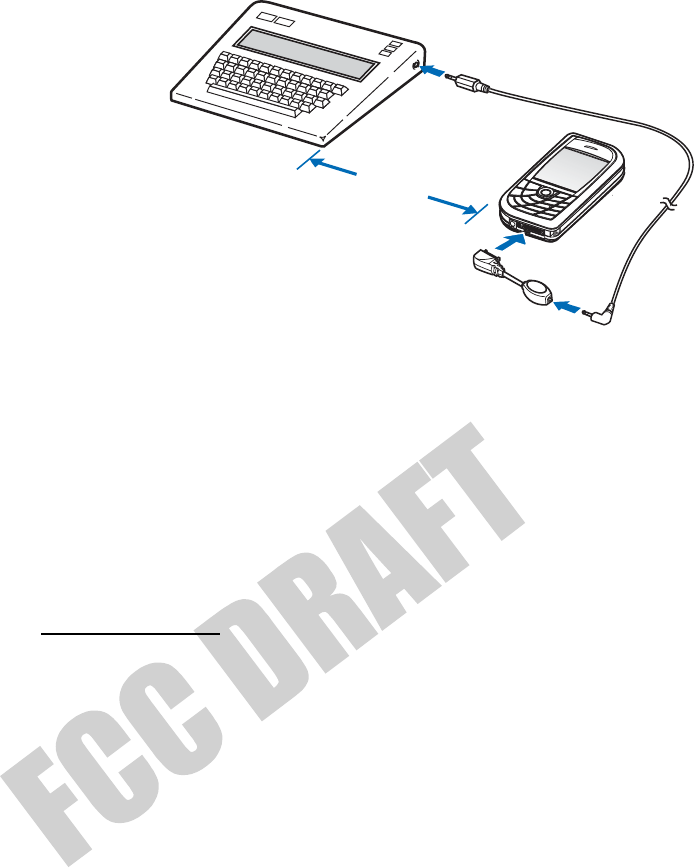
116 Copyright © 2004 Nokia
Phone adapter HDA-10 accessibility enhancement
The HDA-10 phone adapter is a
Nokia enhancement that allows
you to connect your mobile
phone to a Telecommunications
Device for the Deaf (TTY/TDD)
to make a call in digital mode.
If you are using a phone adapter,
you must activate it on your
mobile phone by selecting
Menu > Settings >
Enhancement > Enhancement
in use > TTY.
In addition to the Nokia 6670 phone, you will need the following for
TTY/TDD communication:
•A TTY/TDD device that is cellular ready or cellular compatible
•A cable for connecting the TTY/TDD to your phone, usually supplied by the
manufacturer of the TTY/TDD device
•The phone adapter (HDA-10), which can be purchased separately as an
enhancement at www.nokia.com
For more information, see “Accessibility solutions” on page 6.
• CARE AND MAINTENANCE
Your device is a product of superior design and craftsmanship and should be
treated with care. The suggestions below will help you protect your warranty
coverage and enjoy your device for many years.
•Keep the device dry. Precipitation, humidity, and all types of liquids or moisture
can contain minerals that will corrode electronic circuits. If your device does get
wet, remove the battery and allow the device to dry completely before replacing it.
•Do not use or store the device in dusty, dirty areas. Its moving parts and
electronic components can be damaged.
•Do not store the device in hot areas. High temperatures can shorten the life of
electronic devices, damage batteries, and warp or melt certain plastics.
•Do not store the device in cold areas. When the device returns to its normal
temperature, moisture can form inside the device and damage electronic
circuit boards.
•Do not attempt to open the device other than as instructed in this guide.
18 in.

Nokia User GuideCopyright © 2004 Nokia
Reference information
•Do not drop, knock, or shake the device. Rough handling can break internal
circuit boards and fine mechanics.
•Do not use harsh chemicals, cleaning solvents, or strong detergents to
clean the device.
•Do not paint the device. Paint can clog the moving parts and prevent
proper operation.
•Use a soft, clean, dry cloth to clean any lenses (such as camera, proximity
sensor, and light sensor lenses).
•Use only the supplied or an approved replacement antenna. Unauthorized
antennas, modifications, or attachments could damage the device and may
violate regulations governing radio devices.
All of the above suggestions apply equally to your device, battery, charger, or any
enhancement. If any device is not working properly, take it to the nearest
authorized service facility for service.
• ADDITIONAL SAFETY INFORMATION
Operating environment
Remember to follow any special regulations in force in any area and always switch
off your device when its use is prohibited or when it may cause interference or
danger. Use the device only in its normal operating positions. This device meets RF
exposure guidelines when used either in the normal use position against the ear or
when positioned at least 7/8 inch (2.2 cm) away from the body. When a carry case,
belt clip, or holder is used for body-worn operation, it should not contain metal and
should position the device at least 7/8 inch (2.2 cm) away from your body.
Parts of the device are magnetic. Metallic materials may be attracted to the device,
and persons with a hearing aid should not hold the device to the ear with the
hearing aid. Always secure the device in its holder, because metallic materials may
be attracted by the earpiece. Do not place credit cards or other magnetic storage
media near the device, because information stored on them may be erased.
Medical devices
Operation of any radio transmitting equipment, including wireless phones, may
interfere with the functionality of inadequately protected medical devices. Consult
a physician or the manufacturer of the medical device to determine if they are
adequately shielded from external RF energy or if you have any questions. Switch
off your phone in health care facilities when any regulations posted in these areas
instruct you to do so. Hospitals or health care facilities may be using equipment
that could be sensitive to external RF energy.

118 Copyright © 2004 Nokia
PACEMAKERS
Pacemaker manufacturers recommend that a minimum separation of 6 inches
(15.3 cm) be maintained between a wireless phone and a pacemaker to avoid
potential interference with the pacemaker. These recommendations are consistent
with the independent research by and recommendations of Wireless Technology
Research. To minimize the potential for interference, persons with pacemakers should:
•Always keep the device more than 6 inches (15.3 cm) from their pacemaker
when the device is switched on
•Not carry the device in a breast pocket
•Hold the device to the ear opposite the pacemaker
If you have any reason to suspect that interference is taking place, switch off your
device immediately.
HEARING AID
Some digital wireless devices may interfere with some hearing aids. If interference
occurs, consult your service provider.
Vehicles
RF signals may affect improperly installed or inadequately shielded electronic systems
in motor vehicles such as electronic fuel injection systems, electronic antiskid
(antilock) braking systems, electronic speed control systems, air bag systems. For
more information, check with the manufacturer or its representative of your
vehicle or any equipment that has been added.
Only qualified personnel should service the device, or install the device in a vehicle.
Faulty installation or service may be dangerous and may invalidate any warranty
that may apply to the device. Check regularly that all wireless device equipment in
your vehicle is mounted and operating properly. Do not store or carry flammable
liquids, gases, or explosive materials in the same compartment as the device, its
parts, or enhancements. For vehicles equipped with an air bag, remember that an
air bags inflate with great force. Do not place objects, including installed or portable
wireless equipment in the area over the air bag or in the air bag deployment area.
If in-vehicle wireless equipment is improperly installed and the air bag inflates,
serious injury could result.

Nokia User GuideCopyright © 2004 Nokia
Reference information
Potentially explosive environments
Switch off your device when in any area with a potentially explosive atmosphere and
obey all signs and instructions. Potentially explosive atmospheres include areas where
you would normally be advised to turn off your vehicle engine. Sparks in such areas
could cause an explosion or fire resulting in bodily injury or even death. Switch off the
device at refuelling points such as near gas pumps at service stations. Observe
restrictions on the use of radio equipment in fuel depots, storage, and distribution
areas, chemical plants or where blasting operations are in progress. Areas with a
potentially explosive atmosphere are often but not always clearly marked. They
include below deck on boats, chemical transfer or storage facilities, vehicles using
liquefied petroleum gas (such as propane or butane), and areas where the air
contains chemicals or particles such as grain, dust or metal powders.
FCC regulations prohibit using your wireless device while in the air. The use of
wireless telephones in an aircraft may be dangerous to the operation of the
aircraft, disrupt the wireless telephone network, and may be illegal.
Failure to observe these instructions may lead to suspension or denial of telephone
services to the offender, legal action, or both.
• EMERGENCY CALLS
Important: Wireless phones, including this phone, operate using radio
signals, wireless networks, landline networks, and user-programmed
functions. Because of this, connections in all conditions cannot be
guaranteed. You should never rely solely on any wireless phone for
essential communications like medical emergencies.
To make an emergency call:
1If the phone is not on, switch it on. Check for adequate signal strength. Some
networks may require that a valid SIM card is properly inserted in the phone.
2Press the End key as many times as needed to clear the display and ready the
phone for calls.
3Key in the official emergency number for your present location. Emergency
numbers vary by location.
4Press the Send key.
If certain features are in use, you may first need to turn those features off before
you can make an emergency call. Consult this guide or your service provider. When
making an emergency call, give all the necessary information as accurately as
possible. Your wireless phone may be the only means of communication at the
scene of an accident. Do not end the call until given permission to do so.

120 Copyright © 2004 Nokia
• Certification information (SAR)
THE NOKIA 6670 DEVICE MEETS GUIDELINES FOR EXPOSURE TO RADIO WAVES.
Your mobile device is a radio transmitter and receiver. It is designed and manufactured
not to exceed the limits for exposure to radio frequency (RF) energy recommended by
international guidelines (ICNIRP). These limits establish permitted levels of RF energy for
the general population. The guidelines are based on standards that were developed by
independent scientific organizations through periodic and thorough evaluation of
scientific studies. The standards and guidelines include a substantial safety margin
designed to assure the safety of the public, regardless of age and health and to account
for any variations in measurements.
The exposure guidelines for mobile devices employ a unit of measurement known as the
Specific Absorption Rate or SAR. The SAR limit stated in the international guidelines is 2.0
watts/kilogram (W/kg) averaged over ten grams of tissue. Tests for SAR are conducted
using standard operating positions with the device transmitting at its highest certified
power level in all tested frequency bands. The actual SAR level of an operating device can
be well below the maximum value because the device is designed to use only the power
required to reach the network. That amount changes depending on a number of factors
such as how close you are to a network base station. The highest SAR value when tested
according to international testing procedures for use at the ear for device type RH-67 is
0.22 W/kg and for device type RH-68 is 0.52 W/kg. Your phone’s device type is listed on
the label located under the battery.
SAR values may vary depending on national reporting and testing requirements and the
network band. Use of device accessories and enhancements may result in different SAR
values. Additional SAR information may be provided under product information at
www.nokia.com.
USA and Canada: The SAR limit of USA (FCC) and Canada (IC) is 1.6 W/kg averaged over
one gram of tissue. Device types RH-67 and RH-68 have also been tested against this SAR
limit. The highest SAR value reported under this standard during product certification
for use at the ear for device type RH-67 is 0.42 W/kg and when properly worn on the
body is 0.58 W/kg. The highest SAR value reported under this standard during product
certification for use at the ear for device type RH-68 is 0.73 W/kg and when properly
worn on the body is 0.60 W/kg. Information about this device can be found on the FCC's
website at <http://www.fcc.gov/oet/fccid> by searching the equipment authorization
system using FCC ID: QVVRH-67 and QVVRH-68.
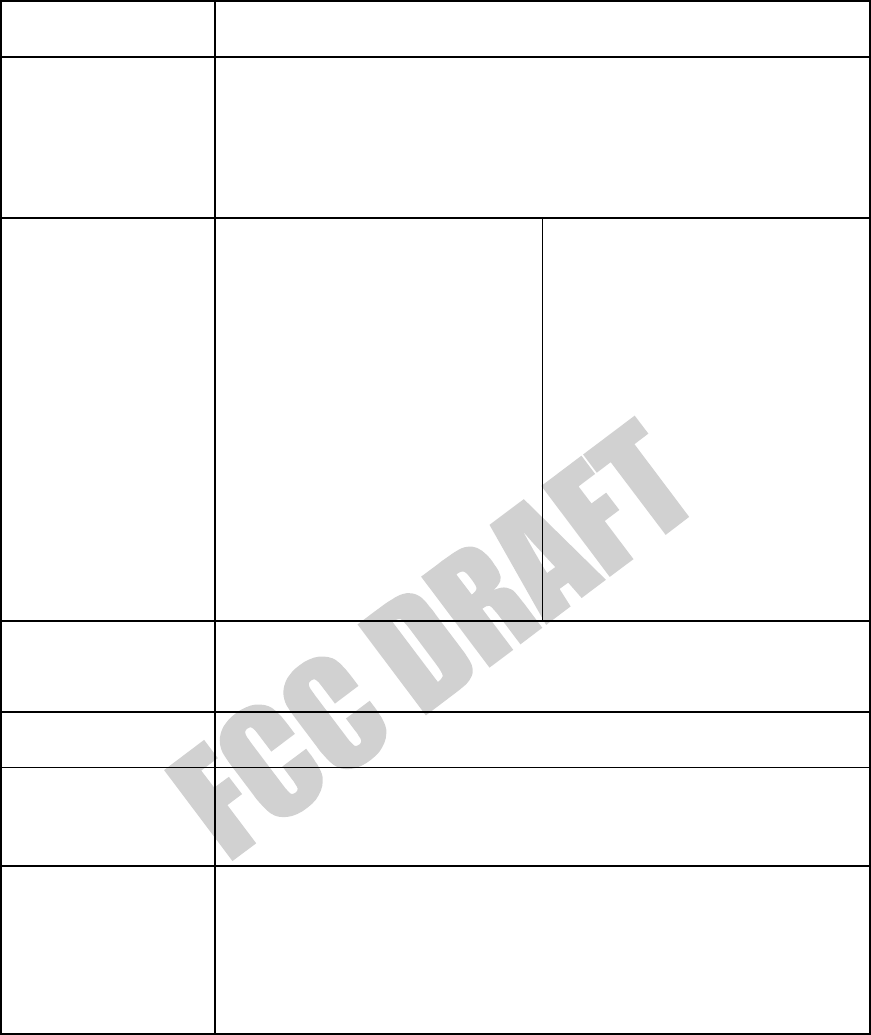
Nokia User GuideCopyright © 2004 Nokia
Reference information
• TECHNICAL INFORMATION
Weight 4.16 oz (118 g) with 900–mAh Li-Ion battery
Size Volume: 5.7 cubic inches (93.5 cc)
Length: 4.27 in (108.6 mm)
Width: 2.1 in (53.0 mm)
Thickness: 0.7 in (18.7 mm)
Frequency range Nokia 6670
GSM900
880–915 MHz (TX)
925–960 MHz (RX)
GSM1800
1710–1785 MHz (TX)
1805–1880 MHz (RX)
GSM1900
1850–1910 MHz (TX)
1930–1990 MHz (RX)
Nokia 6670 b
GSM850
824–849 MHz (TX)
869–894 MHz (RX)
GSM1800
1710–1785 MHz (TX)
1805–1880 MHz (RX)
GSM1900
1850–1910 MHz (TX)
1930–1990 MHz (RX)
Transmitter
output power
Up to 2 W
Battery voltage 3.7 V
Operating
temperature
14°F to + 131°F
(-10°C to +55°C)
aTalk time,
standby time
a. Battery talk and standby times are estimates only and depend on signal strength,
network conditions, features used, battery age and condition (including the
effect of charging habits), temperatures to which battery is exposed, use in digital
mode, and many other factors. Please note that the amount of time a phone is
used for calls will affect its standby time. Likewise, the amount of time that the
phone is turned on and in the standby mode will affect its talk time.
Talk time: up to 3 hours
Stand-by time: up to 10 days
Charging time with 900–mAh Li-Ion battery and the
ACP-12 charger: approximately 1.5 hours

122 Copyright © 2004 Nokia

Nokia User Guide Copyright © 2004 Nokia
Appendix A
Appendix A
Message from the CTIA
(Cellular Telecommunications
& Internet Association)
to all users of mobile phones.
&HOOXODU7HOHFRPPXQLFDWLRQV&,QWHUQHW$VVRFLDWLRQ$OO5LJKWV
5HVHUYHG&RQQHFWLFXW$YHQXH1:6XLWH:DVKLQJWRQ'&
3KRQH

124 Copyright © 2004 Nokia
6DIHW\LVWKHPRVWLPSRUWDQWFDOO\RXZLOOHYHUPDNH
A Guide to Safe and Responsible Wireless Phone Use
7HQVRIPLOOLRQVRISHRSOHLQWKH86WRGD\WDNHDGYDQWDJHRIWKHXQLTXH
FRPELQDWLRQRIFRQYHQLHQFHVDIHW\DQGYDOXHGHOLYHUHGE\WKHZLUHOHVVWHOHSKRQH
4XLWHVLPSO\WKHZLUHOHVVSKRQHJLYHVSHRSOHWKHSRZHUIXODELOLW\WRFRPPXQLFDWH
E\YRLFHDOPRVWDQ\ZKHUHDQ\WLPHZLWKWKHERVVZLWKDFOLHQWZLWKWKHNLGV
ZLWKHPHUJHQF\SHUVRQQHORUHYHQZLWKWKHSROLFH(DFK\HDU$PHULFDQVPDNH
ELOOLRQVRIFDOOVIURPWKHLUZLUHOHVVSKRQHVDQGWKHQXPEHUVDUHUDSLGO\JURZLQJ
%XWDQLPSRUWDQWUHVSRQVLELOLW\DFFRPSDQLHVWKRVHEHQHILWVRQHWKDWHYHU\ZLUHOHVV
SKRQHXVHUPXVWXSKROG:KHQGULYLQJDFDUGULYLQJLV\RXUILUVWUHVSRQVLELOLW\$
ZLUHOHVVSKRQHFDQEHDQLQYDOXDEOHWRROEXWJRRGMXGJPHQWPXVWEHH[HUFLVHGDW
DOOWLPHVZKLOHGULYLQJDPRWRUYHKLFOHZKHWKHURQWKHSKRQHRUQRW
7KHEDVLFOHVVRQVDUHRQHVZHDOOOHDUQHGDVWHHQDJHUV'ULYLQJUHTXLUHVDOHUWQHVV
FDXWLRQDQGFRXUWHV\,WUHTXLUHVDKHDY\GRVHRIEDVLFFRPPRQVHQVHNHHS\RXUKHDG
XSNHHS\RXUH\HVRQWKHURDGFKHFN\RXUPLUURUVIUHTXHQWO\DQGZDWFKRXWIRURWKHU
GULYHUV,WUHTXLUHVREH\LQJDOOWUDIILFVLJQVDQGVLJQDOVDQGVWD\LQJZLWKLQWKHVSHHG
OLPLW,WPHDQVXVLQJVHDWEHOWVDQGUHTXLULQJRWKHUSDVVHQJHUVWRGRWKHVDPH
%XWZLWKZLUHOHVVSKRQHXVHGULYLQJVDIHO\PHDQVDOLWWOHPRUH7KLVEURFKXUHLVD
FDOOWRZLUHOHVVSKRQHXVHUVHYHU\ZKHUHWRPDNHVDIHW\WKHLUILUVWSULRULW\ZKHQ
EHKLQGWKHZKHHORIDFDU:LUHOHVVWHOHFRPPXQLFDWLRQVLVNHHSLQJXVLQWRXFK
VLPSOLI\LQJRXUOLYHVSURWHFWLQJXVLQHPHUJHQFLHVDQGSURYLGLQJRSSRUWXQLWLHVWR
KHOSRWKHUVLQQHHG
:KHQLWFRPHVWRWKHXVHRIZLUHOHVVSKRQHVVDIHW\LV\RXUPRVWLPSRUWDQWFDOO
Wireless Phone "Safety Tips"
%HORZDUHVDIHW\WLSVWRIROORZZKLOHGULYLQJDQGXVLQJDZLUHOHVVSKRQHZKLFK
VKRXOGEHHDV\WRUHPHPEHU
*HWWRNQRZ\RXUZLUHOHVVSKRQHDQGLWVIHDWXUHVVXFKDVVSHHGGLDODQGUHGLDO
&DUHIXOO\UHDG\RXULQVWUXFWLRQPDQXDODQGOHDUQWRWDNHDGYDQWDJHRIYDOXDEOH
IHDWXUHVPRVWSKRQHVRIIHULQFOXGLQJDXWRPDWLFUHGLDODQGPHPRU\$OVRZRUN
WRPHPRUL]HWKHSKRQHNH\SDGVR\RXFDQXVHWKHVSHHGGLDOIXQFWLRQZLWKRXW
WDNLQJ\RXUDWWHQWLRQRIIWKHURDG
:KHQDYDLODEOHXVHDKDQGVIUHHGHYLFH$QXPEHURIKDQGVIUHHZLUHOHVVSKRQH
DFFHVVRULHVDUHUHDGLO\DYDLODEOHWRGD\:KHWKHU\RXFKRRVHDQLQVWDOOHGPRXQWHG
GHYLFHIRU\RXUZLUHOHVVSKRQHRUDVSHDNHUSKRQHDFFHVVRU\WDNHDGYDQWDJHRI
WKHVHGHYLFHVLIDYDLODEOHWR\RX
3RVLWLRQ\RXUZLUHOHVVSKRQHZLWKLQHDV\UHDFK0DNHVXUH\RXSODFH\RXU
ZLUHOHVVSKRQHZLWKLQHDV\UHDFKDQGZKHUH\RXFDQJUDELWZLWKRXWUHPRYLQJ
\RXUH\HVIURPWKHURDG,I\RXJHWDQLQFRPLQJFDOODWDQLQFRQYHQLHQWWLPHLI
SRVVLEOHOHW\RXUYRLFHPDLODQVZHULWIRU\RX
6XVSHQGFRQYHUVDWLRQVGXULQJKD]DUGRXVGULYLQJFRQGLWLRQVRUVLWXDWLRQV/HW
WKHSHUVRQ\RXDUHVSHDNLQJZLWKNQRZ\RXDUHGULYLQJLIQHFHVVDU\VXVSHQGWKH
FDOOLQKHDY\WUDIILFRUKD]DUGRXVZHDWKHUFRQGLWLRQV5DLQVOHHWVQRZDQGLFH
FDQEHKD]DUGRXVEXWVRLVKHDY\WUDIILF$VDGULYHU\RXUILUVWUHVSRQVLELOLW\LV
WRSD\DWWHQWLRQWRWKHURDG

Nokia User Guide Copyright © 2004 Nokia
Appendix A
'RQRWWDNHQRWHVRUORRNXSSKRQHQXPEHUVZKLOHGULYLQJ,I\RXDUHUHDGLQJDQ
DGGUHVVERRNRUEXVLQHVVFDUGRUZULWLQJDWRGROLVWZKLOHGULYLQJDFDU\RX
DUHQRWZDWFKLQJZKHUH\RXDUHJRLQJ,W·VFRPPRQVHQVH'RQ·WJHWFDXJKWLQD
GDQJHURXVVLWXDWLRQEHFDXVH\RXDUHUHDGLQJRUZULWLQJDQGQRWSD\LQJDWWHQWLRQ
WRWKHURDGRUQHDUE\YHKLFOHV
'LDOVHQVLEO\DQGDVVHVVWKHWUDIILFLISRVVLEOHSODFHFDOOVZKHQ\RXDUHQRW
PRYLQJRUEHIRUHSXOOLQJLQWRWUDIILF7U\WRSODQ\RXUFDOOVEHIRUH\RXEHJLQ\RXU
WULSRUDWWHPSWWRFRLQFLGH\RXUFDOOVZLWKWLPHV\RXPD\EHVWRSSHGDWDVWRS
VLJQUHGOLJKWRURWKHUZLVHVWDWLRQDU\%XWLI\RXQHHGWRGLDOZKLOHGULYLQJ
IROORZWKLVVLPSOHWLSGLDORQO\DIHZQXPEHUVFKHFNWKHURDGDQG\RXUPLUURUV
WKHQFRQWLQXH
'RQRWHQJDJHLQVWUHVVIXORUHPRWLRQDOFRQYHUVDWLRQVWKDWPD\EHGLVWUDFWLQJ
6WUHVVIXORUHPRWLRQDOFRQYHUVDWLRQVDQGGULYLQJGRQRWPL[WKH\DUH
GLVWUDFWLQJDQGHYHQGDQJHURXVZKHQ\RXDUHEHKLQGWKHZKHHORIDFDU0DNH
SHRSOH\RXDUHWDONLQJZLWKDZDUH\RXDUHGULYLQJDQGLIQHFHVVDU\VXVSHQG
FRQYHUVDWLRQVZKLFKKDYHWKHSRWHQWLDOWRGLYHUW\RXUDWWHQWLRQIURPWKHURDG
8VH\RXUZLUHOHVVSKRQHWRFDOOIRUKHOS<RXUZLUHOHVVSKRQHLVRQHRIWKH
JUHDWHVWWRROV\RXFDQRZQWRSURWHFW\RXUVHOIDQG\RXUIDPLO\LQGDQJHURXV
VLWXDWLRQVZLWK\RXUSKRQHDW\RXUVLGHKHOSLVRQO\WKUHHQXPEHUVDZD\'LDO
RURWKHUORFDOHPHUJHQF\QXPEHULQWKHFDVHRIILUHWUDIILFDFFLGHQWURDG
KD]DUGRUPHGLFDOHPHUJHQF\5HPHPEHULWLVDIUHHFDOORQ\RXUZLUHOHVVSKRQH
8VH\RXUZLUHOHVVSKRQHWRKHOSRWKHUVLQHPHUJHQFLHV<RXUZLUHOHVVSKRQH
SURYLGHV\RXDSHUIHFWRSSRUWXQLW\WREHD*RRG6DPDULWDQLQ\RXU
FRPPXQLW\,I\RXVHHDQDXWRDFFLGHQWFULPHLQSURJUHVVRURWKHUVHULRXV
HPHUJHQF\ZKHUHOLYHVDUHLQGDQJHUFDOORURWKHUORFDOHPHUJHQF\QXPEHU
DV\RXZRXOGZDQWRWKHUVWRGRIRU\RX
&DOOURDGVLGHDVVLVWDQFHRUDVSHFLDOZLUHOHVVQRQHPHUJHQF\DVVLVWDQFHQXPEHU
ZKHQQHFHVVDU\&HUWDLQVLWXDWLRQV\RXHQFRXQWHUZKLOHGULYLQJPD\UHTXLUH
DWWHQWLRQEXWDUHQRWXUJHQWHQRXJKWRPHULWDFDOOIRUHPHUJHQF\VHUYLFHV%XW
\RXVWLOOFDQXVH\RXUZLUHOHVVSKRQHWROHQGDKDQG,I\RXVHHDEURNHQGRZQ
YHKLFOHSRVLQJQRVHULRXVKD]DUGDEURNHQWUDIILFVLJQDODPLQRUWUDIILFDFFLGHQW
ZKHUHQRRQHDSSHDUVLQMXUHGRUDYHKLFOH\RXNQRZWREHVWROHQFDOOURDGVLGH
DVVLVWDQFHRURWKHUVSHFLDOQRQHPHUJHQF\ZLUHOHVVQXPEHU
&DUHOHVVGLVWUDFWHGLQGLYLGXDOVDQGSHRSOHGULYLQJLUUHVSRQVLEO\UHSUHVHQWDKD]DUG
WRHYHU\RQHRQWKHURDG6LQFHWKH&HOOXODU7HOHFRPPXQLFDWLRQV,QGXVWU\
$VVRFLDWLRQDQGWKHZLUHOHVVLQGXVWU\KDYHFRQGXFWHGHGXFDWLRQDORXWUHDFKWR
LQIRUPZLUHOHVVSKRQHXVHUVRIWKHLUUHVSRQVLELOLWLHVDVVDIHGULYHUVDQGJRRG
FLWL]HQV$VZHDSSURDFKDQHZFHQWXU\PRUHDQGPRUHRIXVZLOOWDNHDGYDQWDJHRI
WKHEHQHILWVRIZLUHOHVVWHOHSKRQHV$QGDVZHWDNHWRWKHURDGVZHDOOKDYHD
UHVSRQVLELOLW\WRGULYHVDIHO\
7KHZLUHOHVVLQGXVWU\UHPLQGV\RXWRXVH\RXUSKRQHVDIHO\ZKHQGULYLQJ
)RUPRUHLQIRUPDWLRQSOHDVHFDOO6$)(
)RUXSGDWHVKWWSZZZZRZFRPFRPFRQVXPHULVVXHVGULYLQJ
DUWLFOHVFIP",'

126 Copyright © 2004 Nokia
NOTES

Nokia User Guide Copyright © 2004 Nokia
Appendix B
Appendix B
Message from the FDA
(U.S. Food and Drug
Administration)
to all users of mobile phones.
-XO\ )RUXSGDWHVKWWSZZZIGDJRYFGUKSKRQHV

128 Copyright © 2004 Nokia
Consumer Update on Wireless Phones
U.S. Food and Drug Administration
1. Do wireless phones pose a health hazard?
7KHDYDLODEOHVFLHQWLILFHYLGHQFHGRHVQRWVKRZWKDWDQ\KHDOWKSUREOHPVDUHDVVRFLDWHG
ZLWKXVLQJZLUHOHVVSKRQHV7KHUHLVQRSURRIKRZHYHUWKDWZLUHOHVVSKRQHVDUH
DEVROXWHO\VDIH:LUHOHVVSKRQHVHPLWORZOHYHOVRIUDGLRIUHTXHQF\HQHUJ\5)LQ
WKHPLFURZDYHUDQJHZKLOHEHLQJXVHG7KH\DOVRHPLWYHU\ORZOHYHOVRI5)ZKHQLQ
WKHVWDQGE\PRGH:KHUHDVKLJKOHYHOVRI5)FDQSURGXFHKHDOWKHIIHFWVE\KHDWLQJ
WLVVXHH[SRVXUHWRORZOHYHO5)WKDWGRHVQRWSURGXFHKHDWLQJHIIHFWVFDXVHVQR
NQRZQDGYHUVHKHDOWKHIIHFWV0DQ\VWXGLHVRIORZOHYHO5)H[SRVXUHVKDYHQRW
IRXQGDQ\ELRORJLFDOHIIHFWV6RPHVWXGLHVKDYHVXJJHVWHGWKDWVRPHELRORJLFDO
HIIHFWVPD\RFFXUEXWVXFKILQGLQJVKDYHQRWEHHQFRQILUPHGE\DGGLWLRQDOUHVHDUFK
,QVRPHFDVHVRWKHUUHVHDUFKHUVKDYHKDGGLIILFXOW\LQUHSURGXFLQJWKRVHVWXGLHVRU
LQGHWHUPLQLQJWKHUHDVRQVIRULQFRQVLVWHQWUHVXOWV
2. What is FDA’s role concerning the safety of wireless phones?
8QGHUWKHODZ)'$GRHVQRWUHYLHZWKHVDIHW\RIUDGLDWLRQHPLWWLQJFRQVXPHU
SURGXFWVVXFKDVZLUHOHVVSKRQHVEHIRUHWKH\FDQEHVROGDVLWGRHVZLWKQHZGUXJV
RUPHGLFDOGHYLFHV+RZHYHUWKHDJHQF\KDVDXWKRULW\WRWDNHDFWLRQLIZLUHOHVV
SKRQHVDUHVKRZQWRHPLWUDGLRIUHTXHQF\HQHUJ\5)DWDOHYHOWKDWLVKD]DUGRXVWR
WKHXVHU,QVXFKDFDVH)'$FRXOGUHTXLUHWKHPDQXIDFWXUHUVRIZLUHOHVVSKRQHVWR
QRWLI\XVHUVRIWKHKHDOWKKD]DUGDQGWRUHSDLUUHSODFHRUUHFDOOWKHSKRQHVVRWKDW
WKHKD]DUGQRORQJHUH[LVWV
$OWKRXJKWKHH[LVWLQJVFLHQWLILFGDWDGRQRWMXVWLI\)'$UHJXODWRU\DFWLRQV)'$KDV
XUJHGWKHZLUHOHVVSKRQHLQGXVWU\WRWDNHDQXPEHURIVWHSVLQFOXGLQJWKHIROORZLQJ
•6XSSRUWQHHGHGUHVHDUFKLQWRSRVVLEOHELRORJLFDOHIIHFWVRI5)RIWKHW\SH
HPLWWHGE\ZLUHOHVVSKRQHV
•'HVLJQZLUHOHVVSKRQHVLQDZD\WKDWPLQLPL]HVDQ\5)H[SRVXUHWRWKHXVHU
WKDWLVQRWQHFHVVDU\IRUGHYLFHIXQFWLRQDQG
•&RRSHUDWHLQSURYLGLQJXVHUVRIZLUHOHVVSKRQHVZLWKWKHEHVWSRVVLEOH
LQIRUPDWLRQRQSRVVLEOHHIIHFWVRIZLUHOHVVSKRQHXVHRQKXPDQKHDOWK
)'$EHORQJVWRDQLQWHUDJHQF\ZRUNLQJJURXSRIWKHIHGHUDODJHQFLHVWKDWKDYH
UHVSRQVLELOLW\IRUGLIIHUHQWDVSHFWVRI5)VDIHW\WRHQVXUHFRRUGLQDWHGHIIRUWVDWWKH
IHGHUDOOHYHO7KHIROORZLQJDJHQFLHVEHORQJWRWKLVZRUNLQJJURXS
•1DWLRQDO,QVWLWXWHIRU2FFXSDWLRQDO6DIHW\DQG+HDOWK
•(QYLURQPHQWDO3URWHFWLRQ$JHQF\
•)HGHUDO&RPPXQLFDWLRQV&RPPLVVLRQ
•2FFXSDWLRQDO6DIHW\DQG+HDOWK$GPLQLVWUDWLRQ
•1DWLRQDO7HOHFRPPXQLFDWLRQVDQG,QIRUPDWLRQ$GPLQLVWUDWLRQ
7KH1DWLRQDO,QVWLWXWHVRI+HDOWKSDUWLFLSDWHVLQVRPHLQWHUDJHQF\ZRUNLQJJURXS
DFWLYLWLHVDVZHOO
)'$VKDUHVUHJXODWRU\UHVSRQVLELOLWLHVIRUZLUHOHVVSKRQHVZLWKWKH)HGHUDO
&RPPXQLFDWLRQV&RPPLVVLRQ)&&$OOSKRQHVWKDWDUHVROGLQWKH8QLWHG6WDWHV
PXVWFRPSO\ZLWK)&&VDIHW\JXLGHOLQHVWKDWOLPLW5)H[SRVXUH)&&UHOLHVRQ)'$
DQGRWKHUKHDOWKDJHQFLHVIRUVDIHW\TXHVWLRQVDERXWZLUHOHVVSKRQHV)&&DOVR

Nokia User Guide Copyright © 2004 Nokia
Appendix B
UHJXODWHVWKHEDVHVWDWLRQVWKDWWKHZLUHOHVVSKRQHQHWZRUNVUHO\XSRQ:KLOHWKHVH
EDVHVWDWLRQVRSHUDWHDWKLJKHUSRZHUWKDQGRWKHZLUHOHVVSKRQHVWKHPVHOYHVWKH
5)H[SRVXUHVWKDWSHRSOHJHWIURPWKHVHEDVHVWDWLRQVDUHW\SLFDOO\WKRXVDQGVRI
WLPHVORZHUWKDQWKRVHWKH\FDQJHWIURPZLUHOHVVSKRQHV%DVHVWDWLRQVDUHWKXVQRW
WKHVXEMHFWRIWKHVDIHW\TXHVWLRQVGLVFXVVHGLQWKLVGRFXPHQW
3. What kinds of phones are the subject of this update?
7KHWHUPZLUHOHVVSKRQHUHIHUVKHUHWRKDQGKHOGZLUHOHVVSKRQHVZLWKEXLOWLQ
DQWHQQDVRIWHQFDOOHGFHOOPRELOHRU3&6SKRQHV7KHVHW\SHVRIZLUHOHVVSKRQHV
FDQH[SRVHWKHXVHUWRPHDVXUDEOHUDGLRIUHTXHQF\HQHUJ\5)EHFDXVHRIWKHVKRUW
GLVWDQFHEHWZHHQWKHSKRQHDQGWKHXVHU·VKHDG7KHVH5)H[SRVXUHVDUHOLPLWHGE\
)HGHUDO&RPPXQLFDWLRQV&RPPLVVLRQVDIHW\JXLGHOLQHVWKDWZHUHGHYHORSHGZLWK
WKHDGYLFHRI)'$DQGRWKHUIHGHUDOKHDOWKDQGVDIHW\DJHQFLHV:KHQWKHSKRQHLV
ORFDWHGDWJUHDWHUGLVWDQFHVIURPWKHXVHUWKHH[SRVXUHWR5)LVGUDVWLFDOO\ORZHU
EHFDXVHDSHUVRQV5)H[SRVXUHGHFUHDVHVUDSLGO\ZLWKLQFUHDVLQJGLVWDQFHIURPWKH
VRXUFH7KHVRFDOOHGFRUGOHVVSKRQHVZKLFKKDYHDEDVHXQLWFRQQHFWHGWRWKH
WHOHSKRQHZLULQJLQDKRXVHW\SLFDOO\RSHUDWHDWIDUORZHUSRZHUOHYHOVDQGWKXV
SURGXFH5)H[SRVXUHVIDUEHORZWKH)&&VDIHW\OLPLWV
4. What are the results of the research done already?
7KHUHVHDUFKGRQHWKXVIDUKDVSURGXFHGFRQIOLFWLQJUHVXOWVDQGPDQ\VWXGLHVKDYH
VXIIHUHGIURPIODZVLQWKHLUUHVHDUFKPHWKRGV$QLPDOH[SHULPHQWVLQYHVWLJDWLQJWKH
HIIHFWVRIUDGLRIUHTXHQF\HQHUJ\5)H[SRVXUHVFKDUDFWHULVWLFRIZLUHOHVVSKRQHV
KDYH\LHOGHGFRQIOLFWLQJUHVXOWVWKDWRIWHQFDQQRWEHUHSHDWHGLQRWKHUODERUDWRULHV
$IHZDQLPDOVWXGLHVKRZHYHUKDYHVXJJHVWHGWKDWORZOHYHOVRI5)FRXOGDFFHOHUDWH
WKHGHYHORSPHQWRIFDQFHULQODERUDWRU\DQLPDOV+RZHYHUPDQ\RIWKHVWXGLHVWKDW
VKRZHGLQFUHDVHGWXPRUGHYHORSPHQWXVHGDQLPDOVWKDWKDGEHHQJHQHWLFDOO\
HQJLQHHUHGRUWUHDWHGZLWKFDQFHUFDXVLQJFKHPLFDOVVRDVWREHSUHGLVSRVHGWR
GHYHORSFDQFHULQWKHDEVHQFHRI5)H[SRVXUH2WKHUVWXGLHVH[SRVHGWKHDQLPDOVWR
5)IRUXSWRKRXUVSHUGD\7KHVHFRQGLWLRQVDUHQRWVLPLODUWRWKHFRQGLWLRQV
XQGHUZKLFKSHRSOHXVHZLUHOHVVSKRQHVVRZHGRQ·WNQRZZLWKFHUWDLQW\ZKDWWKH
UHVXOWVRIVXFKVWXGLHVPHDQIRUKXPDQKHDOWK
7KUHHODUJHHSLGHPLRORJ\VWXGLHVKDYHEHHQSXEOLVKHGVLQFH'HFHPEHU%HWZHHQ
WKHPWKHVWXGLHVLQYHVWLJDWHGDQ\SRVVLEOHDVVRFLDWLRQEHWZHHQWKHXVHRIZLUHOHVV
SKRQHVDQGSULPDU\EUDLQFDQFHUJOLRPDPHQLQJLRPDRUDFRXVWLFQHXURPDWXPRUV
RIWKHEUDLQRUVDOLYDU\JODQGOHXNHPLDRURWKHUFDQFHUV1RQHRIWKHVWXGLHV
GHPRQVWUDWHGWKHH[LVWHQFHRIDQ\KDUPIXOKHDOWKHIIHFWVIURPZLUHOHVVSKRQH5)
H[SRVXUHV+RZHYHUQRQHRIWKHVWXGLHVFDQDQVZHUTXHVWLRQVDERXWORQJWHUP
H[SRVXUHVVLQFHWKHDYHUDJHSHULRGRISKRQHXVHLQWKHVHVWXGLHVZDVDURXQGWKUHH\HDUV
5.What research is needed to decide whether RF exposure from wireless
phones poses a health risk?
$FRPELQDWLRQRIODERUDWRU\VWXGLHVDQGHSLGHPLRORJLFDOVWXGLHVRISHRSOHDFWXDOO\
XVLQJZLUHOHVVSKRQHVZRXOGSURYLGHVRPHRIWKHGDWDWKDWDUHQHHGHG/LIHWLPH
DQLPDOH[SRVXUHVWXGLHVFRXOGEHFRPSOHWHGLQDIHZ\HDUV+RZHYHUYHU\ODUJH
QXPEHUVRIDQLPDOVZRXOGEHQHHGHGWRSURYLGHUHOLDEOHSURRIRIDFDQFHUSURPRWLQJ
HIIHFWLIRQHH[LVWV(SLGHPLRORJLFDOVWXGLHVFDQSURYLGHGDWDWKDWLVGLUHFWO\DSSOLFDEOH
WRKXPDQSRSXODWLRQVEXWRUPRUH\HDUVIROORZXSPD\EHQHHGHGWRSURYLGH
DQVZHUVDERXWVRPHKHDOWKHIIHFWVVXFKDVFDQFHU7KLVLVEHFDXVHWKHLQWHUYDO
EHWZHHQWKHWLPHRIH[SRVXUHWRDFDQFHUFDXVLQJDJHQWDQGWKHWLPHWXPRUVGHYHORS

130 Copyright © 2004 Nokia
LIWKH\GRPD\EHPDQ\PDQ\\HDUV7KHLQWHUSUHWDWLRQRIHSLGHPLRORJLFDO
VWXGLHVLVKDPSHUHGE\GLIILFXOWLHVLQPHDVXULQJDFWXDO5)H[SRVXUHGXULQJGD\WR
GD\XVHRIZLUHOHVVSKRQHV0DQ\IDFWRUVDIIHFWWKLVPHDVXUHPHQWVXFKDVWKHDQJOH
DWZKLFKWKHSKRQHLVKHOGRUZKLFKPRGHORISKRQHLVXVHG
6. What is FDA doing to find out more about the possible health effects
of wireless phone RF?
)'$LVZRUNLQJZLWKWKH861DWLRQDO7R[LFRORJ\3URJUDPDQGZLWKJURXSVRI
LQYHVWLJDWRUVDURXQGWKHZRUOGWRHQVXUHWKDWKLJKSULRULW\DQLPDOVWXGLHVDUHFRQGXFWHG
WRDGGUHVVLPSRUWDQWTXHVWLRQVDERXWWKHHIIHFWVRIH[SRVXUHWRUDGLRIUHTXHQF\
HQHUJ\5)
)'$KDVEHHQDOHDGLQJSDUWLFLSDQWLQWKH:RUOG+HDOWK2UJDQL]DWLRQ,QWHUQDWLRQDO
(OHFWURPDJQHWLF)LHOGV(0)3URMHFWVLQFHLWVLQFHSWLRQLQ$QLQIOXHQWLDOUHVXOW
RIWKLVZRUNKDVEHHQWKHGHYHORSPHQWRIDGHWDLOHGDJHQGDRIUHVHDUFKQHHGVWKDWKDV
GULYHQWKHHVWDEOLVKPHQWRIQHZUHVHDUFKSURJUDPVDURXQGWKHZRUOG7KH3URMHFWKDV
DOVRKHOSHGGHYHORSDVHULHVRISXEOLFLQIRUPDWLRQGRFXPHQWVRQ(0)LVVXHV
)'$DQGWKH&HOOXODU7HOHFRPPXQLFDWLRQV&,QWHUQHW$VVRFLDWLRQ&7,$KDYHD
IRUPDO&RRSHUDWLYH5HVHDUFKDQG'HYHORSPHQW$JUHHPHQW&5$'$WRGRUHVHDUFK
RQZLUHOHVVSKRQHVDIHW\)'$SURYLGHVWKHVFLHQWLILFRYHUVLJKWREWDLQLQJLQSXWIURP
H[SHUWVLQJRYHUQPHQWLQGXVWU\DQGDFDGHPLFRUJDQL]DWLRQV&7,$IXQGHGUHVHDUFK
LVFRQGXFWHGWKURXJKFRQWUDFWVWRLQGHSHQGHQWLQYHVWLJDWRUV7KHLQLWLDOUHVHDUFK
ZLOOLQFOXGHERWKODERUDWRU\VWXGLHVDQGVWXGLHVRIZLUHOHVVSKRQHXVHUV7KH
&5$'$ZLOODOVRLQFOXGHDEURDGDVVHVVPHQWRIDGGLWLRQDOUHVHDUFKQHHGVLQWKH
FRQWH[WRIWKHODWHVWUHVHDUFKGHYHORSPHQWVDURXQGWKHZRUOG
7. How can I find out how much radiofrequency energy exposure I can
get by using my wireless phone?
$OOSKRQHVVROGLQWKH8QLWHG6WDWHVPXVWFRPSO\ZLWK)HGHUDO&RPPXQLFDWLRQV
&RPPLVVLRQ)&&JXLGHOLQHVWKDWOLPLWUDGLRIUHTXHQF\HQHUJ\5)H[SRVXUHV)&&
HVWDEOLVKHGWKHVHJXLGHOLQHVLQFRQVXOWDWLRQZLWK)'$DQGWKHRWKHUIHGHUDOKHDOWKDQG
VDIHW\DJHQFLHV7KH)&&OLPLWIRU5)H[SRVXUHIURPZLUHOHVVWHOHSKRQHVLVVHWDWD
6SHFLILF$EVRUSWLRQ5DWH6$5RIZDWWVSHUNLORJUDP:NJ7KH)&&OLPLW
LVFRQVLVWHQWZLWKWKHVDIHW\VWDQGDUGVGHYHORSHGE\WKH,QVWLWXWHRI(OHFWULFDODQG
(OHFWURQLF(QJLQHHULQJ,(((DQGWKH1DWLRQDO&RXQFLORQ5DGLDWLRQ3URWHFWLRQDQG
0HDVXUHPHQW7KHH[SRVXUHOLPLWWDNHVLQWRFRQVLGHUDWLRQWKHERG\·VDELOLW\WR
UHPRYHKHDWIURPWKHWLVVXHVWKDWDEVRUEHQHUJ\IURPWKHZLUHOHVVSKRQHDQGLVVHW
ZHOOEHORZOHYHOVNQRZQWRKDYHHIIHFWV
0DQXIDFWXUHUVRIZLUHOHVVSKRQHVPXVWUHSRUWWKH5)H[SRVXUHOHYHOIRUHDFKPRGHO
RISKRQHWRWKH)&&7KH)&&ZHEVLWHKWWSZZZIFFJRYRHWUIVDIHW\JLYHV
GLUHFWLRQVIRUORFDWLQJWKH)&&LGHQWLILFDWLRQQXPEHURQ\RXUSKRQHVR\RXFDQILQG
\RXUSKRQH·V5)H[SRVXUHOHYHOLQWKHRQOLQHOLVWLQJ
8. What has FDA done to measure the radiofrequency energy coming
from wireless phones?
7KH,QVWLWXWHRI(OHFWULFDODQG(OHFWURQLF(QJLQHHUV,(((LVGHYHORSLQJDWHFKQLFDO
VWDQGDUGIRUPHDVXULQJWKHUDGLRIUHTXHQF\HQHUJ\5)H[SRVXUHIURPZLUHOHVV
SKRQHVDQGRWKHUZLUHOHVVKDQGVHWVZLWKWKHSDUWLFLSDWLRQDQGOHDGHUVKLSRI)'$
VFLHQWLVWVDQGHQJLQHHUV7KHVWDQGDUG5HFRPPHQGHG3UDFWLFHIRU'HWHUPLQLQJWKH
6SDWLDO3HDN6SHFLILF$EVRUSWLRQ5DWH6$5LQWKH+XPDQ%RG\'XHWR:LUHOHVV

Nokia User GuideCopyright © 2004 Nokia
Appendix B
&RPPXQLFDWLRQV'HYLFHV([SHULPHQWDO7HFKQLTXHVVHWVIRUWKWKHILUVWFRQVLVWHQW
WHVWPHWKRGRORJ\IRUPHDVXULQJWKHUDWHDWZKLFK5)LVGHSRVLWHGLQWKHKHDGVRI
ZLUHOHVVSKRQHXVHUV7KHWHVWPHWKRGXVHVDWLVVXHVLPXODWLQJPRGHORIWKHKXPDQ
KHDG6WDQGDUGL]HG6$5WHVWPHWKRGRORJ\LVH[SHFWHGWRJUHDWO\LPSURYHWKHFRQVLVWHQF\
RIPHDVXUHPHQWVPDGHDWGLIIHUHQWODERUDWRULHVRQWKHVDPHSKRQH6$5LVWKH
PHDVXUHPHQWRIWKHDPRXQWRIHQHUJ\DEVRUEHGLQWLVVXHHLWKHUE\WKHZKROHERG\
RUDVPDOOSDUWRIWKHERG\,WLVPHDVXUHGLQZDWWVNJRUPLOOLZDWWVJRIPDWWHU
7KLVPHDVXUHPHQWLVXVHGWRGHWHUPLQHZKHWKHUDZLUHOHVVSKRQHFRPSOLHVZLWK
VDIHW\JXLGHOLQHV
9. What steps can I take to reduce my exposure to radiofrequency
energy from my wireless phone?
,IWKHUHLVDULVNIURPWKHVHSURGXFWVDQGDWWKLVSRLQWZHGRQRWNQRZWKDWWKHUH
LVLWLVSUREDEO\YHU\VPDOO%XWLI\RXDUHFRQFHUQHGDERXWDYRLGLQJHYHQSRWHQWLDO
ULVNV\RXFDQWDNHDIHZVLPSOHVWHSVWRPLQLPL]H\RXUH[SRVXUHWRUDGLRIUHTXHQF\
HQHUJ\5)6LQFHWLPHLVDNH\IDFWRULQKRZPXFKH[SRVXUHDSHUVRQUHFHLYHV
UHGXFLQJWKHDPRXQWRIWLPHVSHQWXVLQJDZLUHOHVVSKRQHZLOOUHGXFH5)H[SRVXUH
,I\RXPXVWFRQGXFWH[WHQGHGFRQYHUVDWLRQVE\ZLUHOHVVSKRQHHYHU\GD\\RXFRXOG
SODFHPRUHGLVWDQFHEHWZHHQ\RXUERG\DQGWKHVRXUFHRIWKH5)VLQFHWKHH[SRVXUH
OHYHOGURSVRIIGUDPDWLFDOO\ZLWKGLVWDQFH)RUH[DPSOH\RXFRXOGXVHDKHDGVHWDQG
FDUU\WKHZLUHOHVVSKRQHDZD\IURP\RXUERG\RUXVHDZLUHOHVVSKRQHFRQQHFWHGWRD
UHPRWHDQWHQQD
$JDLQWKHVFLHQWLILFGDWDGRQRWGHPRQVWUDWHWKDWZLUHOHVVSKRQHVDUHKDUPIXO%XWLI
\RXDUHFRQFHUQHGDERXWWKH5)H[SRVXUHIURPWKHVHSURGXFWV\RXFDQXVHPHDVXUHV
OLNHWKRVHGHVFULEHGDERYHWRUHGXFH\RXU5)H[SRVXUHIURPZLUHOHVVSKRQHXVH
10. What about children using wireless phones?
7KHVFLHQWLILFHYLGHQFHGRHVQRWVKRZDGDQJHUWRXVHUVRIZLUHOHVVSKRQHVLQFOXGLQJ
FKLOGUHQDQGWHHQDJHUV,I\RXZDQWWRWDNHVWHSVWRORZHUH[SRVXUHWRUDGLRIUHTXHQF\
HQHUJ\5)WKHPHDVXUHVGHVFULEHGDERYHZRXOGDSSO\WRFKLOGUHQDQGWHHQDJHUV
XVLQJZLUHOHVVSKRQHV5HGXFLQJWKHWLPHRIZLUHOHVVSKRQHXVHDQGLQFUHDVLQJWKH
GLVWDQFHEHWZHHQWKHXVHUDQGWKH5)VRXUFHZLOOUHGXFH5)H[SRVXUH6RPHJURXSV
VSRQVRUHGE\RWKHUQDWLRQDOJRYHUQPHQWVKDYHDGYLVHGWKDWFKLOGUHQEHGLVFRXUDJHG
IURPXVLQJZLUHOHVVSKRQHVDWDOO)RUH[DPSOHWKHJRYHUQPHQWLQWKH8QLWHG.LQJGRP
GLVWULEXWHGOHDIOHWVFRQWDLQLQJVXFKDUHFRPPHQGDWLRQLQ'HFHPEHU7KH\QRWHG
WKDWQRHYLGHQFHH[LVWVWKDWXVLQJDZLUHOHVVSKRQHFDXVHVEUDLQWXPRUVRURWKHULOO
HIIHFWV7KHLUUHFRPPHQGDWLRQWROLPLWZLUHOHVVSKRQHXVHE\FKLOGUHQZDVVWULFWO\
SUHFDXWLRQDU\LWZDVQRWEDVHGRQVFLHQWLILFHYLGHQFHWKDWDQ\KHDOWKKD]DUGH[LVWV
11. What about wireless phone interference with medical equipment?
5DGLRIUHTXHQF\HQHUJ\5)IURPZLUHOHVVSKRQHVFDQLQWHUDFWZLWKVRPHHOHFWURQLF
GHYLFHV)RUWKLVUHDVRQ)'$KHOSHGGHYHORSDGHWDLOHGWHVWPHWKRGWRPHDVXUH
HOHFWURPDJQHWLFLQWHUIHUHQFH(0,RILPSODQWHGFDUGLDFSDFHPDNHUVDQGGHILEULOODWRUV
IURPZLUHOHVVWHOHSKRQHV7KLVWHVWPHWKRGLVQRZSDUWRIDVWDQGDUGVSRQVRUHGE\
WKH$VVRFLDWLRQIRUWKH$GYDQFHPHQWRI0HGLFDOLQVWUXPHQWDWLRQ$$0,7KHILQDO
GUDIWDMRLQWHIIRUWE\)'$PHGLFDOGHYLFHPDQXIDFWXUHUVDQGPDQ\RWKHUJURXSV
ZDVFRPSOHWHGLQODWH7KLVVWDQGDUGZLOODOORZPDQXIDFWXUHUVWRHQVXUHWKDW
FDUGLDFSDFHPDNHUVDQGGHILEULOODWRUVDUHVDIHIURPZLUHOHVVSKRQH(0,)'$KDV
WHVWHGKHDULQJDLGVIRULQWHUIHUHQFHIURPKDQGKHOGZLUHOHVVSKRQHVDQGKHOSHG
GHYHORSDYROXQWDU\VWDQGDUGVSRQVRUHGE\WKH,QVWLWXWHRI(OHFWULFDODQG(OHFWURQLF

132 Copyright © 2004 Nokia
(QJLQHHUV,(((7KLVVWDQGDUGVSHFLILHVWHVWPHWKRGVDQGSHUIRUPDQFHUHTXLUHPHQWV
IRUKHDULQJDLGVDQGZLUHOHVVSKRQHVVRWKDWQRLQWHUIHUHQFHRFFXUVZKHQDSHUVRQ
XVHVDFRPSDWLEOHSKRQHDQGDDFFRPSDQLHGKHDULQJDLGDWWKHVDPHWLPH7KLV
VWDQGDUGZDVDSSURYHGE\WKH,(((LQ
)'$FRQWLQXHVWRPRQLWRUWKHXVHRIZLUHOHVVSKRQHVIRUSRVVLEOHLQWHUDFWLRQVZLWK
RWKHUPHGLFDOGHYLFHV6KRXOGKDUPIXOLQWHUIHUHQFHEHIRXQGWRRFFXU)'$ZLOO
FRQGXFWWHVWLQJWRDVVHVVWKHLQWHUIHUHQFHDQGZRUNWRUHVROYHWKHSUREOHP
12. Where can I find additional information?
)RUDGGLWLRQDOLQIRUPDWLRQSOHDVHUHIHUWRWKHIROORZLQJUHVRXUFHV
•)'$ZHESDJHRQZLUHOHVVSKRQHV
KWWSZZZIGDJRYFGUKSKRQHVLQGH[KWPO
•)HGHUDO&RPPXQLFDWLRQV&RPPLVVLRQ)&&5)6DIHW\3URJUDP
KWWSZZZIFFJRYRHWUIVDIHW\
•,QWHUQDWLRQDO&RPPLVVLRQRQ1RQ,RQL]LQJ5DGLDWLRQ3URWHFWLRQ
KWWSZZZLFQLUSGH
•:RUOG+HDOWK2UJDQL]DWLRQ:+2,QWHUQDWLRQDO(0)3URMHFW
KWWSZZZZKRLQWHPI
•1DWLRQDO5DGLRORJLFDO3URWHFWLRQ%RDUG8.
KWWSZZZQUSERUJXN
-XO\)RUXSGDWHVKWWSZZZIGDJRYFGUKSKRQHV

Nokia User Guide Copyright © 2004 Nokia
Reference Information
• Nokia ONE-YEAR LIMITED WARRANTY
Nokia Inc. (“Nokia”) warrants that this cellular phone (“Product”) is free from
defects in material and workmanship that result in Product failure during normal
usage, according to the following terms and conditions:
1The limited warranty for the Product extends for ONE (1) year beginning on the
date of the purchase of the Product. This one year period is extended by each
whole day that the Product is out of your possession for repair under this warranty.
2The limited warranty extends only to the original purchaser (“Consumer”) of the
Product and is not assignable or transferable to any subsequent purchaser/
end-user.
3The limited warranty extends only to Consumers who purchase the Product in
the United States of America.
4During the limited warranty period, Nokia will repair, or replace, at Nokia’s sole
option, any defective parts, or any parts that will not properly operate for their
intended use with new or refurbished replacement items if such repair or
replacement is needed because of product malfunction or failure during normal
usage. No charge will be made to the Consumer for any such parts. Nokia will
also pay for the labor charges incurred by Nokia in repairing or replacing the
defective parts. The limited warranty does not cover defects in appearance,
cosmetic, decorative or structural items, including framing, and any non-
operative parts. Nokia’s limit of liability under the limited warranty shall be
the actual cash value of the Product at the time the Consumer returns the
Product for repair, determined by the price paid by the Consumer for the
Product less a reasonable amount for usage. Nokia shall not be liable for any
other losses or damages. These remedies are the Consumer’s exclusive remedies
for breach of warranty.
5Upon request from Nokia, the Consumer must prove the date of the original
purchase of the Product by a dated bill of sale or dated itemized receipt.
6The Consumer shall bear the cost of shipping the Product to Nokia in
Melbourne, Florida. Nokia shall bear the cost of shipping the Product back to
the Consumer after the completion of service under this limited warranty.
7The Consumer shall have no coverage or benefits under this limited warranty
if any of the following conditions are applicable:
a) The Product has been subjected to abnormal use, abnormal conditions,
improper storage, exposure to moisture or dampness, unauthorized
modifications, unauthorized connections, unauthorized repair, misuse,
neglect, abuse, accident, alteration, improper installation, or other acts
which are not the fault of Nokia, including damage caused by shipping.

134 Copyright © 2004 Nokia
b) The Product has been damaged from external causes such as collision with
an object, or from fire, flooding, sand, dirt, windstorm, lightning, earthquake
or damage from exposure to weather conditions, an Act of God, or battery
leakage, theft, blown fuse, or improper use of any electrical source, damage
caused by computer or internet viruses, bugs, worms, Trojan Horses,
cancelbots or damage caused by the connection to other products not
recommended for interconnection by Nokia.
c) Nokia was not advised in writing by the Consumer of the alleged defect
or malfunction of the Product within fourteen (14) days after the
expiration of the applicable limited warranty period.
d) The Product serial number plate or the enhancement data code has been
removed, defaced or altered.
e) The defect or damage was caused by the defective function of the cellular
system or by inadequate signal reception by the external antenna, or
viruses or other software problems introduced into the Product.
8Nokia does not warrant uninterrupted or error-free operation of the Product.
If a problem develops during the limited warranty period, the Consumer shall
take the following step-by-step procedure:
a) The Consumer shall return the Product to the place of purchase for repair
or replacement processing.
b) If “a” is not convenient because of distance (more than 50 miles) or for
other good cause, the Consumer shall ship the Product prepaid and
insured to:
Nokia Inc., Attn: Repair Department
795 West Nasa Blvd.
Melbourne, FL 32901
c) The Consumer shall include a return address, daytime phone number and/
or fax number, complete description of the problem, proof of purchase
and service agreement (if applicable). Expenses related to removing the
Product from an installation are not covered under this limited warranty.
d) The Consumer will be billed for any parts or labor charges not covered by
this limited warranty. The Consumer will be responsible for any expenses
related to reinstallation of the Product.
e) Nokia will repair the Product under the limited warranty within 30 days
after receipt of the Product. If Nokia cannot perform repairs covered
under this limited warranty within 30 days, or after a reasonable number
of attempts to repair the same defect, Nokia at its option, will provide a
replacement Product or refund the purchase price of the Product less a
reasonable amount for usage. In some states the Consumer may have the
right to a loaner if the repair of the Product takes more than ten (10) days.

Nokia User Guide Copyright © 2004 Nokia
Reference Information
Please contact the Customer Service Center at Nokia at the telephone
number listed at the end of this warranty if you need a loaner and the repair
of the Product has taken or is estimated to take more than ten (10) days.
f) If the Product is returned during the limited warranty period, but the
problem with the Product is not covered under the terms and conditions of
this limited warranty, the Consumer will be notified and given an estimate
of the charges the Consumer must pay to have the Product repaired, with
all shipping charges billed to the Consumer. If the estimate is refused, the
Product will be returned freight collect. If the Product is returned after the
expiration of the limited warranty period, Nokia’s normal service policies
shall apply and the Consumer will be responsible for all shipping charges.
9You (the Consumer) understand that the product may consist of refurbished
equipment that contains used components, some of which have been
reprocessed. The used components comply with Product performance and
reliability specifications.
10 ANY IMPLIED WARRANTY OF MERCHANTABILITY, OR FITNESS FOR A
PARTICULAR PURPOSE OR USE, SHALL BE LIMITED TO THE DURATION OF THE
FOREGOING LIMITED WRITTEN WARRANTY. OTHERWISE, THE FOREGOING
LIMITED WARRANTY IS THE CONSUMER’S SOLE AND EXCLUSIVE REMEDY AND
IS IN LIEU OF ALL OTHER WARRANTIES, EXPRESS OR IMPLIED. NOKIA SHALL NOT
BE LIABLE FOR SPECIAL, INCIDENTAL, PUNITIVE OR CONSEQUENTIAL DAMAGES,
INCLUDING BUT NOT LIMITED TO LOSS OF ANTICIPATED BENEFITS OR PROFITS,
LOSS OF SAVINGS OR REVENUE, LOSS OF DATA, PUNITIVE DAMAGES, LOSS OF
USE OF THE PRODUCT OR ANY ASSOCIATED EQUIPMENT, COST OF CAPITAL,
COST OF ANY SUBSTITUTE EQUIPMENT OR FACILITIES, DOWNTIME, THE CLAIMS
OF ANY THIRD PARTIES, INCLUDING CUSTOMERS, AND INJURY TO PROPERTY,
RESULTING FROM THE PURCHASE OR USE OF THE PRODUCT OR ARISING FROM
BREACH OF THE WARRANTY, BREACH OF CONTRACT, NEGLIGENCE, STRICT TORT,
OR ANY OTHER LEGAL OR EQUITABLE THEORY, EVEN IF NOKIA KNEW OF THE
LIKELIHOOD OF SUCH DAMAGES. NOKIA SHALL NOT BE LIABLE FOR DELAY IN
RENDERING SERVICE UNDER THE LIMITED WARRANTY, OR LOSS OF USE
DURING THE PERIOD THAT THE PRODUCT IS BEING REPAIRED.
11 Some states do not allow limitation of how long an implied warranty lasts, so
the one year warranty limitation may not apply to you (the Consumer). Some
states do not allow the exclusion or limitation of incidental and consequential
damages, so certain of the above limitations or exclusions may not apply to you
(the Consumer). This limited warranty gives the Consumer specific legal rights
and the Consumer may also have other rights which vary from state to state.

136 Copyright © 2004 Nokia
12 Nokia neither assumes nor authorizes any authorized service center or any
other person or entity to assume for it any other obligation or liability beyond
that which is expressly provided for in this limited warranty including the
provider or seller of any extended warranty or service agreement.
13 This is the entire warranty between Nokia and the Consumer, and supersedes
all prior and contemporaneous agreements or understandings, oral or written,
relating to the Product, and no representation, promise or condition not
contained herein shall modify these terms.
14 This limited warranty allocates the risk of failure of the Product between the
Consumer and Nokia. The allocation is recognized by the Consumer and is
reflected in the purchase price.
15 Any action or lawsuit for breach of warranty must be commenced within
eighteen (18) months following purchase of the Product.
16 Questions concerning this limited warranty may be directed to:
Nokia Inc.
Attn: Customer Service
7725 Woodland Center Blvd., Ste. 150
Tampa, FL 33614
Telephone: 1-888-NOKIA-2U (1-888-665-4228)
Facsimile: (813) 249-9619
TTY/TDD Users Only: 1-800-24-NOKIA (1-800-246-6542)

Nokia 6670 User Guide Copyright © 2004 Nokia
Numerics
1-touch dialing
Assign numbers 26
Make calls 19
A
Access points 60
Accessibility solutions 6
Accessories, See Enhancements
Alarm
Clock 79
Tone 80
Turn off or snooze 79
Answer a call 20
Antenna 10
Application manager 68
Applications
Add voice commands to 71
Install applications 69
Java application settings 69
Remove files 69
Audio files, See Media files
B
Background image, See Themes
Battery
Charge 9
Insert 9
Talk time and standby time 115
Bluetooth connection 104
Close connection 107
Connection requests 106
Icons 106
Pairing 106
Receive data 107
Send data 105
Settings 105
Browser
Access points 60
Bookmarks 99
Browse 100
Connect 99
End connections 102
Icons 99
Service message settings 56
Service messages 50
WAP and XHTML pages 98
C
Cache, clear 102
Calculator 77
Calendar 31
Alarm tone 32
Delete many entries simultaneously
33
Settings 32
Views 32
Call lists, See Log
Call register, See Log
Call restriction 66
Call timers 22
Calls
1-touch dialing 19
Answer 20
Conference calls 19
Dialed 22
Duration timers 22
Forwarding 20
International 18
Make a call 18
Missed 21
Options during a call 20
Recent 21
Reject 20
Settings 59

Copyright © 2004 Nokia
Settings for forwarding 21
Transfer 20
Use the Contacts directory 18
Camera 34
Memory consumption 35
Record videos 35
Self-timer 35
Settings 36
Take pictures 34
CD-ROM 109
Cell broadcast messages 53
Cell info display 67
Certificates (Certif.)
Management 65
Trust settings 66
Chargers 115
Clear memory
Calendar entries 33
Clock 79
Code
PIN, See PIN code
Security, See Security
Computer connections 109
Conference calls 19
Connection
Bluetooth 104
End 108
Indicators, See Icons
Manager 107
Settings 60
USB 107
View details 108
Contact cards
Assign 1-touch dialing 26
Assign default numbers and addresses
24
Create 24
Data import 33
Insert images 24
Remote synchronization 110
Ringing tones 25
Voice tags 25, 26
Contact groups 27
Converter 77
Add exchange rates 78
Convert currencies 78
Convert units 77
Copy
SIM card to phone memory 24
Text 46
Customer care 5
D
Data import 33
Date, settings 63
Delivery reports 44
Dialed numbers 22
Display settings 59
See also Themes
Download files to Gallery 42
E
Edit
Contact cards 24
Text 44
Themes 75
E-mail
Delete 51
Remote mailbox 50
Retrieve 51
Settings 55
Undelete 52
Enhancements
Activate 67

Nokia 6670 User GuideCopyright © 2004 Nokia
Descriptions 115
Rules for use 114
Settings 67
F
File formats
RealPlayer 38
SIS file 10
File manager 70
Files, open 41
Fixed dialing 65
Folders
Create and organize 16
Open 41
Forward calls 20
Frequencies 2
G
Gallery 40
Download files from the Internet 42
Folders 41
Picture messages 41
Upload images 42
Wallpaper images 41
Games 87
GIF animations 37
Go-to menu (shortcuts) 75
GPRS
Connection timer 23
Data counter 22, 23
Settings 62
GSM data connections 108
H
Handsfree use, See Loudspeaker
I
Icons 12
Activity 12
Bluetooth connection 106
Browser 99
Data connection 13
Enhancement 13
GPRS connection 108
In standby mode 12
Text input 44, 45
Voice volume 13
Idle state, See Standby mode
IM, See Instant messaging 88
Image server 42
Images 41
Add to a contact card 24
Full screen 37
Keyboard shortcuts when viewing im-
ages 37
Memory consumption 35
Move the focus 37
Wallpapers folder 41
Zoom 37
Import data from other Nokia phones
33
Indicators, See Icons
Insert
Battery 9
Memory card 8
SIM card 7
Install
Applications 69
Java files 69
Instant messaging (IM)
Contacts 92
Conversations 90
Group chat 94

Copyright © 2004 Nokia
Log in 89
Log off 97
Service provider icons 88
Settings 89
Internet access points (IAP), See Ac-
cess points
Internet service provider (ISP), See
Access points
J
Java
Install applications 69
Settings 69
K
Keyguard 17
Keypad lock, See Keyguard
Keys, phone key definitions v
L
Language
For writing 58
Set phone language 58
Left selection key 59
Listen to messages, See Voice mail
Lock code 10, 64
Lock keypad, See Keyguard
Lock/unlock memory card, See Mem-
ory card
Log
Data counter 22
Erase contents 22, 23
Filter 23
General (all calls and connections)
23
Recent calls, missed, and received
calls 21
Settings 23
Loudspeaker 17
M
Mail
E-mail 50
Voice mail 18
Make calls 18
Media files
File formats 38
Mute 39
Play 38
Search for 39
Sound and video 40
Media gallery, See Gallery
Memory card 80
Adapter 81
Back up and restore phone memory
82
Format 81
Insert 8
Lock with password 82
Memory consumption 82
Remove password 82
Unlock 82
Video clips 80
Memory low
Check memory consumption 82
Troubleshooting 111
Memory, view details 70
Menu 13
Menu key v, 13
Rearrange the main Menu 14
Messaging
Delivery reports 44
Inbox 48
Main view 43

Nokia 6670 User Guide Copyright © 2004 Nokia
Messages on the SIM card 52
My folders 50
Outbox 52
Sent folder settings 57
Settings 53
Text messages 47
Write text 44
Missed calls 21
MMC, see Memory card
Mobile browser, See Browser
Model number 2
Movie director 39
Music files, See Media files
Mute
Active call 20
Media files 39
Ringing tone on incoming call 20
My folders 50
N
Network Services 2
Notes 77
O
Options lists 15
Organize the main Menu 14
Outbox 52
P
Packet data, See GPRS
Paste text 46
PC Suite 109
Personal notes 84
Personalize
Alarm clock tone 80
Calendar alarm tone 32
Phone
Adapter 116
Display, See Themes
Illustration v
Model number 2
Network frequencies 2
Phonebook, See Contact cards
Picture messages 41
Pictures, See Camera and Gallery
PIN code
Unblock 64
Use when powering on 10
Play media files 38
Power on and off 10
Predictive text input
How to use 45
Tips 46
Turn off 46
Presence 27
Availability information 28
Blocked 29
Private 29
Public 28
Settings 30
Viewers 28
Profiles 73
Rename 74
Settings 73
Purchase downloads 101
Q
Quick guide vi
R
RealPlayer 38
File formats 38
Play media files 38
Settings 39

Copyright © 2004 Nokia
Stream live content 38
Receive
Calls 20
Data by Bluetooth connection 107
Messages 48
Ringing tones, Operator logos, and
settings, see Smart messages
Recent calls log, See Log
Record
Sounds 78
Videos 35
Voice commands 71
Register your phone 4
Reject calls 20
Remote
Mailbox 50
Synchronization 109
Remote synchronization 109
Remove an application 69
Reports 44
Restricting calls 66
Right selection key 59
Ringing tones
Add a personal ringing tone 25
Change 73
Mute 20
Receive in a smart message 49
RS-MMC, see Memory card
S
Screen saver
Display 75
Settings 59
Scroll key 14
Search
For an item 16
For media files 39
Security
Codes 64
PIN, lock, and PUK codes 64
Security certificates 65
Settings 64
Selection keys, changing 59
Self-timer (for camera) 35
Send
Data by Bluetooth connection 105
Messages 47
Service command editor 53
Set time and date 11
Settings 58–67
Applications (Java) 69
Bluetooth connection 105
Calendar 32
Call forwarding 21
Call restriction 66
Camera 36
Cell broadcast (info service) 56
Certificates 65
Clock 79
Connection 60
Data call (GPRS) 63
Date and time 63
Display 59
E-mail 55
Enhancements 67
Fixed dialing 65
General 58
Lock code 10, 64
Log 23
Messaging 53
Messaging, Sent folder 57
Phone 58
PIN code 64
RealPlayer 39
Security 64

Nokia 6670 User Guide Copyright © 2004 Nokia
Sounds (customize Profiles) 73
Text messages 53
Video recorder 36
Wallet 85
Shared memory 3
Shortcuts
Add menu shortcuts 75
Go to menu 75
When viewing images 37
SIM card
Copy names and numbers 24
Definition 111
Insert 7
Messages 52
SIS file 10
Smart messages 49
Snooze alarm 79
Software
Install applications 69
Remove applications 69
Sound files, See Media files
Speed dialing, See 1-touch dialing
Standby mode
Screen description 11
Settings 59
standby times and talk times 121
Stop alarm clock 79
Store data 112
Subscribed contacts (Presence) 27
Switch between applications 15
Synchronization 109
SyncML 109
T
talk time 121
Templates folder 50
Text
Copy and paste 46
Input 44
Messages, write and send 47
Templates 50
Themes
Edit 75
Restore 75
Wallpapers folder 41
Thumbnails, in contact card 24
Tickets 85
Time and date settings 63
To-do 33
Tools
1-touch dialing 19, 26
Application manager 68
Device manager 72
File manager 70
Voice mail 18
Track list 42
Traditional text input 44
Transfer calls 20
Troubleshooting 111
TTY/TDD communication 6, 116
U
Unit converter 77
Upload images 42
USB connection 107
USSD commands 53
V
Video clips
Create and save 35
Open 41
Video player, See RealPlayer
Video recorder

Copyright © 2004 Nokia
Create and save video clips 35
View
Connection details 108
GIF animations 37
Voice commands 70
Add 71
Change or delete 72
Start applications 71
Voice dialing, See Voice tags
Voice mail 18
Change the number 19
Forward calls to voice mail 21
Listen to messages 18
Voice messages, See Voice mail
Voice recorder 78
Voice tags 25
Add, change, and delete 26
Make calls 26
Volume control 16
W
Wallet
Create a wallet profile 84
Create personal notes 84
Enter the wallet code 83
Reset code 87
Retrieve data into browser 85
Settings 85
Store personal card details 83
View ticket details 85
Wallpaper, See Themes
WAP pages, See Browser
Warranty 4, 133
Web, See Browser
Wrist strap 10
Write text
Predictive text input 45
Traditional text input 44
X
XHTML pages, See Browser
Z
Zoom
On saved images 37
When recording video 35
When taking a picture 34

;;;;;;;
Para obtener un manual del usuario en español favor de llamar o enviar
un fax al teléfono 1-888-NOKIA-2U, fax 813-249-9619.
9230217